開發者們大家好👋 今天,我將與您分享 5 個令人驚嘆的網站,它們對您的專案開發有幫助,也可以節省您的寶貴時間⏱。 ## 1️⃣ Flaticon Flaticon 是最大的圖示資料庫。您可以在這裡找到各種圖示、介面圖示、動畫圖示和貼紙,並可以以多種格式免費下載,例如 PNG、SVG、EPS、PSD 和 CSS。您也可以使用 Adobe After Effect 編輯現有圖示。  _造訪此處的網站:[https://www.flaticon.com](https://www.flaticon.com)_ ## 2️⃣ Omatsuri Omatsuri 是一個開源 Web 應用程式,為開發人員提供 12 種不同的工具。它就像“多合一”應用程式。 - **三角形產生器:** 此工具用於為元素和偽元素產生 css 三角形樣式。 - **色調產生器:** 此工具用於產生給定顏色的色調和不同色調。 - **漸層產生器:** 此工具用於產生線性和徑向 css 漸層。 - **頁面分隔線:** 此工具用於使用 css 和 svg 影像產生頁面分隔線。 - **SVG 壓縮器:** 此工具用於使用 SVGO 壓縮 SVG 影像並轉換為 React 元件。 - **SVG -> JSX Converter:** 此工具用於將 SVG 圖示和插圖轉換為 React 元件或其他支援 JSX 的函式庫的元件。 - **base64 編碼器:** 此工具用於將圖像或檔案轉換為 Base64 並產生用作背景圖像的樣式。 - **虛假資料產生器:** 以 JSON Schema 格式產生各種真實的虛假資料,如地址、頭像、姓名、電話等。 - **符號集合:** 此工具包含常用 html 符號的集合:箭頭、標記、貨幣符號等。 - **Lorem ipsum:** 此工具產生不同類型的 lorem ipsum 文字。 - **CSS 遊標:** 這也是所有現有 CSS 遊標屬性值的集合。 - **鍵盤事件程式碼:** 此工具提供 JavaScript 事件鍵盤程式碼值。  _造訪此處的網站:[https://omatsuri.app](https://omatsuri.app/) Github 連結:[https://github.com/rtivital/omatsuri](https://github.com/rtivital/omatsuri)_ ## 3️⃣ RapidAPI RapidAPI 是最大的 API 中心。它提供了大量涵蓋天氣、社交媒體、電子商務、金融等各個類別的 API。您可以輕鬆搜尋 API 並將其整合到您的應用程式中。這裡並非所有 API 金鑰都是免費的,該網站提供免費和付費訂閱。 對於某些 api 金鑰,您需要付費才能使用它們並將其整合到您的應用程式中。  _造訪此處的網站:[https://rapidapi.com/hub](https://rapidapi.com/hub)_ ## 4️⃣ Storyset Storyset 平台為您提供精彩的免費客製化插圖,供您在專案中使用。使用 Storyset,您可以輕鬆自訂、製作動畫和下載插圖,以建立精美的應用程式,尤其是登陸頁面。它還提供了編輯插圖以及以 PNG 和 SVG 格式下載的選項。  _造訪此處的網站:[https://storyset.com](https://storyset.com)_ ## 5️⃣ Transform Transform.tools 是一個開源網站,讓您能夠轉換各種元素,例如 HTML 到 JSX、JavaScript 到 JSON、CSS 到 JS 物件等等。每當您需要快速轉換或轉換任何內容時,它都將真正節省時間。  _造訪網站:[https://transform.tools](https://transform.tools) Github連結:[https://github.com/ritz078/transform](https://github.com/ritz078/transform)_ ⬇ 如果您使用過這些工具,請在下面發表評論並分享您的經驗。另外,提及您最常使用的工具。我會將它們包含在下一篇文章中。 感謝您的閱讀❤ --- 原文出處:https://dev.to/dev_kiran/top-5-killer-websites-for-developers-2knm
這是[使用 Express、Sequelize 和 Postgres 建立 API](https://www.oriechinedu.com/posts/performing-crud-with-sequelize/) 的第三部分。在[第二部分](https://www.oriechinedu.com/posts/performing-crud-with-sequelize/)中,我們建立了簡單的API端點來示範Sequelize中的CRUD操作。在本文中,我們將重點放在為第二部分中建立的 API 端點編寫端到端測試。 ### 術語解釋 - **端對端測試** - 一種測試類型,用於測試應用程式從開始到結束的流程是否如預期運作。這也稱為功能測試。此類測試的一個範例是測試端點或路由,其中涉及測試端點工作所需的所有內容,例如資料庫連接、依賴項等。 - **測試執行器** - 在給定目錄或檔案中取得原始程式碼(測試)、執行測試並將結果寫入控制台或任何指定位置的程式庫或工具,例如 Jest、Mocha。 - **Jest** - [Jest](https://jestjs.io/) 是 Facebook 開發的 JavaScript 測試框架。它以最少的配置開箱即用,並具有內建的測試執行器、斷言庫和模擬支援。 - [**Supertest**](https://www.npmjs.com/package/supertest) - 用於測試 Node.js HTTP 伺服器的函式庫。它使我們能夠以程式設計方式向 HTTP 伺服器發送 HTTP 請求(例如 GET、POST、PATCH、PUT、DELETE)並獲取結果。 現在我們已經解釋了基本術語,讓我們深入了解主要業務。 如果您一直按照先前的[文章](https://www.oriechinedu.com/posts/performing-crud-with-sequelize/)進行操作,那麼請在您最喜歡的文字編輯器中開啟它,否則克隆使用的儲存庫[此處](https://github.com/oriechinedu/sequelize-with-postgres-tutorial)。 **第 1 步 - 安裝 Jest 和 supertest** 打開終端機並“cd”到專案根目錄並執行以下命令: ``` npm install --save-dev jest supertest ``` **步驟 2 - 設定 Jest** 打開“package.json”並將以下程式碼新增至其中。 ``` "jest": { "testEnvironment": "node", "coveragePathIgnorePatterns": [ "/node_modules/" ] }, ``` 這是我們測試 API 時需要設定 jest 的基本配置。您希望 `jest` 忽略的任何檔案都放置在 `"coveragePathIgnorePatterns"` 內。 `"coveragePathIgnorePatterns"` 指定一個與要排除的目錄相符的正規表示式,在我們的例子中,我們希望它忽略 `node_modules` 目錄。 接下來我們新增“test”腳本。在 `package.json` 的 `scripts` 部分中,加入以下腳本: ``` "test": "jest" ``` **步驟 3 - 測試配置** 現在,讓我們確認「jest」已準備好執行我們的測試。在終端機中執行“npm test”。您會注意到控制台上列印如下所示的錯誤,這表示「jest」已設定。  讓我們新增一個簡單的測試來驗證配置。建立一個名為「tests」的新目錄並新增一個新檔案「sample.test.js」。在「sample.test.js」中,加入以下程式碼: ``` describe('Sample Test', () => { it('should test that true === true', () => { expect(true).toBe(true) }) }) ``` 現在,執行“npm test”,您將得到如下所示的輸出:  ##### Jest 如何辨識測試檔? Jest 以三種方式辨識測試文件: - 副檔名為「.test.js」的文件 - 副檔名為「.spec.js」的文件 - `__tests__` 資料夾或目錄中的所有檔案。 ## 測試 API 端點 現在我們已經設定了測試環境,是時候開始測試 API 端點了。由於我們的端點需要向資料庫發出請求,因此我們需要設定一個測試資料庫。設定測試資料庫的原因是每次執行測試時我們都會刪除該資料庫。每次執行測試時刪除資料庫可確保測試的完整性。也就是說,如果一個測試是在資料庫中建立一個「post」記錄,我們要確保在測試執行之前資料庫中沒有「post」記錄,這樣,我們就可以確定得到的結果從測試中。 **第 4 步 - 建立測試資料庫** 在本文的[第一部分](https://www.oriechinedu.com/posts/getting-started-with-sequelize-and-postgres/)中,我們建立了兩個資料庫,一個用於開發,另一個用於測試。如果您尚未建立測試資料庫,請依照[連結](https://www.oriechinedu.com/posts/getting-started-with-sequelize-and-postgres/)建立測試資料庫。 **步驟 5 - 設定測試腳本** 我們需要以下腳本: - `pretest` - `pretest` 是一個 npm 腳本,當呼叫 `npm test` 指令時會自動呼叫。我們將掛接命令來更改環境以進行測試,並在每次測試執行之前刷新資料庫。 - `migrate:reset`:此命令將負責在每次測試執行之前刷新資料庫。 現在編輯“package.json”的“scripts”,如下所示: ``` "scripts": { "start-dev": "nodemon index.js", "migrate": "npx sequelize-cli db:migrate", "migrate:reset": "npx sequelize-cli db:migrate:undo:all && npm run migrate", "test": "cross-env NODE_ENV=test jest --testTimeout=10000", "pretest": "cross-env NODE_ENV=test npm run migrate:reset" } ``` 腳本修改需要注意的地方: - [`cross-env`](https://www.npmjs.com/package/cross-env) - 用於設定環境變數的與作業系統無關的套件。我們用它將`NODE_ENV`設為`test`,以便我們的測試可以使用測試資料庫。執行以下命令來安裝跨環境。 ``` npm i -D cross-env ``` - `--testTimeout` 標誌 - 這會增加 Jest 的預設逾時時間,即 5000 毫秒。這很重要,因為測試執行者需要在執行測試之前刷新資料庫。 **第 6 步 - 測試腳本** ``` npm test ``` 如果一切正常,您應該在終端機上看到以下輸出: 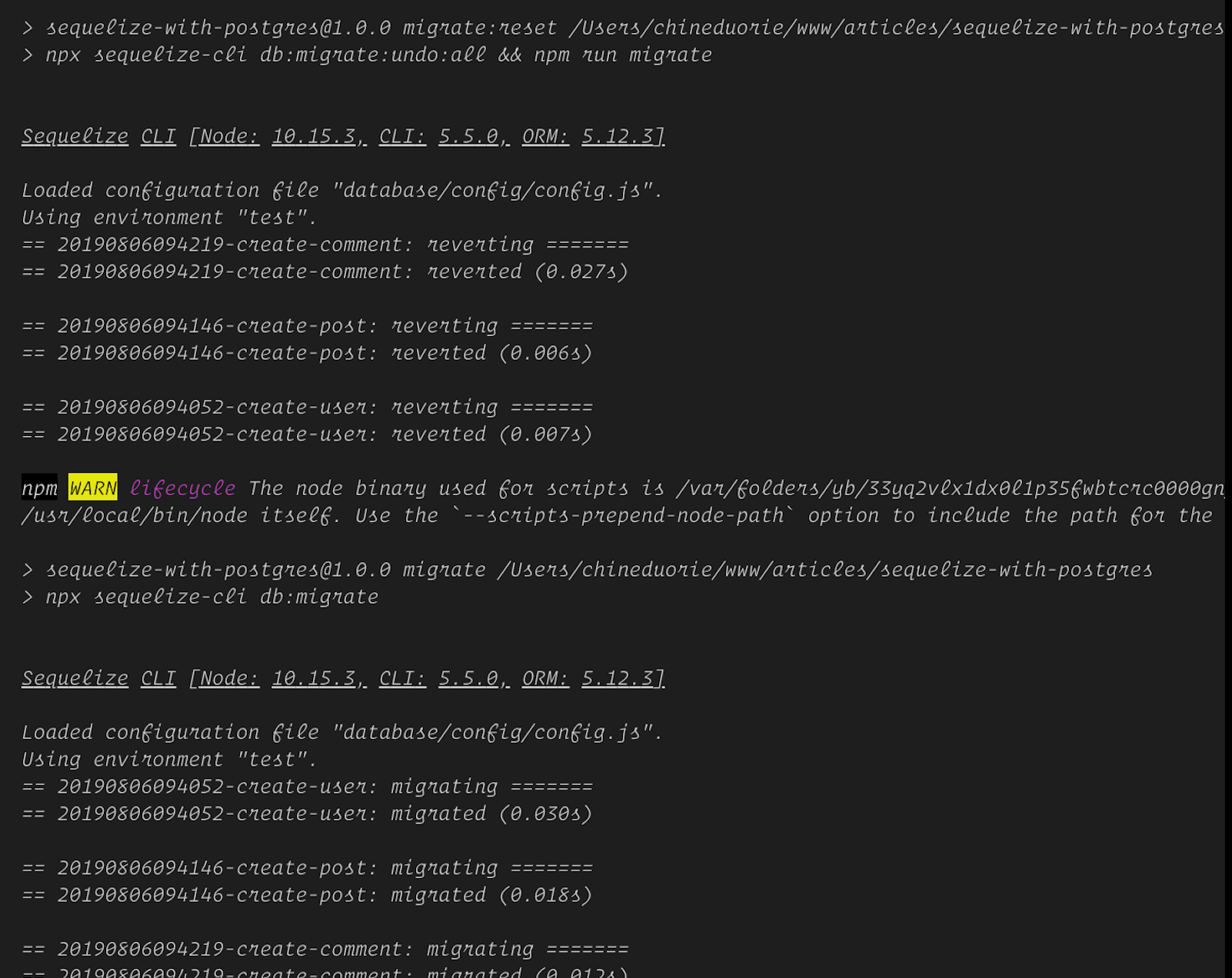 仔細觀察上面的螢幕截圖,您會注意到一行 _`using environment "test"`_ 表示 `cross-env` 已更改了 `NODE_ENV`。 **最後一步 - 測試路由/端點** 現在,讓我們開始為端點編寫測試。在測試目錄中建立一個名為routes.test.js的文件 ``` touch tests/routes.test.js ``` - **測試建立後端點** 將以下程式碼複製到“tests/routes.test.js”中: ``` const request = require('supertest') const app = require('../server') describe('Post Endpoints', () => { it('should create a new post', async () => { const res = await request(app) .post('/api/posts') .send({ userId: 1, title: 'test is cool', }) expect(res.statusCode).toEqual(201) expect(res.body).toHaveProperty('post') }) }) ``` - `describe` 函數用於將相關測試分組在一起 - `it` 是執行實際測試的 `test` 函數的別名。 -“expect”函數使用一組“matcher”函數測試值。 請造訪 [Jest 文件](https://jestjs.io/docs/en/api.html) 以取得 jest 函數的完整清單和詳細資訊。 現在,執行測試 ``` npm test ``` 輸出如下圖所示: 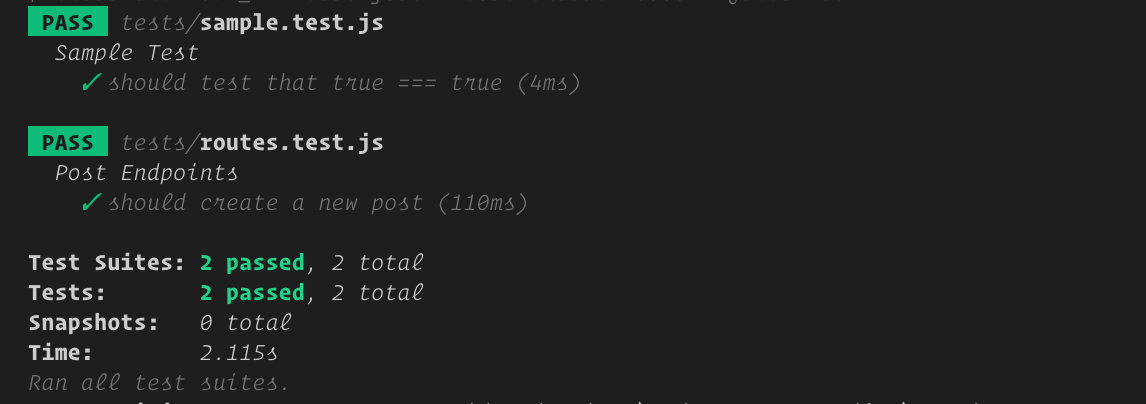 有關所有端點測試的完整程式碼,請檢查[儲存庫](https://github.com/oriechinedu/sequelize-with-postgres-tutorial/blob/master/tests/routes.test.js)。 ### 結論 我們已經能夠完成為與資料庫互動的 API 端點編寫測試的過程。在本文的最後部分,我將撰寫有關將 CI/CD 和程式碼覆蓋工具整合到測試環境的文章。在那之前請繼續關注。 如果您對改進文章有任何疑問或建議,請隨時與我聯繫。您也可以透過下面的評論部分分享您的想法。謝謝! _本文最初發表在我的[部落格](https://www.oriechinedu.com/posts/testing-nodejs-express-api-with-jest-and-supertest/)_ --- 原文出處:https://dev.to/nedsoft/testing-nodejs-express-api-with-jest-and-supertest-1km6
我們很高興地宣布 Supabase Auth 的四項新功能: 1. 身份連結 2. 會話控制 3. 密碼外洩保護 4. 帶有 Postgres 函數的 Auth Hooks {% 嵌入 https://youtu.be/LF8GABnAFyE %} ## 身份連結 當使用者登入時,系統會使用身份驗證方法和登入提供者建立身分。從歷史上看,如果身分與使用者共享相同的經過驗證的電子郵件,[Supabase Auth](https://supabase.com/docs/guides/auth) 會自動將身分連結到使用者。這可以方便地刪除重複的用戶帳戶。然而,一些開發人員還需要靈活地連結不共享相同電子郵件的帳戶。 今天,我們推出身份連結,開發人員可以使用它手動連結兩個單獨的身份。我們為開發人員新增了兩個新端點來管理身分連結流程: 使用者登入後,使用「linkIdentity()」[連結 OAuth 身分:](https://supabase.com/docs/reference/javascript/auth-linkidentity) ``` const { data, error } = await supabase.auth.linkIdentity({ provider: 'google', }) ``` 使用 `unlinkIdentity()` 來[取消連結身分](https://supabase.com/docs/reference/javascript/auth-unlinkidentity): ``` // retrieve all identities linked to a user const { data: { identities }, } = await supabase.auth.getUserIdentities() // find the google identity linked to the user const googleIdentity = identities.find(({ provider }) => provider === 'google') // unlink the google identity from the user const { data, error } = await supabase.auth.unlinkIdentity(googleIdentity) ``` 目前,這些方法支援連結 OAuth 身分。要將電子郵件或電話身分連結到用戶,您可以使用 [updateUser()](https://supabase.com/blog/supabase-auth-identity-linking-hooks#:~:text=can%20use% 20the -,updateUser(),-method.)方法。 預設情況下禁用手動連結。您可以在[儀表板驗證設定](https://supabase.com/dashboard/project/_/settings/auth) 中為您的專案啟用它。 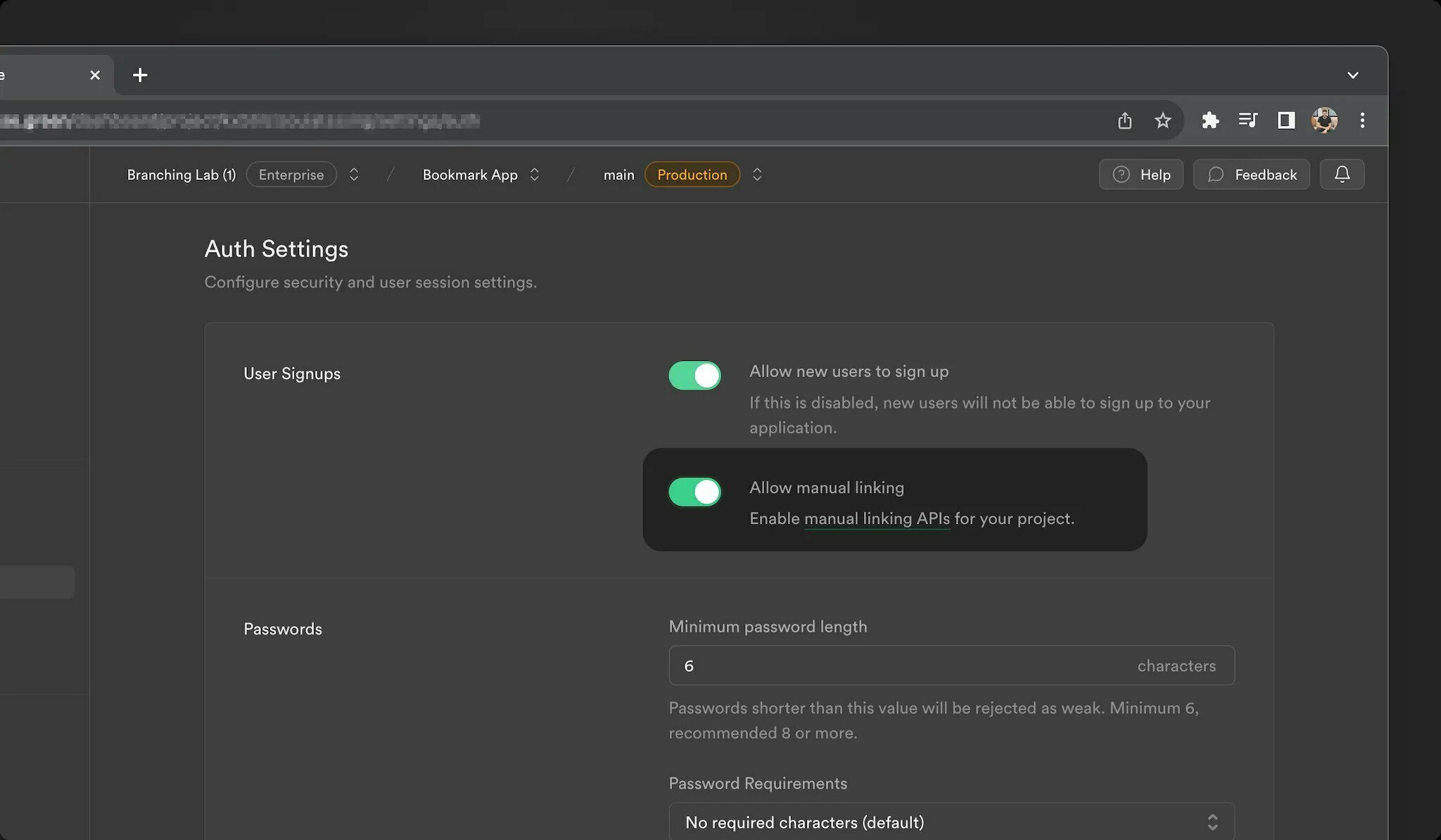 > 有關更多訊息,請參閱[身份連結文件](https://supabase.com/docs/guides/auth/auth-identity-linking)。 ## 會話控制 Supabase Auth 從使用者登入應用程式那一刻起管理整個會話生命週期。這涉及以下步驟: 1. 為使用者建立會話。 2. 刷新會話以使其保持活動狀態。 3. 過期或登出時撤銷會話。 對於想要更好地控制使用者會話的開發人員,我們公開了 3 個新設定: - **時間盒使用者會話:** 強制使用者在一段時間間隔後再次登入。 - **不活動逾時:** 如果使用者在一段時間內不活動,則強制使用者重新登入。 - **每個使用者單一會話:** 將使用者限制為單一會話。保留最近的活動會話,並終止所有其他會話。 這些會話控制設定在專業版及以上版本中可用。 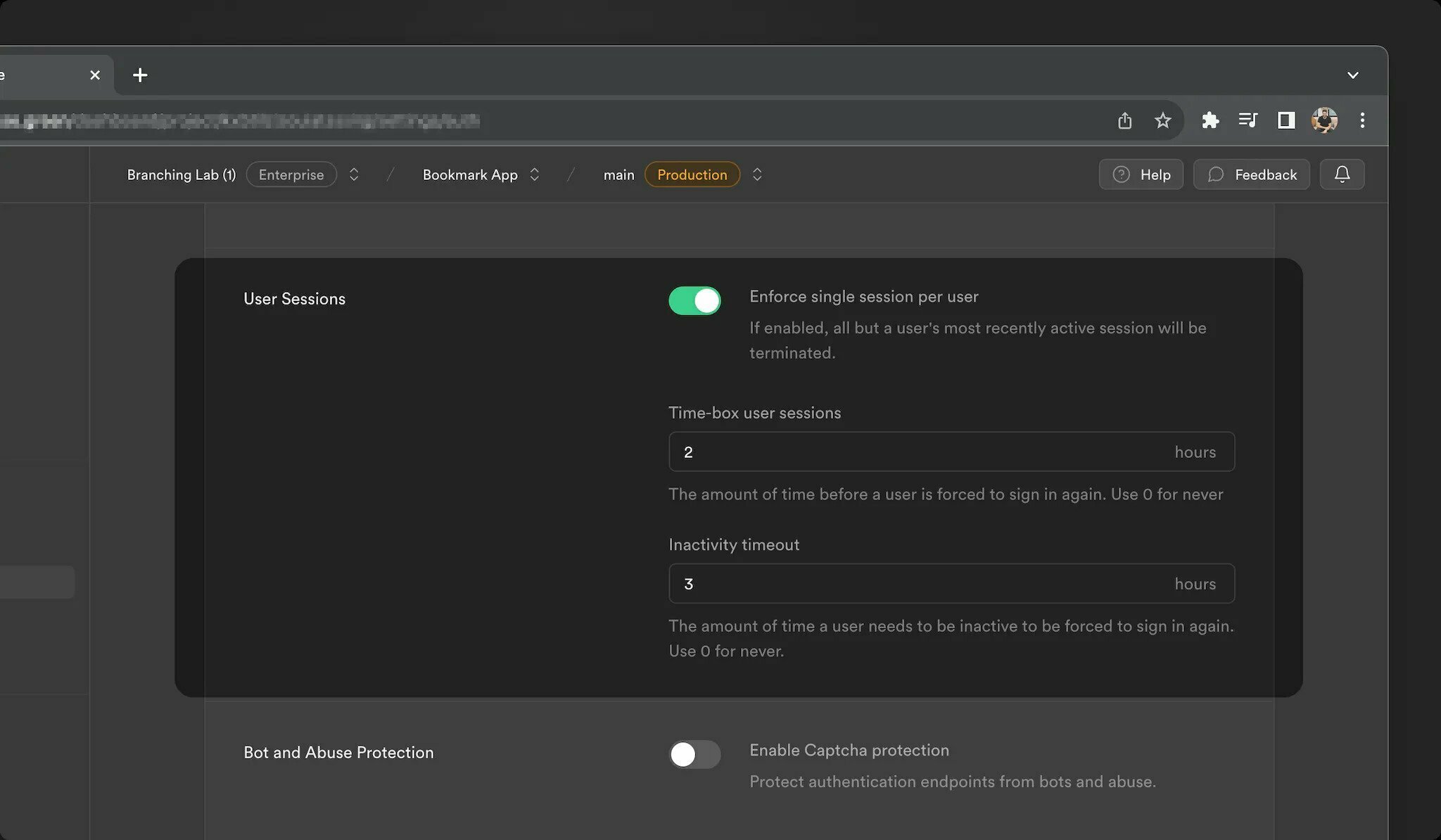 > 有關更多訊息,請參閱[會話管理文件](https://supabase.com/docs/guides/auth/sessions)。 ## 密碼外洩保護 由於常見的使用者行為(例如選擇可猜測的密碼或在不同平台上重複使用密碼),密碼本質上可能是不安全的。 儘管 OAuth 和 magiclinks 更安全,但我們認識到密碼將繼續存在。我們希望讓用戶不易陷入潛在的陷阱。為了實現這一目標,我們在 Supabase Auth 中整合了 [HaveIBeenPwned.org](https://haveibeenpwned.com/) _Pwned Passwords API_,以防止使用者使用洩漏的密碼。 > **去圖書館** ℹ️ 我們開源了一個 Go 函式庫,用於與我們在身分驗證伺服器中使用的 [HaveIBeenPwned.org](http://haveibeenpwned.org/) Pwned 密碼 API 互動。查看 [存儲庫](https://github.com/supabase/hibp) 並隨時貢獻! 作為附加步驟,我們新增了為您的使用者指定密碼要求的功能。這可以透過[儀表板:](https://supabase.com/dashboard/project/_/settings/auth) 中專案的身份驗證設定進行配置  > 請參閱[密碼文件](https://supabase.com/docs/guides/auth/passwords) 以了解更多資訊。 ## 驗證掛鉤 我們收到了大量回饋,詢問如何自訂 Auth,例如: - 將自訂聲明新增至存取權杖 JWT - 多次嘗試 MFA 驗證失敗後註銷用戶 - 對密碼驗證嘗試套用自訂規則 我們的目標是保持簡單、無縫的 Supabase Auth 體驗。對於大多數開發人員來說,它應該可以輕鬆工作,而無需自訂。但是,認識到應用程式的多樣性,您現在可以透過 Auth Hook 擴展標準 Auth 功能。 Auth Hooks 只是 Postgres 函數,它們在 Auth 生命週期的關鍵點同步執行,以更改操作的結果。 例如,要使用 Auth Hooks 自訂 JWT 聲明,您可以建立一個 Postgres 函數,該函數接受第一個參數中的 JWT 聲明並傳回您希望 Supabase Auth 使用的 JWT。 假設您正在建立一個遊戲化應用程式,並且希望將用戶的層級作為自訂聲明附加到 JWT: ``` create function custom_access_token_hook(event jsonb) returns jsonb language plpgsql as $$ declare user_level jsonb; begin -- fetch the current user's level select to_jsonb(level) into user_level from profiles where user_id = event->>'user_id'::uuid; -- change the event.claims.level return jsonb_set( event, '{claims,level}', user_level); end; $$ ``` 在資料庫中建立函數後,您只需使用 Supabase Auth 註冊它:  目前,您可以為流程中的以下點註冊 Auth Hook: - **自訂存取權杖:** 每次產生新的 JWT 時都會呼叫。 - **MFA 驗證嘗試:** 每次驗證 MFA 因素時都會呼叫,從而可以更好地控制檢測和阻止嘗試。 - **密碼驗證嘗試:** 每次使用密碼登入使用者時都會呼叫,從而可以更好地控制使用者帳戶的安全性。 如果編寫 PL/pgSQL 函數不是您的強項,您始終可以使用 [pg_net](https://supabase.com/docs/guides/database/extensions/pg_net) 向後端 API 發送請求,或使用[plv8]( https://supabase.com/docs/guides/database/extensions/plv8) 透過用JavaScript 編寫函數來更輕鬆地操作JSON。 Auth Hooks 今天可供自架,並將於下個月推出到該平台。如果您需要盡快存取,請透過[支援](https://supabase.help/)與我們聯繫! 那不是全部! Postgres 函數並不是寫鉤子的唯一方法。 Supabase 是 [Standard Webhooks](https://www.standardwebhooks.com/) 的創始貢獻者,這是一組關於輕鬆、安全、可靠地發送和接收 Webhook 的開源工具和指南。當然,Auth Hooks 將在 2024 年第一季支援 Webhooks。 ## 還有一件事… 如果您從一開始就關注我們(https://supabase.com/blog/supabase-auth),您就會知道Supabase Auth 是透過分叉[Netlify 的GoTrue 伺服器](https://github.com)開始的/netlify/gotrue)。從那時起,發生了很多變化,我們已經偏離了上游儲存庫。在這個階段,將專案重新命名為其他名稱是有意義的(提示鼓聲)-Auth。 這僅僅意味著儲存庫將從使用“gotrue”重新命名為“auth”。但別擔心! Docker 映像和庫(如“@supabase/gotrue-js”)將繼續發布,只要當前 v2 版本受支持,您就可以互換使用“@supabase/auth-js”。所有類別和方法都保持不變。這裡沒有重大變化! ## 結論 感謝您閱讀到最後!我們希望您喜歡第 X 週發布的 Supabase Auth 更新:身分連結、會話控制、洩露密碼保護和帶有 Postgres 功能的 Auth Hooks。 我們期待看到您使用這些新功能建立的內容,當然還有您的回饋意見,以使它們變得更好。 ## 更多發布第 X 週 - [第 1 天 - Supabase Studio 更新:AI 助理與使用者模擬](https://supabase.com/blog/studio-introducing-assistant) - [第 2 天 - Edge Functions:節點和本機 npm 相容性 ](https://supabase.com/blog/edge-functions-node-npm) -[第 3 天 - 介紹 Supabase Branching,這是一個針對每個拉取請求的 Postgres 資料庫](https://supabase.com/blog/supabase-branching) - [Postgres語言伺服器:實作解析器](https://supabase.com/blog/postgres-language-server-implementing-parser) - [Supabase 專輯](https://www.youtube.com/watch?v=r1POD-IdG-I) - [Supabase 啟動週 X 黑客松](https://supabase.com/blog/supabase-hackathon-lwx) - [啟動週 X 社群聚會](https://supabase.com/blog/community-meetups-lwx) --- 原文出處:https://dev.to/supabase/supabase-auth-identity-linking-hooks-and-haveibeenpwned-integration-19e1
我們很高興地宣布,[Edge Functions](https://supabase.com/docs/guides/functions) 現在原生支援 npm 模組和 Node 內建 API。您可以將數百萬個流行、常用的 npm 模組直接匯入 Edge Functions 中。 `從 'npm:drizzle-orm/node-postgres' 導入 { drizzle }` ## 將現有 Node 應用程式遷移到 Edge Functions 您可以透過最少的變更將現有的 Node 應用程式遷移到 Supabase Edge Functions。 我們建立了一個示範來展示如何遷移使用 Express、Node Postgres 和 Drizzle 的 Node 應用程式。有關在 Edge Functions 中使用 npm 模組和 Node 內建程式的更多訊息,請參閱[管理依賴項指南](https://supabase.com/docs/guides/functions/import-maps)。 {% 嵌入 https://youtu.be/eCbiywoDORw %} **npm 模組的底層運作原理** 我們執行一個開源 Deno 伺服器來託管 Edge Functions,稱為 [Supabase Edge Runtime](https://supabase.com/blog/edge-runtime-self-hosted-deno-functions)。此自訂版本可協助我們保持 Edge Functions 以相同的方式運作,無論部署在何處 - 在我們的託管平台上、在本地開發中還是在您的自託管環境中。 加入 npm 支援時最大的挑戰是找到適用於所有環境的方法。我們希望保持工作流程接近 Deno CLI 體驗。應該可以直接在原始程式碼中導入 npm 模組,而無需額外的建置步驟。 部署函數時,我們將其模組圖序列化為單一檔案格式([eszip](https://github.com/denoland/eszip))。在託管環境中,所有模組引用都會從 eszip 中載入。這可以防止獲取模組時出現任何額外的延遲以及模組依賴關係之間的潛在衝突。 我們也在本機和自架環境中使用了 eszip 模組載入器,因此我們只需要為所有環境實作一種模組載入策略。作為本地開發的另一個好處,此方法避免了與使用者係統中安裝的 npm 模組的潛在衝突,因為 Edge Function 的 npm 模組是獨立於 eszip 中的。 [重構模組載入器](https://github.com/supabase/edge-runtime/pull/223)修正了一些其他錯誤,例如[邊緣函數錯誤](https://github.com/supabase/cli /issues/1584#issuecomment-1848799355) 當專案中已存在`deno.lock` 檔案時。 ## 您要求的其他一些東西... **區域呼叫** 現在,您可以選擇在執行邊緣函數時指定區域(也許我們將來應該更改名稱)。通常,邊緣函數在最靠近呼叫函數的使用者的區域中執行。但是,有時您希望在靠近 Postgres 資料庫或其他第 3 方 API 的地方執行它,以獲得最佳效能。 功能仍然部署到所有區域。但是,在呼叫過程中,您可以提供“x-region”標頭以將執行限制在特定區域。 **捲曲** ``` # https://supabase.com/docs/guides/functions/deploy#invoking-remote-functions curl --request POST 'https://<project_ref>.supabase.co/functions/v1/hello-world' \ --header 'Authorization: Bearer ANON_KEY' \ --header 'Content-Type: application/json' \ --header 'x-region: eu-west-3' \ --data '{ "name":"Functions" }' ``` **JavaScript** ``` // https://supabase.com/docs/reference/javascript/installing import { createClient } from '@supabase/supabase-js' // Create a single supabase client for interacting with your database const supabase = createClient('https://xyzcompany.supabase.co', 'public-anon-key') // https://supabase.com/docs/reference/javascript/functions-invoke const { data, error } = await supabase.functions.invoke('hello-world', { body: { name: 'Functions' }, headers: { 'x-region': 'eu-west-3' }, }) ``` > ℹ️查看[區域呼叫指南](https://supabase.com/docs/guides/functions/regional-inspiration)以了解更多詳情。 **更好的指標** 我們在 [Supabase 儀表板](https://supabase.com/dashboard/project/_/functions) 的 Edge Functions 部分中加入了更多指標:它現在顯示 CPU 時間和使用的記憶體。我們也按 HTTP 狀態碼細分了呼叫。 這些變更可協助您發現邊緣功能的任何問題並採取行動。 > ℹ️ 請參閱 Edge Functions 的[日誌記錄和指標指南](https://supabase.com/docs/guides/functions/debugging) 以了解更多資訊。  **使用 Sentry 追蹤錯誤** 我們 Sentry 的朋友最近發布了官方的 [Sentry SDK for Deno](https://deno.land/x/[email protected])。有了這個,現在可以輕鬆追蹤 Sentry 邊緣函數中的錯誤和異常。 以下是一個簡單的範例,說明如何處理函數中的異常並將其傳送到 Sentry。 ``` import * as Sentry from 'https://deno.land/x/sentry/index.mjs' Sentry.init({ dsn: _DSN_, integrations: [], // Performance Monitoring tracesSampleRate: 1.0, // Set sampling rate for profiling - this is relative to tracesSampleRate profilesSampleRate: 1.0, }) // Set region and execution_id as custom tags Sentry.setTag('region', Deno.env.get('SB_REGION')) Sentry.setTag('execution_id', Deno.env.get('SB_EXECUTION_ID')) Deno.serve(async (req) => { try { const { name } = await req.json() const data = { message: `Hello ${name}!`, } return new Response(JSON.stringify(data), { headers: { 'Content-Type': 'application/json' } }) } catch (e) { Sentry.captureException(e) return new Response(JSON.stringify({ msg: 'error' }), { status: 500, headers: { 'Content-Type': 'application/json' }, }) } }) ``` ## 下一步是什麼 NPM 支援是 Edge Functions 最受歡迎的功能之一。如果您之前因缺乏支援而無法使用 Edge Functions,我們希望此更新能夠吸引您[再試一次](https://supabase.com/dashboard/project/_/functions)。如果您遇到任何問題,我們只需[一個支援請求](https://supabase.help/)。 對於現有的 Edge Functions 用戶來說,區域呼叫、更好的指標和錯誤處理只是接下來會發生的事情的一瞥。我們繼續迭代平台穩定性並對邊緣功能可以使用的資源設定自訂限制。請留意新的一年的另一篇文章。 ## 更多發布第 X 週 - [第 1 天 - Supabase Studio 更新:AI 助理與使用者模擬](https://supabase.com/blog/studio-introducing-assistant) - [pg_graphql:現在支援 Postgres 函式](https://supabase.com/blog/pg-graphql-postgres-functions) - [Postgres語言伺服器:實作解析器](https://supabase.com/blog/postgres-language-server-implementing-parser) - [Supabase 設計如何運作](https://supabase.com/blog/how-design-works-at-supabase) - [Supabase 專輯](https://www.youtube.com/watch?v=r1POD-IdG-I) - [Supabase 啟動週 X 黑客松](https://supabase.com/blog/supabase-hackathon-lwx) - [啟動週 X 社群聚會](https://supabase.com/blog/community-meetups-lwx) --- 原文出處:https://dev.to/supabase/edge-functions-node-and-native-npm-compatibility-77f
# 傳統搜尋的問題 傳統方法是將資料從一個容器提升並轉移到另一個容器。在很多情況下這是一個大問題。建立倒排索引廣泛應用於傳統搜尋引擎中,以實現快速資訊檢索。然而,這種方法的計算成本可能很高,特別是在辨識新資料並將其整合到這些索引中時。隨著業務的發展和資料變得更加複雜和龐大,這些傳統系統往往難以跟上。 此外,企業現在正以前所未有的速度產生新的資料類型,轉向分散式、基於雲端的資訊池的轉變加劇了這些困難。 傳統的企業資訊存取系統依賴定期更新的倒排索引,較不適合這種動態、異質的資料環境。它們無法輕鬆適應新資料類型的持續湧入或基於雲端的資訊系統的分散性。 這會導致資料檢索效率低下和延遲,從而阻礙組織內的決策和營運工作流程。  _Swirl 3.0 透過連接到各種資料來源並同時搜尋它們,為這個問題提供了一個簡單而優雅的解決方案。_ # 漩渦 3.0 功能 {% 嵌入 https://www.youtube.com/watch?v=nA8e0kMEDxs %} Swirl 建構在 Python Django 堆疊上,並提供了一個名為 Galaxy UI 的使用者友善介面。它可以在 Docker 中執行,也可以作為 Microsoft Azure 中的託管服務執行。 Swirl 使用戶能夠利用人工智慧驅動的重新排名功能,同時維護資料安全和隱私。 Swirl 的搜尋技術改變了企業跨應用程式和資料儲存存取資訊的方式。透過利用先進的大型語言模型,Swirl 可以快速篩選來自多個來源(例如 Salesforce 和 Microsoft365)的資料,為使用者提供最相關的結果和見解。  ## Swirl 方法的好處是顯而易見的: - 使用者收到根據其特定需求量身定制的微調搜尋結果。 - 無需移動資料或重新索引內容的麻煩。 ## 關鍵點:  - Swirl 使用 LLM 技術對來自不同來源(如資料孤島、Salesforce、Microsoft 等)的搜尋結果進行分析和排名。 - 漩渦搜尋增強了近乎即時的相關性排名,並將目標查詢的結果置於上下文中。 - 該系統允許針對特定學科領域定制法學碩士,用戶回饋證實了 Swirl 相關性排名的有效性。 - Swirl 最大限度地減少了重新索引的需要,消除了搜尋基礎設施的內容移動,並有效地管理相關性排名和重複資料刪除。 ## 連接器:  您可以在我們的 GitHub 頁面上找到可用連接器清單的廣泛概述。如果您希望按需並優先建立任何內容,請透過「[email protected]」聯絡 Swirl 支援團隊。 # 內部工作和用例 Swirl 整合了先進的內容處理和分析。它使用 API(應用程式介面)來定位和排名多個來源的內容,並透過控制項來增強某些內容。 Swirl 的框架允許快速尋找資訊並將其串流傳輸到各種基於搜尋的應用程式的資料管道中,例如檢索增強生成 (RAG) 和微調大型語言模型。 它提供對組織資料孤島內的資訊的存取,解決與企業搜尋解決方案相關的傳統成本、複雜性和開發問題。 Swirl 採用 OAuth2 等基於標準的身份驗證機制來消除權限和安全性問題。 隨著組織的發展和數位資產的多樣化,像 Swirl 這樣的工具變得不可或缺。請繼續關注我們探索人工智慧驅動的解決方案如何塑造資訊存取和管理的未來。 # Swirl 是開源的 Swirl 是一個開源搜尋平台。這對您意味著什麼: {% 嵌入 https://github.com/swirlai/swirl-search %} - 它是一個自託管、非限制性軟體,具有寬鬆的 Apache 2.0 授權。 - 軟體開發人員可以為專案的開發做出貢獻,深入了解搜尋生態系統,同時深入了解 Swirl。 - 如果您想了解有關 Swirl 的更多訊息,請加入我們的 Slack 社區,進行更多討論。 {% cta https://join.slack.com/t/swirlmetasearch/shared_invite/zt-1qk7q02eo-kpqFAbiZJGOdqgYVvR1sfw %} 加入 Slack {% endcta %} --- 原文出處:https://dev.to/swirl/adding-ai-to-your-enterprise-with-swirl-search-smarter-better-and-faster-4f9b
隨著每個人和他們的貓為他們的應用程式建立一個“2023 Wrapped”,我無法阻止,不得不為這個很棒的 dev.to 社區建立一個小型開源應用程式 🥰 造訪[devto-wrapped.sliplane.app](https://devto-wrapped.sliplane.app/?username=code42cate),輸入您的用戶名,看看您作為dev.to 的作者在2023 年取得了什麼成就! **無需 API 金鑰或登入!** 這是我在 dev.to 的第一年的經驗: 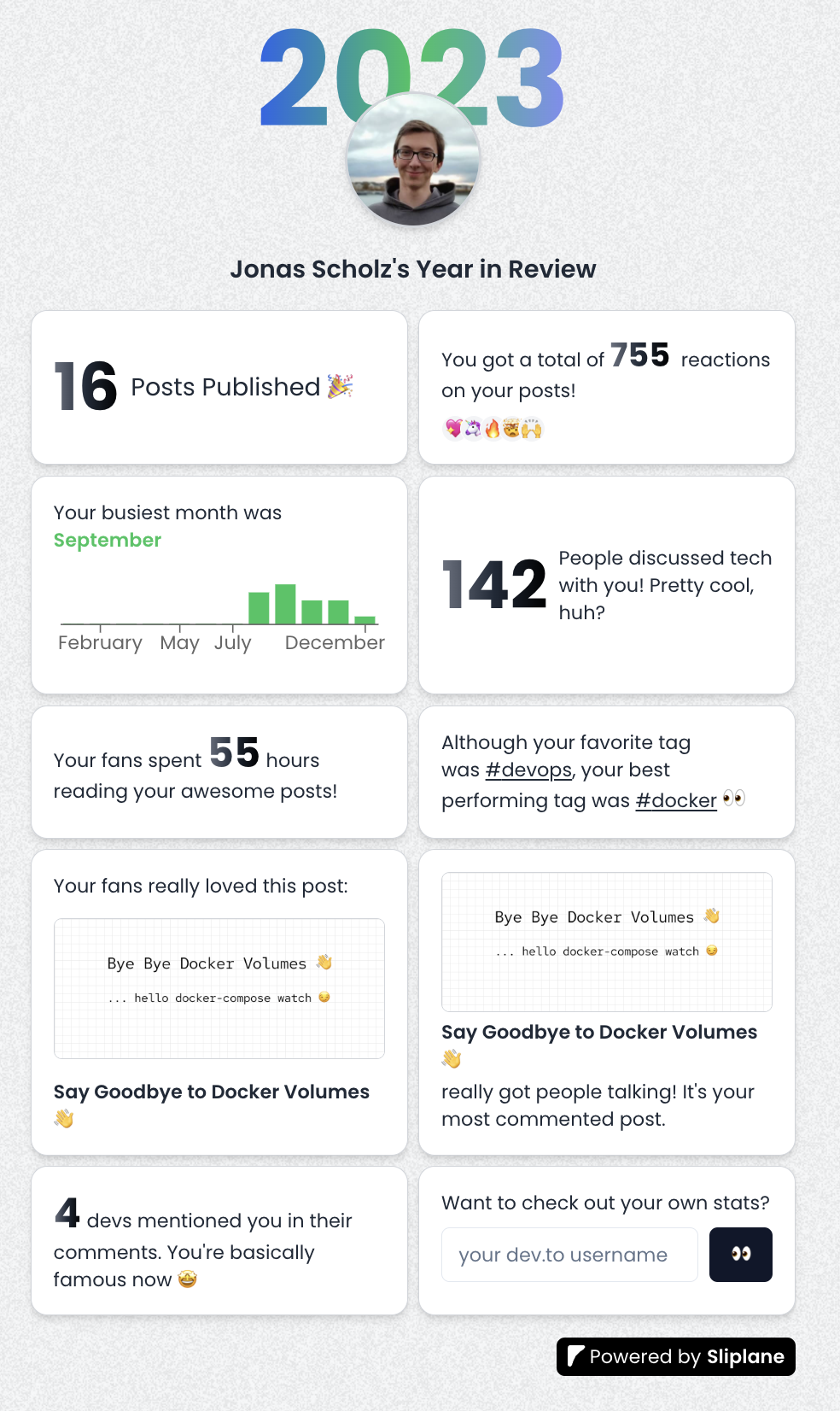 PS:在評論中分享你的截圖,我會隨機挑選一個人,給他們發送一些免費的開發者貼紙作為提前的聖誕禮物🎅🎁 不管怎樣,你來這裡是為了學習一些東西,所以讓我們深入研究程式碼吧! ## 教程 建立這個小應用程式的速度對我來說至關重要,因此我決定使用我最近使用的自己的[Hackathon Starter Template](https://dev.to/code42cate/how-to-win-any-hackathon -3i99)寫了關於。我剝離了一些我不需要的功能,從而產生了一個非常精簡的 monorepo: 1.Next.js + Tailwind 2. ShadcnUI 你可以在這個[Github儲存庫](https://github.com/Code42Cate/devto-wrapped)中看到所有內容 ### 設定 如果您想長期關注並親自嘗試一下,請按照以下步驟操作: ``` # Clone repository git clone https://github.com/Code42Cate/devto-wrapped.git # Install dependencies pnpm install # Start app pnpm run dev --filter web ``` 該應用程式現在應該從 http://localhost:3000 啟動。如果它不起作用,請在評論中告訴我! ### 存取 dev.to 資料 這個小應用程式最有趣的部分可能是我們如何存取 dev.to 資料。雖然有幾種方法可以解決這個問題,但我有一些要求幫助我決定前進的方向: 1. 不抓取 - 花費太長時間,我希望資料可用 <1 秒 2. 僅公開資料 - 我不想向使用者詢問 API 金鑰或使用我自己的 3.不需要資料庫-我很懶,想避免無用的複雜性 這為我們提供了兩種可能的獲取資料的方式: 1. [記錄和未經驗證的 API 呼叫](https://developers.forem.com/api/v1) 2. 即使您未登錄,dev.to 網站也會進行未記錄的公開 API 呼叫 考慮到這兩種獲取資料的方式,我們基本上可以獲得 3 類資料: 1.使用API公開使用者資訊:`dev.to/api/users/by_username` 2. 使用 `dev.to/search/feed_content` API 和 `class_name=Article` 發布帖子 3. 包含 `dev.to/search/feed_content` 和 `class_name=Comment&search_fields=xyz` 的搜尋查詢的評論 這些 API 呼叫都是在伺服器端進行的,以加快請求速度,可以在「/apps/web/actions/api.ts」中找到。由於這只是組合在一起,因此功能相當簡單,錯誤處理也非常少: ``` export async function getUserdata(username: string): Promise<User | undefined> { const res = await fetch( `https://dev.to/api/users/by_username?url=${username}`, ); if (!res.ok) { return undefined; } const data = await res.json(); return data as User; } ``` 對於這個用例來說,這很好,但如果您不希望用戶發生意外崩潰,請記住正確捕獲異常並驗證您的類型😵 ### 計算統計資料 計算統計資料出奇地容易,主要是因為我們的資料非常小。即使你每天發帖,我們只會瀏覽 365 個帖子。迭代 365 個專案的陣列幾乎不需要時間,這給了我們很大的空間來完成工作,而無需關心效能!您在頁面上看到的每個統計資料都是在單一函數中計算的。以「總反應」為例: ``` const reactionsCount = posts?.reduce( (acc: number, post: Article) => acc + post.public_reactions_count, 0, ); ``` 我們需要做的就是檢查帖子陣列並總結每個帖子的“public_reactions_count”數量。田田,完成! 即使對於更複雜的,它也只不過是一個嵌套循環: ``` const postsPerTag: Record<string, number> = posts?.reduce( (acc: Record<string, number>, post: Article) => { post.tag_list.forEach((tag) => { acc[tag] = acc[tag] ? acc[tag] + 1 : 1; }); return acc; }, {} as Record<string, number>, ); ``` ### 前端 由於這是使用 Next.js 建構的,因此所有內容都可以在「/apps/web/app/page.tsx」檔案中找到。 在元件的頂部,您可以先看到我們如何取得資料並檢查使用者是否存在或是否有足夠的資料來顯示任何內容: ``` const user = await getUserdata(username); if (!user) { return <EmptyUser message="This user could not be found 🫠" />; } const stats = await getStats(user.id.toString()); const mentionsCount = await getMentionedCommentCount(user.username); if (stats.postCount === 0) { return <EmptyUser message="This user has no posts 🫠" />; } ``` 不同的統計資料都是它們自己的元件,它們是 CSS 網格的一部分,看起來像這樣(縮短) ``` <div className="grid grid-cols-2 gap-2 w-full text-sm text-gray-800"> <PublishedPostsCard count={stats.postCount} /> <ReactionsCard count={stats.reactionsCount} /> <BusiestMonthCard busiestMonth={stats.busiestMonth} postsPerMonth={stats.postsPerMonth} /> <CommentsCard count={stats.commentsCount} /> <ReadingTimeCard readingTime={stats.readingTime} totalEstimatedReadingTime={stats.totalEstimatedReadingTime} /> </div> ``` 這些元件都是「啞」的,這意味著它們只負責顯示資料。他們不獲取或計算任何東西。其中大多數都非常簡單,就像這張「最佳貼文」卡: ``` import Image from "next/image"; import { Article } from "@/actions/api"; export default function BestPostCard({ post, coverImage, }: { post: Article; coverImage: string; }) { return ( <div className="flex w-full flex-col justify-between gap-2 rounded-xl border border-gray-300 bg-white p-4 shadow-md"> Your fans really loved this post: <br /> <Image src={coverImage} alt={post.title} width={500} height={500} className="rounded-md border border-gray-300" /> <a className="font-semibold underline-offset-2" href={`https://dev.to${post.path}`} > {post.title} </a> </div> ); } ``` ### 部署 為了部署我們的應用程式,我們將對其進行dockerize,然後使用Sliplane(稍微有偏見,我是聯合創始人!)將其託管在我們自己的[Hetzner Cloud](https://www.hetzner.com /cloud) 伺服器上。我在[上一篇部落格文章](https://dev.to/sliplane/understanding-nextjs-docker-images-2g08)中介紹瞭如何對Next.js 應用程式進行docker 化,這基本上是相同的,只是做了一些小的更改適應我的 Turborepo 設定:) ``` # src Dockerfile: https://github.com/vercel/turbo/blob/main/examples/with-docker/apps/web/Dockerfile FROM node:18-alpine AS alpine # setup pnpm on the alpine base FROM alpine as base ENV PNPM_HOME="/pnpm" ENV PATH="$PNPM_HOME:$PATH" RUN corepack enable RUN pnpm install turbo --global FROM base AS builder # Check https://github.com/nodejs/docker-node/tree/b4117f9333da4138b03a546ec926ef50a31506c3#nodealpine to understand why libc6-compat might be needed. RUN apk add --no-cache libc6-compat RUN apk update # Set working directory WORKDIR /app COPY . . RUN turbo prune --scope=web --docker # Add lockfile and package.json's of isolated subworkspace FROM base AS installer RUN apk add --no-cache libc6-compat RUN apk update WORKDIR /app # First install the dependencies (as they change less often) COPY .gitignore .gitignore COPY --from=builder /app/out/json/ . COPY --from=builder /app/out/pnpm-lock.yaml ./pnpm-lock.yaml COPY --from=builder /app/out/pnpm-workspace.yaml ./pnpm-workspace.yaml RUN pnpm install # Build the project COPY --from=builder /app/out/full/ . COPY turbo.json turbo.json RUN turbo run build --filter=web # use alpine as the thinest image FROM alpine AS runner WORKDIR /app # Don't run production as root RUN addgroup --system --gid 1001 nodejs RUN adduser --system --uid 1001 nextjs USER nextjs COPY --from=installer /app/apps/web/next.config.js . COPY --from=installer /app/apps/web/package.json . # Automatically leverage output traces to reduce image size # https://nextjs.org/docs/advanced-features/output-file-tracing COPY --from=installer --chown=nextjs:nodejs /app/apps/web/.next/standalone ./ COPY --from=installer --chown=nextjs:nodejs /app/apps/web/.next/static ./apps/web/.next/static COPY --from=installer --chown=nextjs:nodejs /app/apps/web/public ./apps/web/public CMD node apps/web/server.js ``` 在 Docker 化並推送到 Github 儲存庫後,我們需要做的就是在 Sliplane 中建立一個新服務並選擇我們想要託管的伺服器。我已經有一台伺服器,在上面執行一些小型專案,所以我只使用該伺服器: 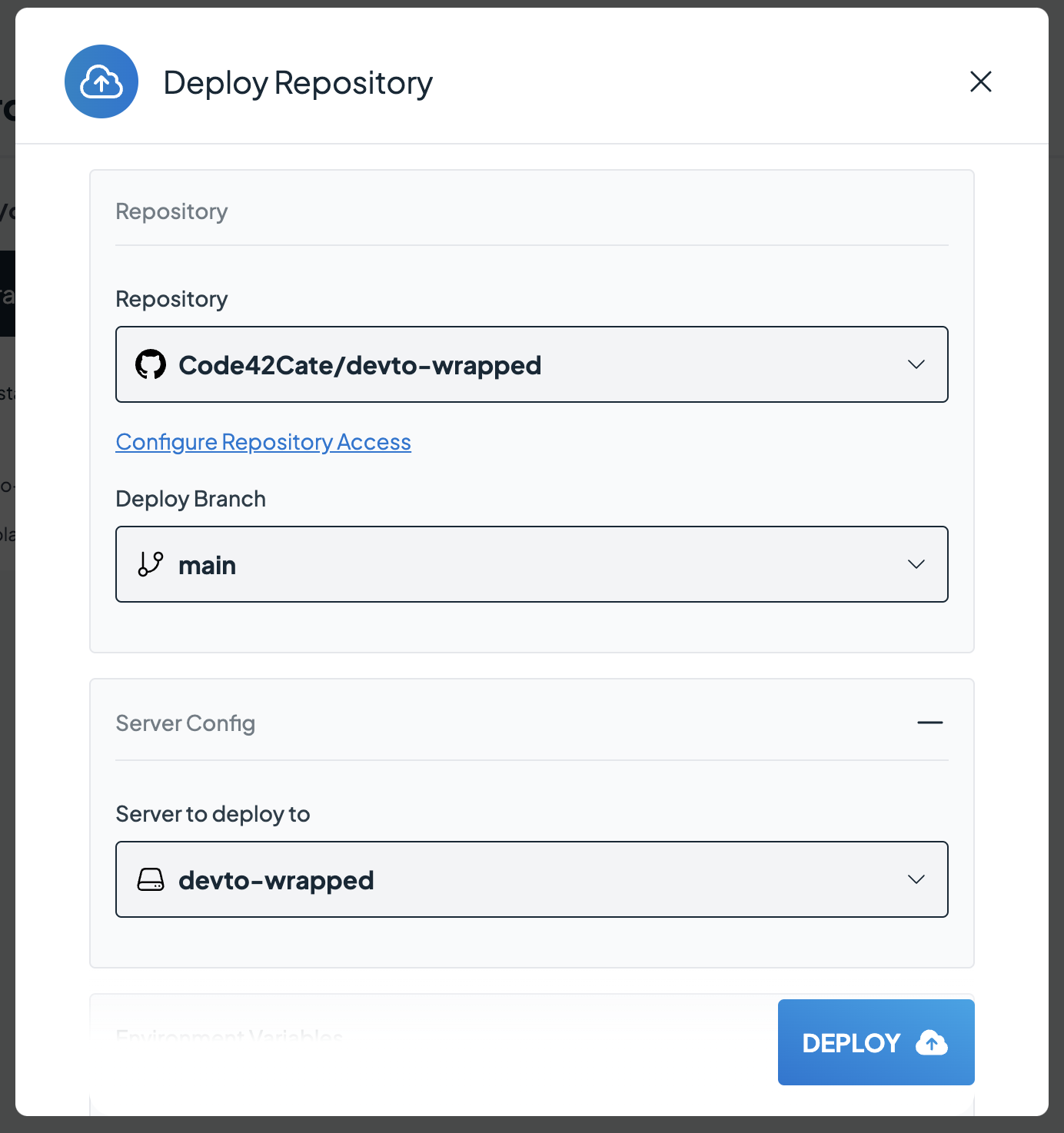 點擊「部署」後,需要幾分鐘時間來建置並啟動我們的 Docker 映像。可以在日誌檢視器中監視進度: 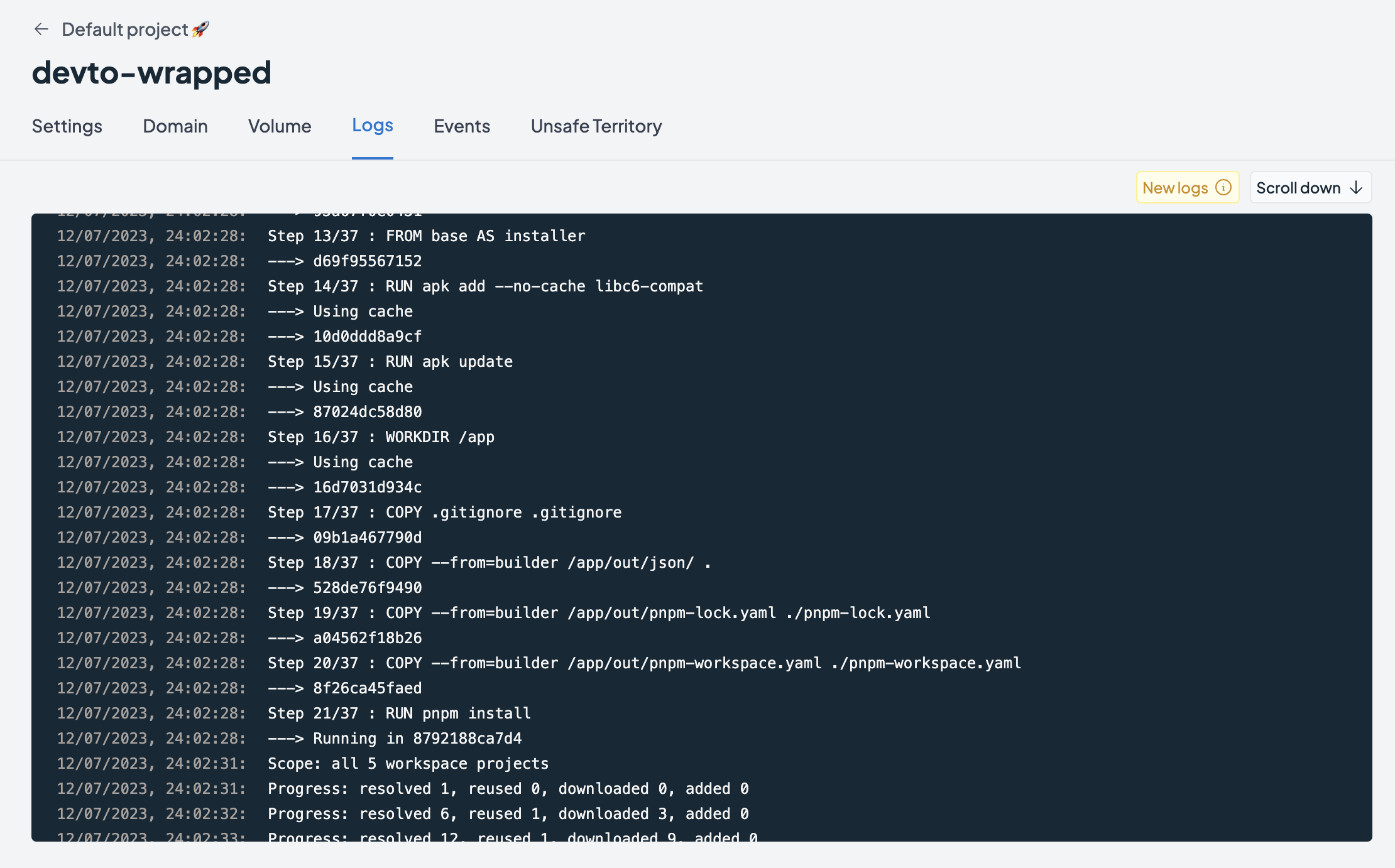 第一次成功部署後,我們將獲得一個可以存取我們的應用程式的免費子網域,或者我們可以加入自己的自訂網域: 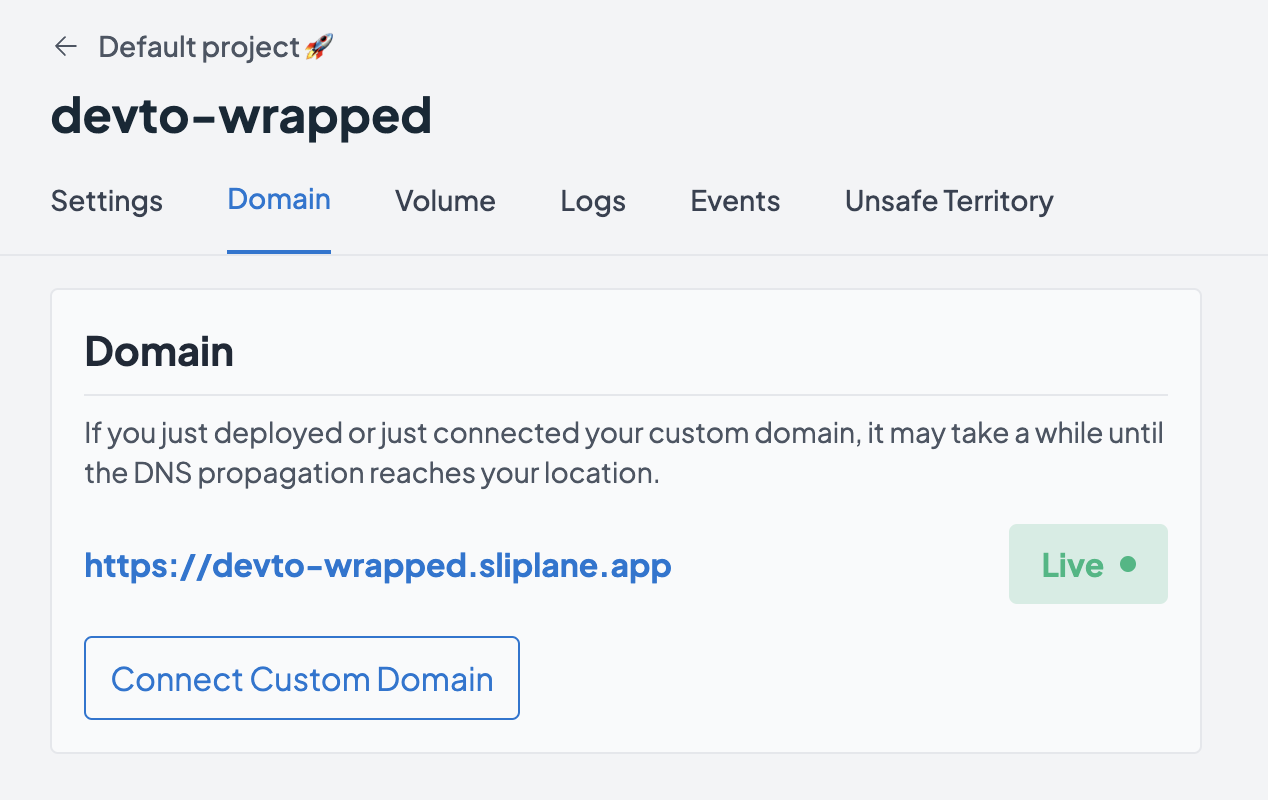 就是這樣!我們的應用程式在線,世界上每個人都可以存取,並且不會產生令人驚訝的無伺服器帳單 🤑 感謝您到目前為止的閱讀,不要忘記用您的截圖進行評論,以_可能_贏得一些貼紙😊 乾杯,喬納斯 --- 原文出處:https://dev.to/code42cate/devto-wrapped-2023-13o
為優秀的開源庫做出貢獻是建立作品集的好方法。 我已經編譯了 23 個優秀的開源程式庫和一些很好的入門問題。 不要忘記加星號並支持這些🌟  --- #產品中的人工智慧: ### 1. [CopilotKit](https://github.com/CopilotKit/CopilotKit) - 應用內 AI 聊天機器人與 AI 文字區域  開源平台,用於使用兩個 React 元件將關鍵 AI 功能整合到 React 應用程式中。 CopilotPortal:應用程式內人工智慧聊天機器人,可以「查看」當前應用程式狀態並採取行動。 CopilotTextarea:AI 驅動的 <textarea /'> 替換。具有自動完成、插入和生成功能。 ###[好第一期:](https://github.com/CopilotKit/CopilotKit/issues/62) ``` Support bold and italicized text in CopilotTextarea Proposal: Add support for bold and italicized text in CopilotTextarea CopilotTextarea uses slate-js under the hood. Lots of examples for adding bold/italicized support Initially only add programatic support. UI support will be added separately in [TODO add issue] Implementation tips: changes will be made to render-element.tsx and base-copilot-textarea.tsx custom-editor.tsx structures may also require changes ``` {% cta https://github.com/CopilotKit/CopilotKit %} Star CopilotKit ⭐️ {% endcta %} --- ###2.[Tavily GPT 研究員](https://github.com/assafelovic/gpt-researcher){% embed https://github.com/assafelovic/gpt-researcher no-readme %} ###3.[Pezzo.ai](https://github.com/pezzolabs/pezzo){% 嵌入 https://github.com/pezzolabs/pezzo no-readme %} ###4.[Weaviate](https://github.com/weaviate/weaviate){% 嵌入 https://github.com/weaviate/weaviate no-readme %} ###5.[LangChain](https://github.com/langchain-ai/langchain){% 嵌入 https://github.com/langchain-ai/langchain no-readme %} --- #🛜網頁開發: ### 6. [Wasp](https://github.com/wasp-lang/wasp) - 使用 React 和 Node.js 開發全端 Web 應用程式 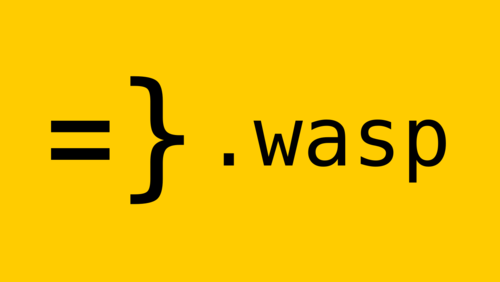 使用 React 和 Node.js 進行快速全端 Web 應用程式開發。 Wasp 提供了一種建立現代 Web 應用程式的簡化方法,將前端的 React 和後端的 Node.js 結合在一個緊密結合的框架中。 ###[好第一期:](https://github.com/wasp-lang/wasp/issues/874) ``` Add images (or link to the example app) of auth UI helpers Wasp provides At this point in docs (also in the tutorial if we're using it), it would be nice to add an image of UI helpers for Auth (login/signup form, Google/GitHub button, ...) so developers can immediately see what they are getting and how nice it looks. ``` {% cta https://github.com/wasp-lang/wasp %} 星黃蜂 ⭐️ {% endcta %} --- ###7.[ClickVote](https://github.com/clickvote/clickvote) {% 嵌入 https://github.com/clickvote/clickvote no-readme %} ###8.[ReactFlow](https://github.com/xyflow/xyflow) {% 嵌入 https://github.com/xyflow/xyflow no-readme %} ###9.[Trigger.dev](https://github.com/triggerdotdev/trigger.dev) {% 嵌入 https://github.com/triggerdotdev/trigger.dev no-readme %} ###10.[Novu](https://github.com/novuhq/novu) {% 嵌入 https://github.com/novuhq/novu no-readme %} --- #🧑💻DevOps: ### 11. [Logstash](https://github.com/elastic/logstash) - 由 elastic 傳輸和處理日誌和事件。 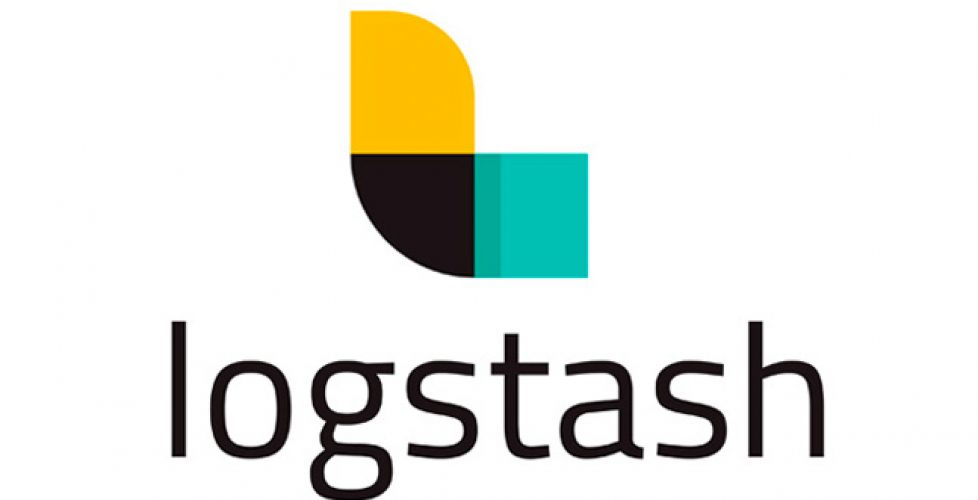 輕鬆將點讚、按讚和評論加入到您的網路應用程式中。 用於加入這些元件的簡單反應程式碼。 ### [第一期好](https://github.com/elastic/logstash/issues/15561) ``` Allow comments in pipeline config between hash entries Currently it seems not allowed to make comments between hash entries, this is a feature request to allow it. ``` {% cta https://github.com/elastic/logstash %} 明星 Logstash ⭐️ {% endcta %} --- ###12.[Odigos](https://github.com/keyval-dev/odigos) {% 嵌入 https://github.com/keyval-dev/odigos no-readme %} ###13.[Glasskube](https://github.com/glasskube/operator) {% 嵌入 https://github.com/glasskube/operator no-readme %} ###14.[鏡像](https://github.com/metalbear-co/mirrord){% 嵌入 https://github.com/metalbear-co/mirrord no-readme %} ###15.[挖土機](https://github.com/diggerhq/digger) {% 嵌入 https://github.com/diggerhq/digger no-readme %} --- #💽資料庫: ### 16. [Supabase](https://github.com/supabase/supabase) - 開源 Rirebase 替代品 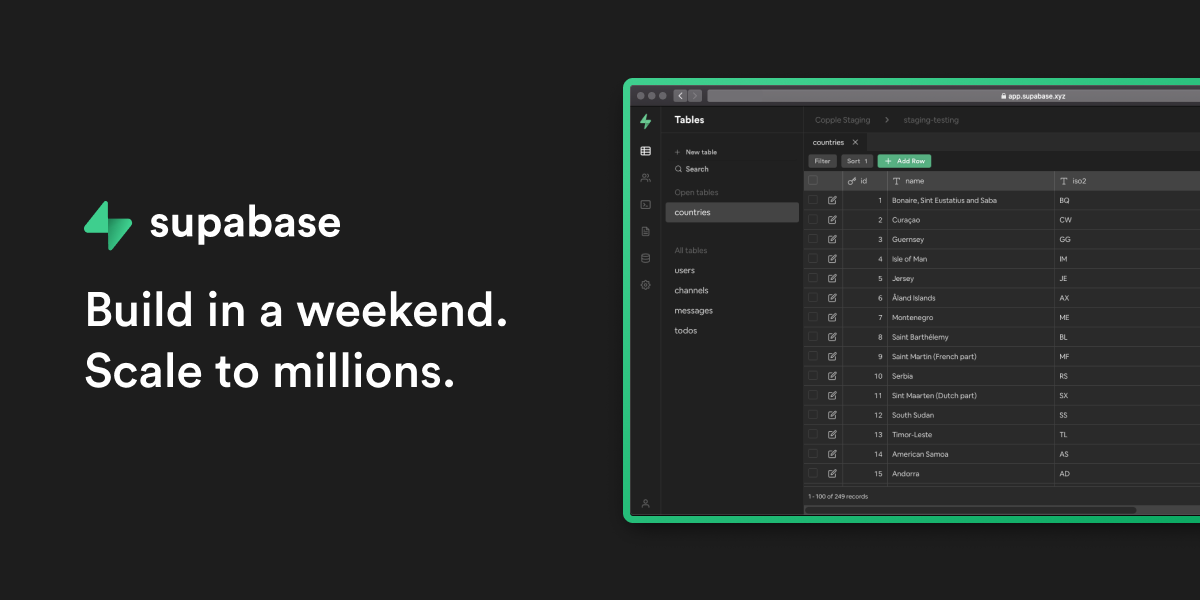 使用託管 Postgres、身份驗證和即時功能建立現代資料驅動應用程式 ###[第一期好:](https://github.com/supabase/supabase/issues/19396) ``` Horizontal Scroll for CodeBlocks Currently when reading the dcs, it's not possible to view all of the code for alot of the samples. Is this the Component rendered across all of the web properties, if so I'll be happy to throw on a horizontal scroll bar that matches supabase branding. ``` {% cta https://github.com/supabase/supabase %} 明星 Supabase ⭐️ {% endcta %} --- ###17.[Appwrite](https://github.com/appwrite/appwrite){% 嵌入 https://github.com/appwrite/appwrite no-readme %} ###18.[Superduperdb] (https://github.com/SuperDuperDB/superduperdb){% 嵌入 https://github.com/SuperDuperDB/superduperdb no-readme %} ###19.[Milvus](https://github.com/milvus-io/milvus) {% 嵌入 https://github.com/milvus-io/milvus no-readme %} --- #👾其他: ### 21. [Snapify](https://github.com/MarconLP/snapify) - 開源螢幕錄製  螢幕錄製,但免費、開源,您負責自己的資料。 ###[好第一期:](https://github.com/MarconLP/snapify/issues/18) ``` Ability to create GIFs and take screenshots to also store in S3 ``` {% cta https://github.com/MarconLP/snapify %} 明星 Snapify ⭐️ {% endcta %} --- ###22.[ReactAgent](https://github.com/eylonmiz/react-agent){% 嵌入 https://github.com/eylonmiz/react-agent no-readme %} ###23.[對初學者來說很棒](https://github.com/MunGell/awesome-for-beginners){% embed https://github.com/MunGell/awesome-for-beginners no -readme %} --- #就是這樣,夥計們! ## 別忘了按讚、留言和收藏🫡 --- 原文出處:https://dev.to/copilotkit/23-open-source-libraries-to-launch-your-portfolio-to-the-moon-fe
# 長話短說;博士 我們都已經看到了 ChatGPT 的功能(這對任何人來說都不陌生)。 很多文章都是使用 ChatGPT 一遍又一遍地寫的。 **實際上**,DEV 上的文章有一半是用 ChatGPT 寫的。 你可以使用一些[AI內容偵測器](https://copyleaks.com/ai-content- detector)來檢視。 問題是,ChatGPT 永遠不會產生一些非凡的內容,除了它內部已經有(經過訓練/微調)的內容。 但有一種方法可以超越目前使用 RAG(OpenAI 助理)訓練的內容。 [上一篇](https://dev.to/triggerdotdev/train-chatgpt-on-your-documentation-1a9g),我們討論了在您的文件上「訓練」ChatGPT;今天,讓我們看看如何從中製作出很多內容。我們將: - 使用 Docusaurus 建立新的部落格系統。 - 詢問 ChatGPT,為我們寫一篇與文件相關的部落格文章。  --- ## 你的後台工作平台🔌 [Trigger.dev](https://trigger.dev/) 是一個開源程式庫,可讓您使用 NextJS、Remix、Astro 等為您的應用程式建立和監控長時間執行的作業! [](https://github.com/triggerdotdev/trigger.dev) 請幫我們一顆星🥹。 這將幫助我們建立更多這樣的文章💖 {% cta https://github.com/triggerdotdev/trigger.dev %} 為 Trigger.dev 儲存庫加註星標 ⭐️ {% endcta %} --- ## 上次回顧 ⏰ - 我們建立了一個作業來取得文件 XML 並提取所有 URL。 - 我們抓取了每個網站的 URL 並提取了標題和內容。 - 我們將所有內容儲存到文件中並將其發送給 ChatGPT 助手。 - 我們建立了一個 ChatBot 畫面來詢問 ChatGPT 有關文件的資訊。 您可以在此處找到上一個[教學]的完整原始程式碼(https://github.com/triggerdotdev/blog/tree/main/openai-assistant)。 ---  ## 稍作修改⚙️ 上次,我們建立了一個文件助理。我們寫: ``` You are a documentation assistant, loaded with documentation from ' + payload.url + ', return everything in an MD format. ``` 讓我們將其更改為部落格作者,請轉到“jobs/process.documentation.ts”第 92 行,並將其替換為以下內容: ``` You are a content writer assistant. You have been loaded with documentation from ${payload.url}, you write blog posts based on the documentation and return everything in the following MD format: --- slug: [post-slug] title: [post-title] --- [post-content] ``` 使用“slug”和“title”非常重要,因為這是 Docusaurus 的格式 - 我們的部落格系統可以接受(當然,我們也以 MD 格式發送所有輸出) ---  ## 多庫龍🦖 您可以使用多種類型的部落格系統! 對於我們的用例,我們將使用 Docusaurus,它可以讀取基於 MD 的格式(我們從 ChatGPT 請求的輸出)。 **我們可以透過執行來安裝 Docusaurus:** ``` npx create-docusaurus@latest blog classic --typescript ``` 接下來,我們可以進入已建立的目錄並執行以下命令: ``` npm run start ``` 這將啟動 Docusaurus。你可以關註一下。還有一個名為“blog”的附加目錄,其中包含所有部落格文章;這是我們保存 ChatGPT 產生的部落格文章的地方。 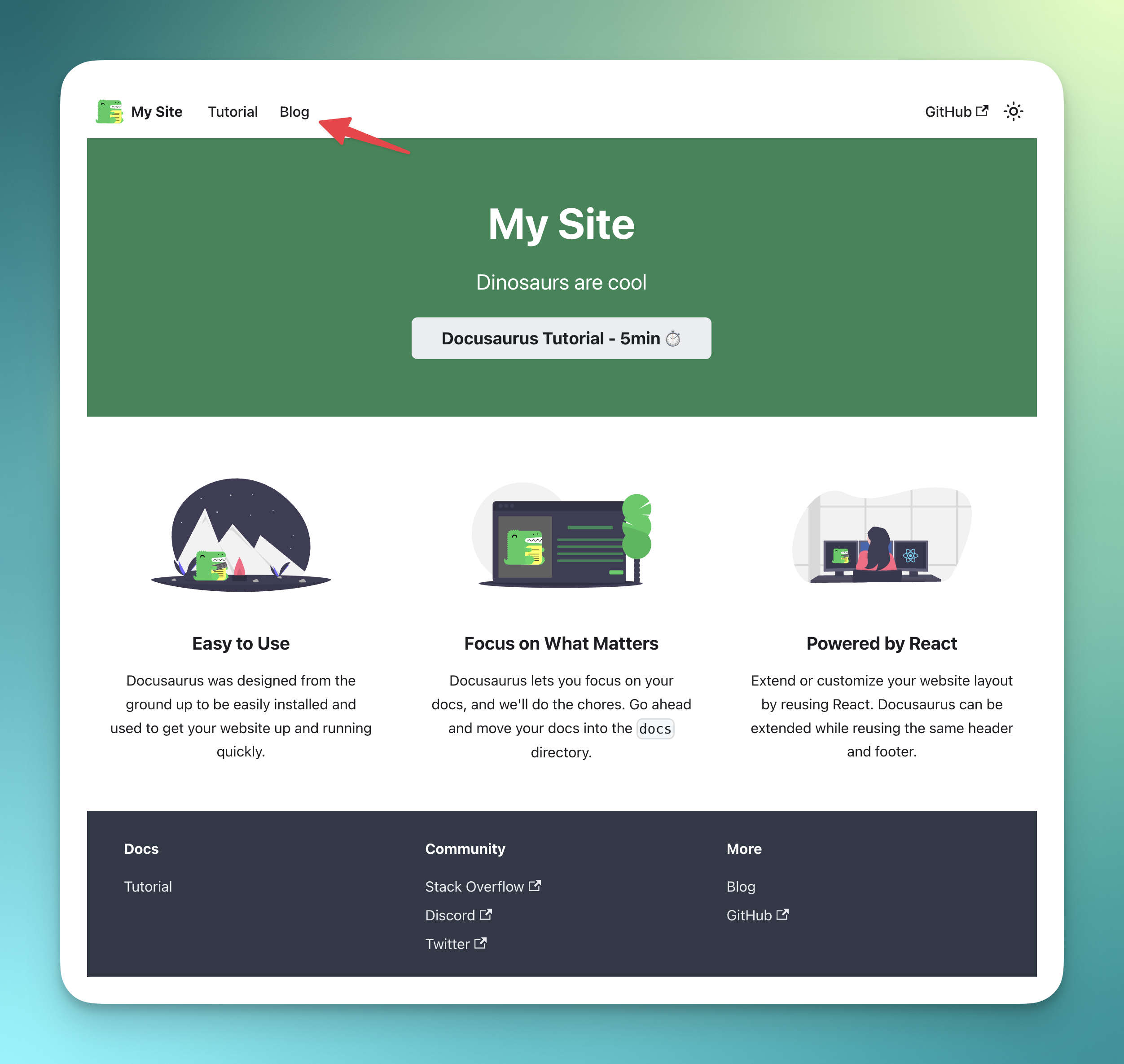 ---  ## 產生部落格 📨 我們需要創造一個就業機會 - 取得部落格標題 - 使用 ChatGPT 產生完整的部落格文章 - 將其保存到我們部落格上的 MD 文件中 我們可以輕鬆地使用 ChatGPT 來實現這一點! 前往“jobs”資料夾並新增一個名為“process.blog.ts”的新檔案。新增以下程式碼: ``` import { eventTrigger } from "@trigger.dev/sdk"; import { client } from "@openai-assistant/trigger"; import {object, string} from "zod"; import {openai} from "@openai-assistant/helper/open.ai"; import {writeFileSync} from "fs"; import slugify from "slugify"; client.defineJob({ // This is the unique identifier for your Job, it must be unique across all Jobs in your project. id: "process-blog", name: "Process Blog", version: "0.0.1", // This is triggered by an event using eventTrigger. You can also trigger Jobs with webhooks, on schedules, and more: https://trigger.dev/docs/documentation/concepts/triggers/introduction trigger: eventTrigger({ name: "process.blog.event", schema: object({ title: string(), aId: string(), }) }), integrations: { openai }, run: async (payload, io, ctx) => { const {title, aId} = payload; const thread = await io.openai.beta.threads.create('create-thread'); await io.openai.beta.threads.messages.create('create-message', thread.id, { content: ` title: ${title} `, role: 'user', }); const run = await io.openai.beta.threads.runs.createAndWaitForCompletion('run-thread', thread.id, { model: 'gpt-4-1106-preview', assistant_id: payload.aId, }); if (run.status !== "completed") { console.log('not completed'); throw new Error(`Run finished with status ${run.status}: ${JSON.stringify(run.last_error)}`); } const messages = await io.openai.beta.threads.messages.list("list-messages", run.thread_id, { query: { limit: "1" } }); return io.runTask('save-blog', async () => { const content = messages[0].content[0]; if (content.type === 'text') { const fileName = slugify(title, {lower: true, strict: true, trim: true}); writeFileSync(`./blog/blog/${fileName}.md`, content.text.value) return {fileName}; } }); }, }); ``` - 我們加入了一些必要的變數: - `title` 部落格文章標題 - `aId` 上一篇文章中新增的助手 ID。 - 我們為助手建立了一個新線程(`io.openai.beta.threads.create`) - 我們無法在沒有任何線程的情況下質疑它。與之前的教程不同,在這裡,我們對每個請求建立一個新線程。我們不需要對話中最後一條訊息的上下文。 - 然後,我們使用部落格標題為線程(`io.openai.beta.threads.messages.create`)新增訊息。我們不需要提供額外的說明 - 我們已經在第一部分完成了該部分😀 - 我們執行 `io.openai.beta.threads.runs.createAndWaitForCompletion` 來啟動進程 - 通常,您需要某種每分鐘執行一次的遞歸來檢查作業是否完成,但是 [Trigger.dev]( http://Trigger .dev)已經加入了一種執行進程並同時等待它的方法🥳 - 我們在查詢正文中執行帶有“limit: 1”的“io.openai.beta.threads.messages.list”,以從對話中獲取第一則訊息(在ChatGPT 結果中,第一則訊息是最後一條訊息) 。 - 然後,我們使用「writeFileSync」從 ChatGPT 取得的值來儲存新建立的部落格 - 確保您擁有正確的部落格路徑。 轉到“jobs/index.ts”並加入以下行: ``` export * from "./process.blog"; ``` 現在,讓我們建立一個新的路由來觸發該作業。 前往“app/api”,建立一個名為“blog”的新資料夾,並在一個名為“route.tsx”的新檔案中 新增以下程式碼: ``` import {client} from "@openai-assistant/trigger"; export async function POST(request: Request) { const payload = await request.json(); if (!payload.title || !payload.aId) { return new Response(JSON.stringify({error: 'Missing parameters'}), {status: 400}); } // We send an event to the trigger to process the documentation const {id: eventId} = await client.sendEvent({ name: "process.blog.event", payload }); return new Response(JSON.stringify({eventId}), {status: 200}); } ``` - 我們檢查標題和助理 ID 是否存在。 - 我們在 [Trigger.dev](http://Trigger.dev) 中觸發事件並發送訊息。 - 我們將事件 ID 傳送回客戶端,以便我們可以追蹤作業的進度。 ---  ## 前端🎩 沒什麼好做的! 在我們的「components」目錄中,建立一個名為「blog.component.tsx」的新檔案和以下程式碼: ``` "use client"; import {FC, useCallback, useEffect, useState} from "react"; import {ExtendedAssistant} from "@openai-assistant/components/main"; import {SubmitHandler, useForm} from "react-hook-form"; import {useEventRunDetails} from "@trigger.dev/react"; interface Blog { title: string, aId: string; } export const BlogComponent: FC<{list: ExtendedAssistant[]}> = (props) => { const {list} = props; const {register, formState, handleSubmit} = useForm<Blog>(); const [event, setEvent] = useState<string | undefined>(undefined); const addBlog: SubmitHandler<Blog> = useCallback(async (param) => { const {eventId} = await (await fetch('/api/blog', { method: 'POST', headers: { 'Content-Type': 'application/json' }, body: JSON.stringify(param) })).json(); setEvent(eventId); }, []); return ( <> <form className="flex flex-col gap-3 mt-5" onSubmit={handleSubmit(addBlog)}> <div className="flex flex-col gap-1"> <div className="font-bold">Assistant</div> <select className="border border-gray-200 rounded-xl py-2 px-3" {...register('aId', {required: true})}> {list.map(val => ( <option key={val.id} value={val.aId}>{val.url}</option> ))} </select> </div> <div className="flex flex-col gap-1"> <div className="font-bold">Title</div> <input className="border border-gray-200 rounded-xl py-2 px-3" placeholder="Blog title" {...register('title', {required: true})} /> </div> <button className="border border-gray-200 rounded-xl py-2 px-3 bg-gray-100 hover:bg-gray-200" disabled={formState.isSubmitting}>Create blog</button> </form> {!!event && ( <Blog eventId={event} /> )} </> ) } export const Blog: FC<{eventId: string}> = (props) => { const {eventId} = props; const { data, error } = useEventRunDetails(eventId); if (data?.status !== 'SUCCESS') { return <div className="pointer bg-yellow-300 border-yellow-500 p-1 px-3 text-yellow-950 border rounded-2xl">Loading</div> } return ( <div> <a href={`http://localhost:3000/blog/${data.output.fileName}`}>Check blog post</a> </div> ) }; ``` - 我們使用「react-hook-form」來輕鬆控制我們的輸入。 - 我們讓使用者選擇他們想要使用的助手。 - 我們建立一個包含文章標題的新輸入。 - 我們將所有內容傳送到先前建立的路由並傳回作業的「eventId」。 - 我們建立一個新的「<Blog />」元件,該元件顯示載入直到事件完成,並使用新建立的教程新增指向我們部落格的連結。 將元件加入我們的“components/main.tsx”檔案中: ``` {assistantState.filter(f => !f.pending).length > 0 && <BlogComponent list={assistantState} />} ``` 我們完成了! 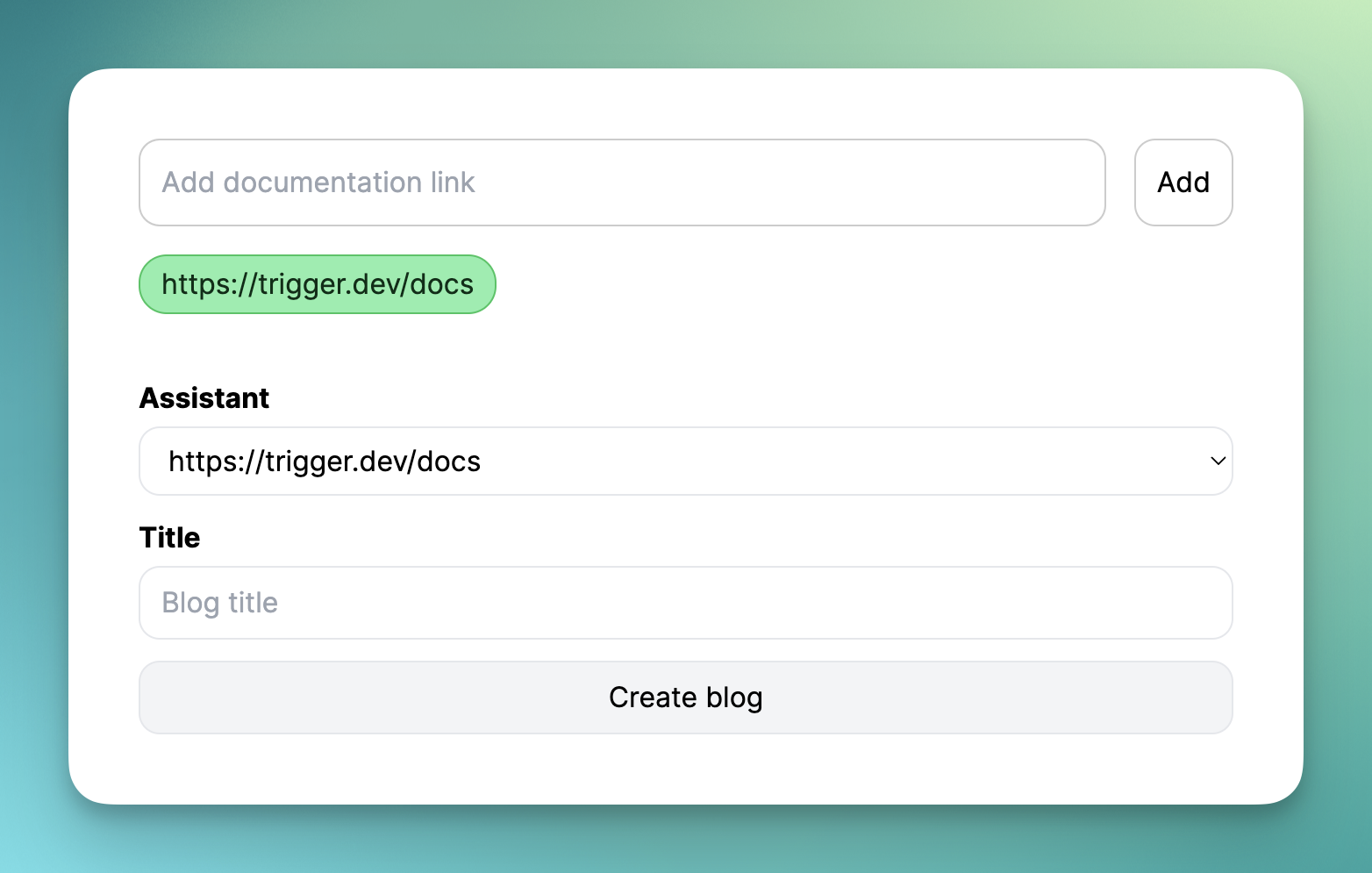 現在,讓我們新增部落格標題並點擊「生成」。 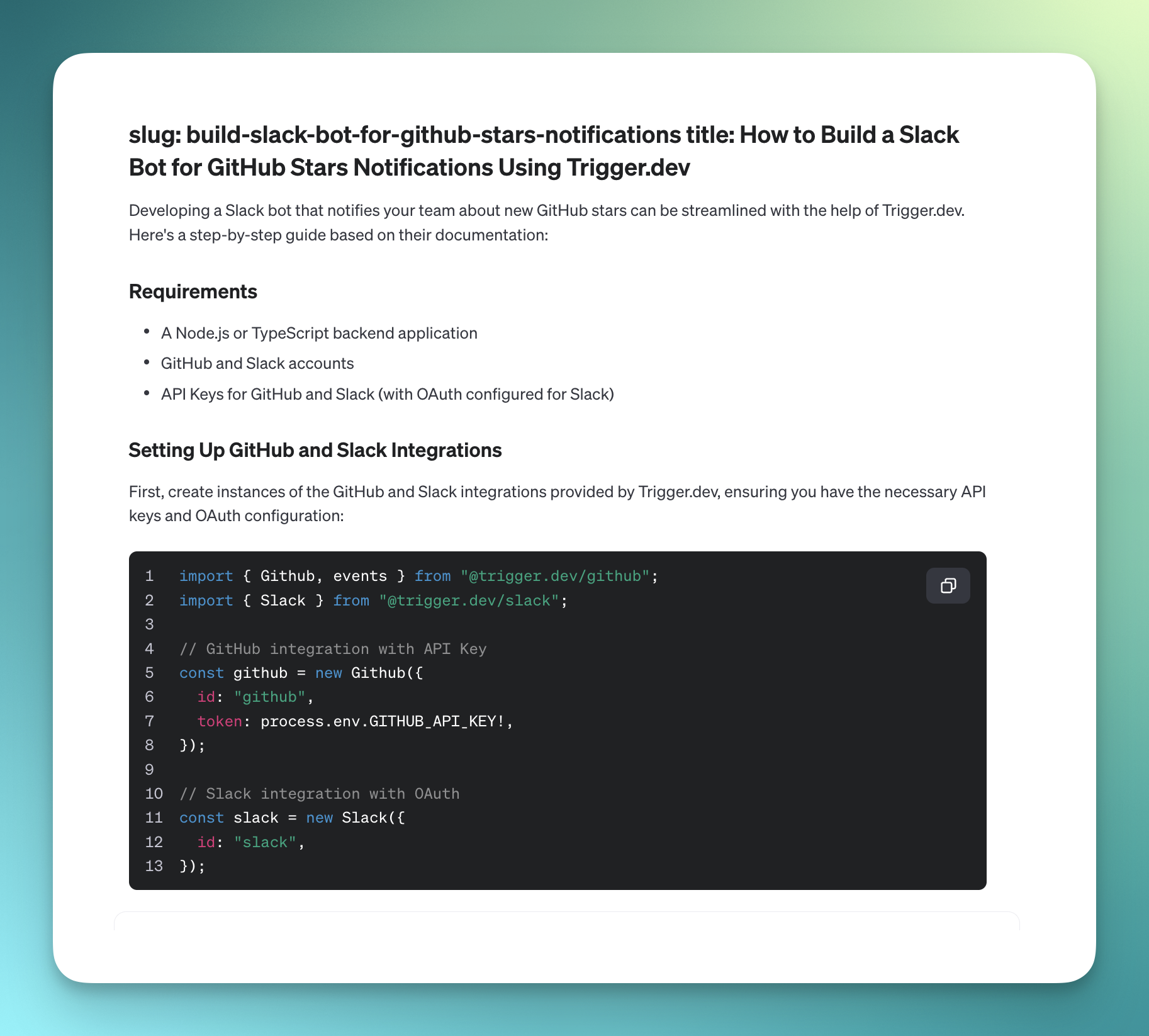 ---  ## 讓我們聯絡吧! 🔌 作為開源開發者,您可以加入我們的[社群](https://discord.gg/nkqV9xBYWy) 做出貢獻並與維護者互動。請隨時造訪我們的 [GitHub 儲存庫](https://github.com/triggerdotdev/trigger.dev),貢獻並建立與 Trigger.dev 相關的問題。 本教學的源程式碼可在此處取得: https://github.com/triggerdotdev/blog/tree/main/openai-blog-writer 感謝您的閱讀! --- 原文出處:https://dev.to/triggerdotdev/generate-blogs-with-chatgpt-assistant-1894
# 簡介 ChatGPT 訓練至 2022 年。 但是,如果您希望它專門為您提供有關您網站的資訊怎麼辦?最有可能的是,這是不可能的,**但不再是了!** OpenAI 推出了他們的新功能 - [助手](https://platform.openai.com/docs/assistants/how-it-works)。 現在您可以輕鬆地為您的網站建立索引,然後向 ChatGPT 詢問有關該網站的問題。在本教程中,我們將建立一個系統來索引您的網站並讓您查詢它。我們將: - 抓取文件網站地圖。 - 從網站上的所有頁面中提取資訊。 - 使用新資訊建立新助理。 - 建立一個簡單的ChatGPT前端介面並查詢助手。  --- ## 你的後台工作平台🔌 [Trigger.dev](https://trigger.dev/) 是一個開源程式庫,可讓您使用 NextJS、Remix、Astro 等為您的應用程式建立和監控長時間執行的作業! [](https://github.com/triggerdotdev/trigger.dev) 請幫我們一顆星🥹。 這將幫助我們建立更多這樣的文章💖 --- ## 讓我們開始吧🔥 讓我們建立一個新的 NextJS 專案。 ``` npx create-next-app@latest ``` >💡 我們使用 NextJS 新的應用程式路由器。安裝專案之前請確保您的節點版本為 18+ 讓我們建立一個新的資料庫來保存助手和抓取的頁面。 對於我們的範例,我們將使用 [Prisma](https://www.prisma.io/) 和 SQLite。 安裝非常簡單,只需執行: ``` npm install prisma @prisma/client --save ``` 然後加入架構和資料庫 ``` npx prisma init --datasource-provider sqlite ``` 轉到“prisma/schema.prisma”並將其替換為以下架構: ``` // This is your Prisma schema file, // learn more about it in the docs: https://pris.ly/d/prisma-schema generator client { provider = "prisma-client-js" } datasource db { provider = "sqlite" url = env("DATABASE_URL") } model Docs { id Int @id @default(autoincrement()) content String url String @unique identifier String @@index([identifier]) } model Assistant { id Int @id @default(autoincrement()) aId String url String @unique } ``` 然後執行 ``` npx prisma db push ``` 這將建立一個新的 SQLite 資料庫(本機檔案),其中包含兩個主表:“Docs”和“Assistant” - 「Docs」包含所有抓取的頁面 - `Assistant` 包含文件的 URL 和內部 ChatGPT 助理 ID。 讓我們新增 Prisma 客戶端。 建立一個名為「helper」的新資料夾,並新增一個名為「prisma.ts」的新文件,並在其中新增以下程式碼: ``` import {PrismaClient} from '@prisma/client'; export const prisma = new PrismaClient(); ``` 我們稍後可以使用“prisma”變數來查詢我們的資料庫。 ---  ## 刮擦和索引 ### 建立 Trigger.dev 帳戶 抓取頁面並為其建立索引是一項長期執行的任務。 **我們需要:** - 抓取網站地圖的主網站元 URL。 - 擷取網站地圖內的所有頁面。 - 前往每個頁面並提取內容。 - 將所有內容儲存到 ChatGPT 助手中。 為此,我們使用 Trigger.dev! 註冊 [Trigger.dev 帳號](https://trigger.dev/)。 註冊後,建立一個組織並為您的工作選擇一個專案名稱。 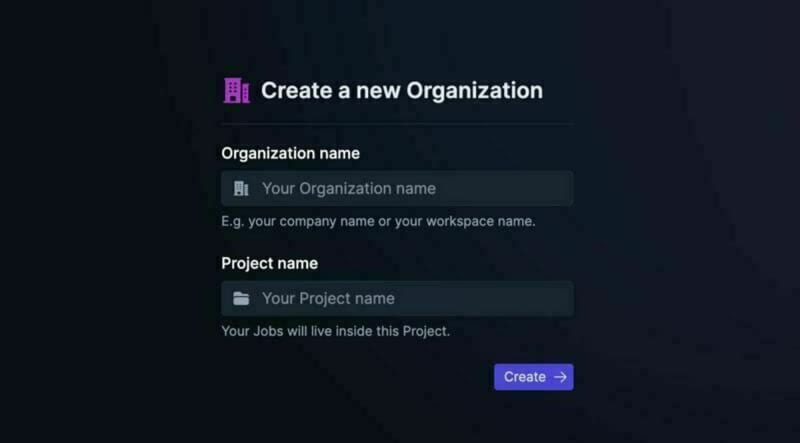 選擇 Next.js 作為您的框架,並按照將 Trigger.dev 新增至現有 Next.js 專案的流程進行操作。  否則,請點選專案儀表板側邊欄選單上的「環境和 API 金鑰」。  複製您的 DEV 伺服器 API 金鑰並執行下面的程式碼片段來安裝 Trigger.dev。 仔細按照說明進行操作。 ``` npx @trigger.dev/cli@latest init ``` 在另一個終端中執行以下程式碼片段,在 Trigger.dev 和您的 Next.js 專案之間建立隧道。 ``` npx @trigger.dev/cli@latest dev ``` ### 安裝 ChatGPT (OpenAI) 我們將使用OpenAI助手,因此我們必須將其安裝到我們的專案中。 [建立新的 OpenAI 帳戶](https://platform.openai.com/) 並產生 API 金鑰。 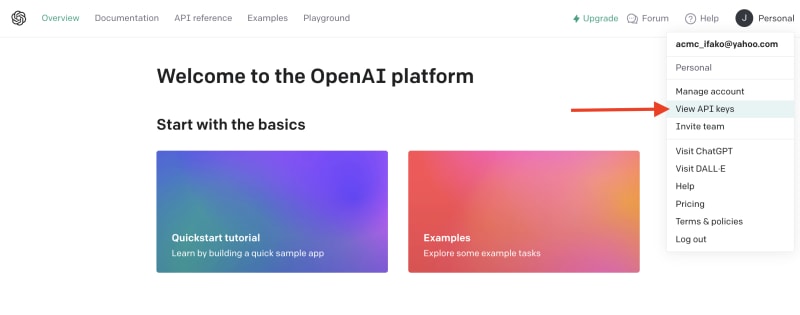 點擊下拉清單中的「檢視 API 金鑰」以建立 API 金鑰。 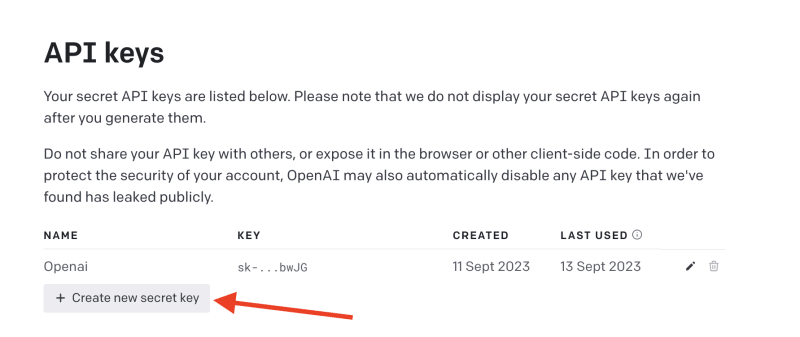 接下來,透過執行下面的程式碼片段來安裝 OpenAI 套件。 ``` npm install @trigger.dev/openai ``` 將您的 OpenAI API 金鑰新增至「.env.local」檔案。 ``` OPENAI_API_KEY=<your_api_key> ``` 建立一個新目錄“helper”並新增一個新檔案“open.ai.tsx”,其中包含以下內容: ``` import {OpenAI} from "@trigger.dev/openai"; export const openai = new OpenAI({ id: "openai", apiKey: process.env.OPENAI_API_KEY!, }); ``` 這是我們透過 Trigger.dev 整合封裝的 OpenAI 用戶端。 ### 建立後台作業 讓我們繼續建立一個新的後台作業! 前往“jobs”並建立一個名為“process.documentation.ts”的新檔案。 **新增以下程式碼:** ``` import { eventTrigger } from "@trigger.dev/sdk"; import { client } from "@openai-assistant/trigger"; import {object, string} from "zod"; import {JSDOM} from "jsdom"; import {openai} from "@openai-assistant/helper/open.ai"; client.defineJob({ // This is the unique identifier for your Job; it must be unique across all Jobs in your project. id: "process-documentation", name: "Process Documentation", version: "0.0.1", // This is triggered by an event using eventTrigger. You can also trigger Jobs with webhooks, on schedules, and more: https://trigger.dev/docs/documentation/concepts/triggers/introduction trigger: eventTrigger({ name: "process.documentation.event", schema: object({ url: string(), }) }), integrations: { openai }, run: async (payload, io, ctx) => { } }); ``` 我們定義了一個名為「process.documentation.event」的新作業,並新增了一個名為 URL 的必要參數 - 這是我們稍後要傳送的文件 URL。 正如您所看到的,該作業是空的,所以讓我們向其中加入第一個任務。 我們需要獲取網站網站地圖並將其返回。 抓取網站將返回我們需要解析的 HTML。 為此,我們需要安裝 JSDOM。 ``` npm install jsdom --save ``` 並將其導入到我們文件的頂部: ``` import {JSDOM} from "jsdom"; ``` 現在,我們可以新增第一個任務。 用「runTask」包裝我們的程式碼很重要,這可以讓 Trigger.dev 將其與其他任務分開。觸發特殊架構將任務拆分為不同的進程,因此 Vercel 無伺服器逾時不會影響它們。 **這是第一個任務的程式碼:** ``` const getSiteMap = await io.runTask("grab-sitemap", async () => { const data = await (await fetch(payload.url)).text(); const dom = new JSDOM(data); const sitemap = dom.window.document.querySelector('[rel="sitemap"]')?.getAttribute('href'); return new URL(sitemap!, payload.url).toString(); }); ``` - 我們透過 HTTP 請求從 URL 取得整個 HTML。 - 我們將其轉換為 JS 物件。 - 我們找到網站地圖 URL。 - 我們解析它並返回它。 接下來,我們需要抓取網站地圖,提取所有 URL 並返回它們。 讓我們安裝“Lodash”——陣列結構的特殊函數。 ``` npm install lodash @types/lodash --save ``` 這是任務的程式碼: ``` export const makeId = (length: number) => { let text = ''; const possible = 'ABCDEFGHIJKLMNOPQRSTUVWXYZabcdefghijklmnopqrstuvwxyz0123456789'; for (let i = 0; i < length; i += 1) { text += possible.charAt(Math.floor(Math.random() * possible.length)); } return text; }; const {identifier, list} = await io.runTask("load-and-parse-sitemap", async () => { const urls = /(http|ftp|https):\/\/([\w_-]+(?:(?:\.[\w_-]+)+))([\w.,@?^=%&:\/~+#-]*[\w@?^=%&\/~+#-])/g; const identifier = makeId(5); const data = await (await fetch(getSiteMap)).text(); // @ts-ignore return {identifier, list: chunk(([...new Set(data.match(urls))] as string[]).filter(f => f.includes(payload.url)).map(p => ({identifier, url: p})), 25)}; }); ``` - 我們建立一個名為 makeId 的新函數來為所有頁面產生隨機辨識碼。 - 我們建立一個新任務並加入正規表示式來提取每個可能的 URL - 我們發送一個 HTTP 請求來載入網站地圖並提取其所有 URL。 - 我們將 URL「分塊」為 25 個元素的陣列(如果有 100 個元素,則會有四個 25 個元素的陣列) 接下來,讓我們建立一個新作業來處理每個 URL。 **這是完整的程式碼:** ``` function getElementsBetween(startElement: Element, endElement: Element) { let currentElement = startElement; const elements = []; // Traverse the DOM until the endElement is reached while (currentElement && currentElement !== endElement) { currentElement = currentElement.nextElementSibling!; // If there's no next sibling, go up a level and continue if (!currentElement) { // @ts-ignore currentElement = startElement.parentNode!; startElement = currentElement; if (currentElement === endElement) break; continue; } // Add the current element to the list if (currentElement && currentElement !== endElement) { elements.push(currentElement); } } return elements; } const processContent = client.defineJob({ // This is the unique identifier for your Job; it must be unique across all Jobs in your project. id: "process-content", name: "Process Content", version: "0.0.1", // This is triggered by an event using eventTrigger. You can also trigger Jobs with webhooks, on schedules, and more: https://trigger.dev/docs/documentation/concepts/triggers/introduction trigger: eventTrigger({ name: "process.content.event", schema: object({ url: string(), identifier: string(), }) }), run: async (payload, io, ctx) => { return io.runTask('grab-content', async () => { // We first grab a raw html of the content from the website const data = await (await fetch(payload.url)).text(); // We load it with JSDOM so we can manipulate it const dom = new JSDOM(data); // We remove all the scripts and styles from the page dom.window.document.querySelectorAll('script, style').forEach((el) => el.remove()); // We grab all the titles from the page const content = Array.from(dom.window.document.querySelectorAll('h1, h2, h3, h4, h5, h6')); // We grab the last element so we can get the content between the last element and the next element const lastElement = content[content.length - 1]?.parentElement?.nextElementSibling!; const elements = []; // We loop through all the elements and grab the content between each title for (let i = 0; i < content.length; i++) { const element = content[i]; const nextElement = content?.[i + 1] || lastElement; const elementsBetween = getElementsBetween(element, nextElement); elements.push({ title: element.textContent, content: elementsBetween.map((el) => el.textContent).join('\n') }); } // We create a raw text format of all the content const page = ` ---------------------------------- url: ${payload.url}\n ${elements.map((el) => `${el.title}\n${el.content}`).join('\n')} ---------------------------------- `; // We save it to our database await prisma.docs.upsert({ where: { url: payload.url }, update: { content: page, identifier: payload.identifier }, create: { url: payload.url, content: page, identifier: payload.identifier } }); }); }, }); ``` - 我們從 URL 中獲取內容(之前從網站地圖中提取) - 我們用`JSDOM`解析它 - 我們刪除頁面上存在的所有可能的“<script>”或“<style>”。 - 我們抓取頁面上的所有標題(`h1`、`h2`、`h3`、`h4`、`h5`、`h6`) - 我們迭代標題並獲取它們之間的內容。我們不想取得整個頁面內容,因為它可能包含不相關的內容。 - 我們建立頁面原始文字的版本並將其保存到我們的資料庫中。 現在,讓我們為每個網站地圖 URL 執行此任務。 觸發器引入了名為“batchInvokeAndWaitForCompletion”的東西。 它允許我們批量發送 25 個專案進行處理,並且它將同時處理所有這些專案。下面是接下來的幾行程式碼: ``` let i = 0; for (const item of list) { await processContent.batchInvokeAndWaitForCompletion( 'process-list-' + i, item.map( payload => ({ payload, }), 86_400), ); i++; } ``` 我們以 25 個為一組[手動觸發](https://trigger.dev/docs/documentation/concepts/triggers/invoke)之前建立的作業。 完成後,讓我們將保存到資料庫的所有內容並連接它: ``` const data = await io.runTask("get-extracted-data", async () => { return (await prisma.docs.findMany({ where: { identifier }, select: { content: true } })).map((d) => d.content).join('\n\n'); }); ``` 我們使用之前指定的標識符。 現在,讓我們在 ChatGPT 中使用新資料建立一個新檔案: ``` const file = await io.openai.files.createAndWaitForProcessing("upload-file", { purpose: "assistants", file: data }); ``` `createAndWaitForProcessing` 是 Trigger.dev 建立的任務,用於將檔案上傳到助手。如果您在沒有整合的情況下手動使用“openai”,則必須串流傳輸檔案。 現在讓我們建立或更新我們的助手: ``` const assistant = await io.openai.runTask("create-or-update-assistant", async (openai) => { const currentAssistant = await prisma.assistant.findFirst({ where: { url: payload.url } }); if (currentAssistant) { return openai.beta.assistants.update(currentAssistant.aId, { file_ids: [file.id] }); } return openai.beta.assistants.create({ name: identifier, description: 'Documentation', instructions: 'You are a documentation assistant, you have been loaded with documentation from ' + payload.url + ', return everything in an MD format.', model: 'gpt-4-1106-preview', tools: [{ type: "code_interpreter" }, {type: 'retrieval'}], file_ids: [file.id], }); }); ``` - 我們首先檢查是否有針對該特定 URL 的助手。 - 如果我們有的話,讓我們用新文件更新助手。 - 如果沒有,讓我們建立一個新的助手。 - 我們傳遞「你是文件助理」的指令,需要注意的是,我們希望最終輸出為「MD」格式,以便稍後更好地顯示。 對於拼圖的最後一塊,讓我們將新助手儲存到我們的資料庫中。 **這是程式碼:** ``` await io.runTask("save-assistant", async () => { await prisma.assistant.upsert({ where: { url: payload.url }, update: { aId: assistant.id, }, create: { aId: assistant.id, url: payload.url, } }); }); ``` 如果該 URL 已經存在,我們可以嘗試使用新的助手 ID 來更新它。 這是該頁面的完整程式碼: ``` import { eventTrigger } from "@trigger.dev/sdk"; import { client } from "@openai-assistant/trigger"; import {object, string} from "zod"; import {JSDOM} from "jsdom"; import {chunk} from "lodash"; import {prisma} from "@openai-assistant/helper/prisma.client"; import {openai} from "@openai-assistant/helper/open.ai"; const makeId = (length: number) => { let text = ''; const possible = 'ABCDEFGHIJKLMNOPQRSTUVWXYZabcdefghijklmnopqrstuvwxyz0123456789'; for (let i = 0; i < length; i += 1) { text += possible.charAt(Math.floor(Math.random() * possible.length)); } return text; }; client.defineJob({ // This is the unique identifier for your Job; it must be unique across all Jobs in your project. id: "process-documentation", name: "Process Documentation", version: "0.0.1", // This is triggered by an event using eventTrigger. You can also trigger Jobs with webhooks, on schedules, and more: https://trigger.dev/docs/documentation/concepts/triggers/introduction trigger: eventTrigger({ name: "process.documentation.event", schema: object({ url: string(), }) }), integrations: { openai }, run: async (payload, io, ctx) => { // The first task to get the sitemap URL from the website const getSiteMap = await io.runTask("grab-sitemap", async () => { const data = await (await fetch(payload.url)).text(); const dom = new JSDOM(data); const sitemap = dom.window.document.querySelector('[rel="sitemap"]')?.getAttribute('href'); return new URL(sitemap!, payload.url).toString(); }); // We parse the sitemap; instead of using some XML parser, we just use regex to get the URLs and we return it in chunks of 25 const {identifier, list} = await io.runTask("load-and-parse-sitemap", async () => { const urls = /(http|ftp|https):\/\/([\w_-]+(?:(?:\.[\w_-]+)+))([\w.,@?^=%&:\/~+#-]*[\w@?^=%&\/~+#-])/g; const identifier = makeId(5); const data = await (await fetch(getSiteMap)).text(); // @ts-ignore return {identifier, list: chunk(([...new Set(data.match(urls))] as string[]).filter(f => f.includes(payload.url)).map(p => ({identifier, url: p})), 25)}; }); // We go into each page and grab the content; we do this in batches of 25 and save it to the DB let i = 0; for (const item of list) { await processContent.batchInvokeAndWaitForCompletion( 'process-list-' + i, item.map( payload => ({ payload, }), 86_400), ); i++; } // We get the data that we saved in batches from the DB const data = await io.runTask("get-extracted-data", async () => { return (await prisma.docs.findMany({ where: { identifier }, select: { content: true } })).map((d) => d.content).join('\n\n'); }); // We upload the data to OpenAI with all the content const file = await io.openai.files.createAndWaitForProcessing("upload-file", { purpose: "assistants", file: data }); // We create a new assistant or update the old one with the new file const assistant = await io.openai.runTask("create-or-update-assistant", async (openai) => { const currentAssistant = await prisma.assistant.findFirst({ where: { url: payload.url } }); if (currentAssistant) { return openai.beta.assistants.update(currentAssistant.aId, { file_ids: [file.id] }); } return openai.beta.assistants.create({ name: identifier, description: 'Documentation', instructions: 'You are a documentation assistant, you have been loaded with documentation from ' + payload.url + ', return everything in an MD format.', model: 'gpt-4-1106-preview', tools: [{ type: "code_interpreter" }, {type: 'retrieval'}], file_ids: [file.id], }); }); // We update our internal database with the assistant await io.runTask("save-assistant", async () => { await prisma.assistant.upsert({ where: { url: payload.url }, update: { aId: assistant.id, }, create: { aId: assistant.id, url: payload.url, } }); }); }, }); export function getElementsBetween(startElement: Element, endElement: Element) { let currentElement = startElement; const elements = []; // Traverse the DOM until the endElement is reached while (currentElement && currentElement !== endElement) { currentElement = currentElement.nextElementSibling!; // If there's no next sibling, go up a level and continue if (!currentElement) { // @ts-ignore currentElement = startElement.parentNode!; startElement = currentElement; if (currentElement === endElement) break; continue; } // Add the current element to the list if (currentElement && currentElement !== endElement) { elements.push(currentElement); } } return elements; } // This job will grab the content from the website const processContent = client.defineJob({ // This is the unique identifier for your Job; it must be unique across all Jobs in your project. id: "process-content", name: "Process Content", version: "0.0.1", // This is triggered by an event using eventTrigger. You can also trigger Jobs with webhooks, on schedules, and more: https://trigger.dev/docs/documentation/concepts/triggers/introduction trigger: eventTrigger({ name: "process.content.event", schema: object({ url: string(), identifier: string(), }) }), run: async (payload, io, ctx) => { return io.runTask('grab-content', async () => { try { // We first grab a raw HTML of the content from the website const data = await (await fetch(payload.url)).text(); // We load it with JSDOM so we can manipulate it const dom = new JSDOM(data); // We remove all the scripts and styles from the page dom.window.document.querySelectorAll('script, style').forEach((el) => el.remove()); // We grab all the titles from the page const content = Array.from(dom.window.document.querySelectorAll('h1, h2, h3, h4, h5, h6')); // We grab the last element so we can get the content between the last element and the next element const lastElement = content[content.length - 1]?.parentElement?.nextElementSibling!; const elements = []; // We loop through all the elements and grab the content between each title for (let i = 0; i < content.length; i++) { const element = content[i]; const nextElement = content?.[i + 1] || lastElement; const elementsBetween = getElementsBetween(element, nextElement); elements.push({ title: element.textContent, content: elementsBetween.map((el) => el.textContent).join('\n') }); } // We create a raw text format of all the content const page = ` ---------------------------------- url: ${payload.url}\n ${elements.map((el) => `${el.title}\n${el.content}`).join('\n')} ---------------------------------- `; // We save it to our database await prisma.docs.upsert({ where: { url: payload.url }, update: { content: page, identifier: payload.identifier }, create: { url: payload.url, content: page, identifier: payload.identifier } }); } catch (e) { console.log(e); } }); }, }); ``` 我們已經完成建立後台作業來抓取和索引文件🎉 ### 詢問助理 現在,讓我們建立一個任務來詢問我們的助手。 前往“jobs”並建立一個新檔案“question.assistant.ts”。 **新增以下程式碼:** ``` import {eventTrigger} from "@trigger.dev/sdk"; import {client} from "@openai-assistant/trigger"; import {object, string} from "zod"; import {openai} from "@openai-assistant/helper/open.ai"; client.defineJob({ // This is the unique identifier for your Job; it must be unique across all Jobs in your project. id: "question-assistant", name: "Question Assistant", version: "0.0.1", // This is triggered by an event using eventTrigger. You can also trigger Jobs with webhooks, on schedules, and more: https://trigger.dev/docs/documentation/concepts/triggers/introduction trigger: eventTrigger({ name: "question.assistant.event", schema: object({ content: string(), aId: string(), threadId: string().optional(), }) }), integrations: { openai }, run: async (payload, io, ctx) => { // Create or use an existing thread const thread = payload.threadId ? await io.openai.beta.threads.retrieve('get-thread', payload.threadId) : await io.openai.beta.threads.create('create-thread'); // Create a message in the thread await io.openai.beta.threads.messages.create('create-message', thread.id, { content: payload.content, role: 'user', }); // Run the thread const run = await io.openai.beta.threads.runs.createAndWaitForCompletion('run-thread', thread.id, { model: 'gpt-4-1106-preview', assistant_id: payload.aId, }); // Check the status of the thread if (run.status !== "completed") { console.log('not completed'); throw new Error(`Run finished with status ${run.status}: ${JSON.stringify(run.last_error)}`); } // Get the messages from the thread const messages = await io.openai.beta.threads.messages.list("list-messages", run.thread_id, { query: { limit: "1" } }); const content = messages[0].content[0]; if (content.type === 'text') { return {content: content.text.value, threadId: thread.id}; } } }); ``` - 該事件需要三個參數 - `content` - 我們想要傳送給助理的訊息。 - `aId` - 我們先前建立的助手的內部 ID。 - `threadId` - 對話的執行緒 ID。正如您所看到的,這是一個可選參數,因為在第一個訊息中,我們還沒有線程 ID。 - 然後,我們建立或取得前一個執行緒的執行緒。 - 我們在助理提出的問題的線索中加入一條新訊息。 - 我們執行線程並等待它完成。 - 我們取得訊息清單(並將其限制為 1),因為第一則訊息是對話中的最後一則訊息。 - 我們返回訊息內容和我們剛剛建立的線程ID。 ### 新增路由 我們需要為我們的應用程式建立 3 個 API 路由: 1、派新助理進行處理。 2. 透過URL獲取特定助手。 3. 新增訊息給助手。 在「app/api」中建立一個名為assistant的新資料夾,並在其中建立一個名為「route.ts」的新檔案。裡面加入如下程式碼: ``` import {client} from "@openai-assistant/trigger"; import {prisma} from "@openai-assistant/helper/prisma.client"; export async function POST(request: Request) { const body = await request.json(); if (!body.url) { return new Response(JSON.stringify({error: 'URL is required'}), {status: 400}); } // We send an event to the trigger to process the documentation const {id: eventId} = await client.sendEvent({ name: "process.documentation.event", payload: {url: body.url}, }); return new Response(JSON.stringify({eventId}), {status: 200}); } export async function GET(request: Request) { const url = new URL(request.url).searchParams.get('url'); if (!url) { return new Response(JSON.stringify({error: 'URL is required'}), {status: 400}); } const assistant = await prisma.assistant.findFirst({ where: { url: url } }); return new Response(JSON.stringify(assistant), {status: 200}); } ``` 第一個「POST」方法取得一個 URL,並使用用戶端傳送的 URL 觸發「process.documentation.event」作業。 第二個「GET」方法從我們的資料庫中透過客戶端發送的 URL 取得助手。 現在,讓我們建立向助手新增訊息的路由。 在「app/api」內部建立一個新資料夾「message」並新增一個名為「route.ts」的新文件,然後新增以下程式碼: ``` import {prisma} from "@openai-assistant/helper/prisma.client"; import {client} from "@openai-assistant/trigger"; export async function POST(request: Request) { const body = await request.json(); // Check that we have the assistant id and the message if (!body.id || !body.message) { return new Response(JSON.stringify({error: 'Id and Message are required'}), {status: 400}); } // get the assistant id in OpenAI from the id in the database const assistant = await prisma.assistant.findUnique({ where: { id: +body.id } }); // We send an event to the trigger to process the documentation const {id: eventId} = await client.sendEvent({ name: "question.assistant.event", payload: { content: body.message, aId: assistant?.aId, threadId: body.threadId }, }); return new Response(JSON.stringify({eventId}), {status: 200}); } ``` 這是一個非常基本的程式碼。我們從客戶端獲取訊息、助手 ID 和線程 ID,並將其發送到我們之前建立的「question.assistant.event」。 最後要做的事情是建立一個函數來獲取我們所有的助手。 在「helpers」內部建立一個名為「get.list.ts」的新函數並新增以下程式碼: ``` import {prisma} from "@openai-assistant/helper/prisma.client"; // Get the list of all the available assistants export const getList = () => { return prisma.assistant.findMany({ }); } ``` 非常簡單的程式碼即可獲得所有助手。 我們已經完成了後端🥳 讓我們轉到前面。 ---  ## 建立前端 我們將建立一個基本介面來新增 URL 並顯示已新增 URL 的清單: 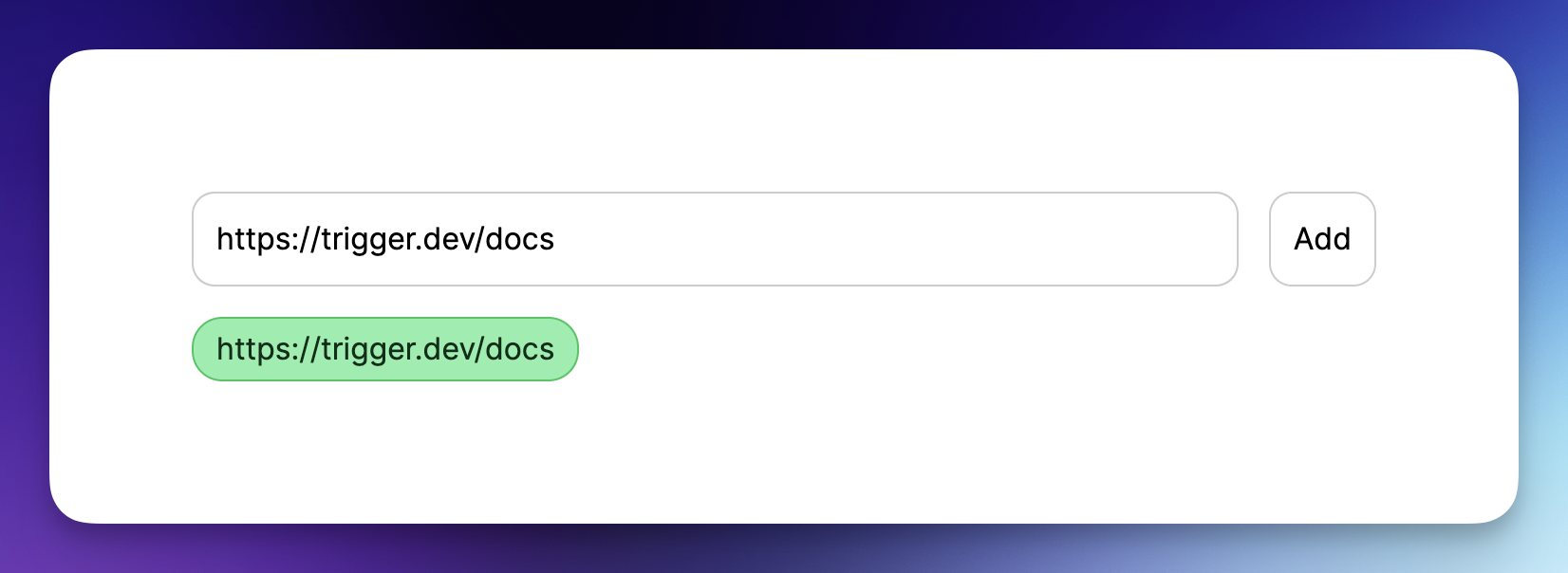 ### 首頁 將 `app/page.tsx` 的內容替換為以下程式碼: ``` import {getList} from "@openai-assistant/helper/get.list"; import Main from "@openai-assistant/components/main"; export default async function Home() { const list = await getList(); return ( <Main list={list} /> ) } ``` 這是一個簡單的程式碼,它從資料庫中取得清單並將其傳遞給我們的 Main 元件。 接下來,讓我們建立“Main”元件。 在「app」內建立一個新資料夾「components」並新增一個名為「main.tsx」的新檔案。 **新增以下程式碼:** ``` "use client"; import {Assistant} from '@prisma/client'; import {useCallback, useState} from "react"; import {FieldValues, SubmitHandler, useForm} from "react-hook-form"; import {ChatgptComponent} from "@openai-assistant/components/chatgpt.component"; import {AssistantList} from "@openai-assistant/components/assistant.list"; import {TriggerProvider} from "@trigger.dev/react"; export interface ExtendedAssistant extends Assistant { pending?: boolean; eventId?: string; } export default function Main({list}: {list: ExtendedAssistant[]}) { const [assistantState, setAssistantState] = useState(list); const {register, handleSubmit} = useForm(); const submit: SubmitHandler<FieldValues> = useCallback(async (data) => { const assistantResponse = await (await fetch('/api/assistant', { body: JSON.stringify({url: data.url}), method: 'POST', headers: { 'Content-Type': 'application/json' } })).json(); setAssistantState([...assistantState, {...assistantResponse, url: data.url, pending: true}]); }, [assistantState]) const changeStatus = useCallback((val: ExtendedAssistant) => async () => { const assistantResponse = await (await fetch(`/api/assistant?url=${val.url}`, { method: 'GET', headers: { 'Content-Type': 'application/json' } })).json(); setAssistantState([...assistantState.filter((v) => v.id), assistantResponse]); }, [assistantState]) return ( <TriggerProvider publicApiKey={process.env.NEXT_PUBLIC_TRIGGER_PUBLIC_API_KEY!}> <div className="w-full max-w-2xl mx-auto p-6 flex flex-col gap-4"> <form className="flex items-center space-x-4" onSubmit={handleSubmit(submit)}> <input className="flex-grow p-3 border border-black/20 rounded-xl" placeholder="Add documentation link" type="text" {...register('url', {required: 'true'})} /> <button className="flex-shrink p-3 border border-black/20 rounded-xl" type="submit"> Add </button> </form> <div className="divide-y-2 divide-gray-300 flex gap-2 flex-wrap"> {assistantState.map(val => ( <AssistantList key={val.url} val={val} onFinish={changeStatus(val)} /> ))} </div> {assistantState.filter(f => !f.pending).length > 0 && <ChatgptComponent list={assistantState} />} </div> </TriggerProvider> ) } ``` 讓我們看看這裡發生了什麼: - 我們建立了一個名為「ExtendedAssistant」的新接口,其中包含兩個參數「pending」和「eventId」。當我們建立一個新的助理時,我們沒有最終的值,我們將只儲存`eventId`並監聽作業處理直到完成。 - 我們從伺服器元件取得清單並將其設定為新狀態(以便我們稍後可以修改它) - 我們新增了「TriggerProvider」來幫助我們監聽事件完成並用資料更新它。 - 我們使用「react-hook-form」建立一個新表單來新增助手。 - 我們新增了一個帶有一個輸入「URL」的表單來提交新的助理進行處理。 - 我們迭代並顯示所有現有的助手。 - 在提交表單時,我們將資訊傳送到先前建立的「路由」以新增助理。 - 事件完成後,我們觸發「changeStatus」以從資料庫載入助手。 - 最後,我們有了 ChatGPT 元件,只有在沒有等待處理的助手時才會顯示(`!f.pending`) 讓我們建立 `AssistantList` 元件。 在「components」內,建立一個新檔案「assistant.list.tsx」並在其中加入以下內容: ``` "use client"; import {FC, useEffect} from "react"; import {ExtendedAssistant} from "@openai-assistant/components/main"; import {useEventRunDetails} from "@trigger.dev/react"; export const Loading: FC<{eventId: string, onFinish: () => void}> = (props) => { const {eventId} = props; const { data, error } = useEventRunDetails(eventId); useEffect(() => { if (!data || error) { return ; } if (data.status === 'SUCCESS') { props.onFinish(); } }, [data]); return <div className="pointer bg-yellow-300 border-yellow-500 p-1 px-3 text-yellow-950 border rounded-2xl">Loading</div> }; export const AssistantList: FC<{val: ExtendedAssistant, onFinish: () => void}> = (props) => { const {val, onFinish} = props; if (val.pending) { return <Loading eventId={val.eventId!} onFinish={onFinish} /> } return ( <div key={val.url} className="pointer relative bg-green-300 border-green-500 p-1 px-3 text-green-950 border rounded-2xl hover:bg-red-300 hover:border-red-500 hover:text-red-950 before:content-[attr(data-content)]" data-content={val.url} /> ) } ``` 我們迭代我們建立的所有助手。如果助手已經建立,我們只顯示名稱。如果沒有,我們渲染`<Loading />`元件。 載入元件在螢幕上顯示“正在載入”,並長時間輪詢伺服器直到事件完成。 我們使用 Trigger.dev 建立的 useEventRunDetails 函數來了解事件何時完成。 事件完成後,它會觸發「onFinish」函數,用新建立的助手更新我們的客戶端。 ### 聊天介面 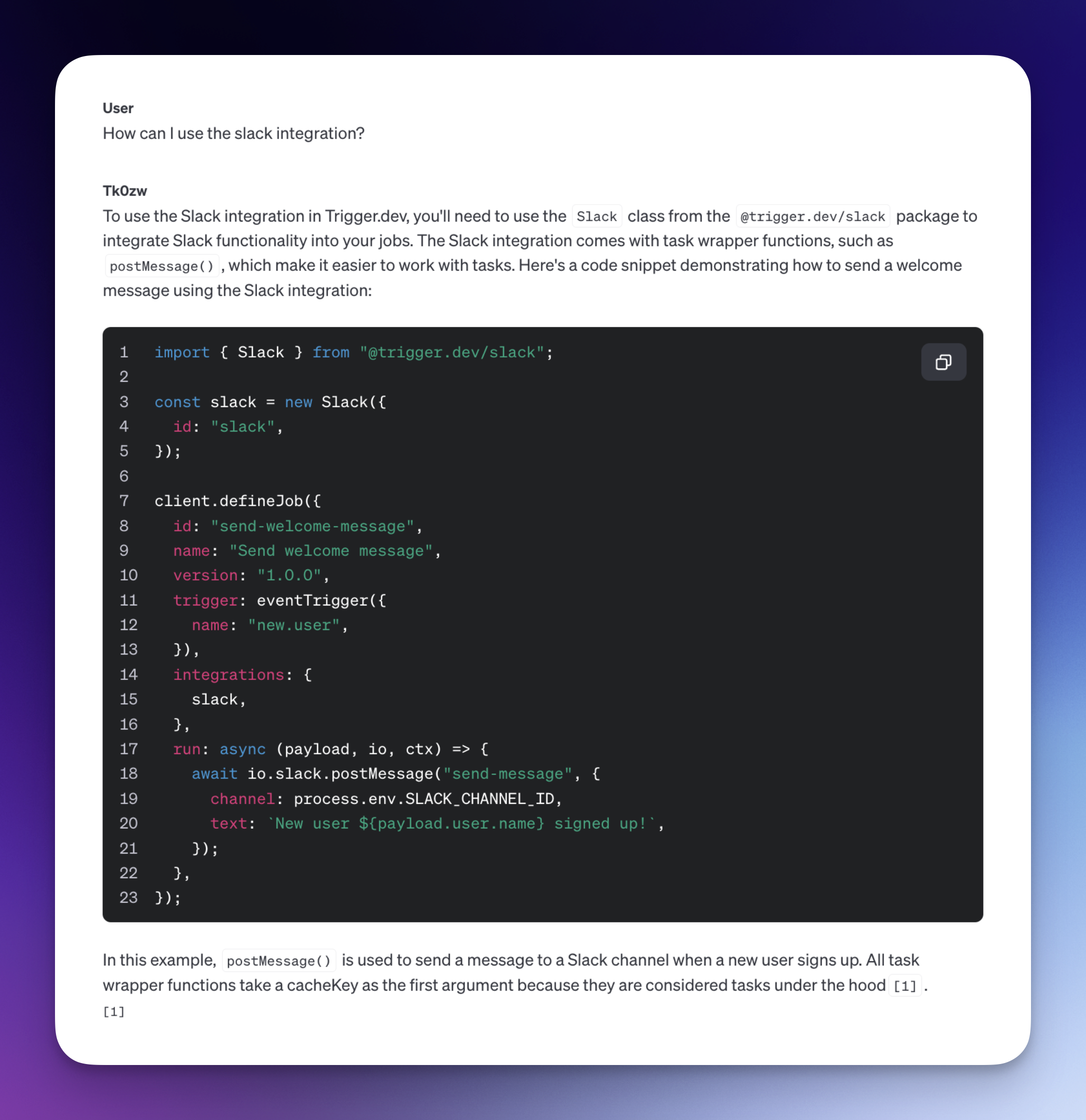 現在,讓我們加入 ChatGPT 元件並向我們的助手提問! - 選擇我們想要使用的助手 - 顯示訊息列表 - 新增我們要傳送的訊息的輸入和提交按鈕。 在「components」內部新增一個名為「chatgpt.component.tsx」的新文件 讓我們繪製 ChatGPT 聊天框: ``` "use client"; import {FC, useCallback, useEffect, useRef, useState} from "react"; import {ExtendedAssistant} from "@openai-assistant/components/main"; import Markdown from 'react-markdown' import {useEventRunDetails} from "@trigger.dev/react"; interface Messages { message?: string eventId?: string } export const ChatgptComponent = ({list}: {list: ExtendedAssistant[]}) => { const url = useRef<HTMLSelectElement>(null); const [message, setMessage] = useState(''); const [messagesList, setMessagesList] = useState([] as Messages[]); const [threadId, setThreadId] = useState<string>('' as string); const submitForm = useCallback(async (e: any) => { e.preventDefault(); setMessagesList((messages) => [...messages, {message: `**[ME]** ${message}`}]); setMessage(''); const messageResponse = await (await fetch('/api/message', { method: 'POST', body: JSON.stringify({message, id: url.current?.value, threadId}), })).json(); if (!threadId) { setThreadId(messageResponse.threadId); } setMessagesList((messages) => [...messages, {eventId: messageResponse.eventId}]); }, [message, messagesList, url, threadId]); return ( <div className="border border-black/50 rounded-2xl flex flex-col"> <div className="border-b border-b-black/50 h-[60px] gap-3 px-3 flex items-center"> <div>Assistant:</div> <div> <select ref={url} className="border border-black/20 rounded-xl p-2"> {list.filter(f => !f.pending).map(val => ( <option key={val.id} value={val.id}>{val.url}</option> ))} </select> </div> </div> <div className="flex-1 flex flex-col gap-3 py-3 w-full min-h-[500px] max-h-[1000px] overflow-y-auto overflow-x-hidden messages-list"> {messagesList.map((val, index) => ( <div key={index} className={`flex border-b border-b-black/20 pb-3 px-3`}> <div className="w-full"> {val.message ? <Markdown>{val.message}</Markdown> : <MessageComponent eventId={val.eventId!} onFinish={setThreadId} />} </div> </div> ))} </div> <form onSubmit={submitForm}> <div className="border-t border-t-black/50 h-[60px] gap-3 px-3 flex items-center"> <div className="flex-1"> <input value={message} onChange={(e) => setMessage(e.target.value)} className="read-only:opacity-20 outline-none border border-black/20 rounded-xl p-2 w-full" placeholder="Type your message here" /> </div> <div> <button className="border border-black/20 rounded-xl p-2 disabled:opacity-20" disabled={message.length < 3}>Send</button> </div> </div> </form> </div> ) } export const MessageComponent: FC<{eventId: string, onFinish: (threadId: string) => void}> = (props) => { const {eventId} = props; const { data, error } = useEventRunDetails(eventId); useEffect(() => { if (!data || error) { return ; } if (data.status === 'SUCCESS') { props.onFinish(data.output.threadId); } }, [data]); if (!data || error || data.status !== 'SUCCESS') { return ( <div className="flex justify-end items-center pb-3 px-3"> <div className="animate-spin rounded-full h-3 w-3 border-t-2 border-b-2 border-blue-500" /> </div> } return <Markdown>{data.output.content}</Markdown>; }; ``` 這裡正在發生一些令人興奮的事情: - 當我們建立新訊息時,我們會自動將其呈現在螢幕上作為「我們的」訊息,但是當我們將其發送到伺服器時,我們需要推送事件 ID,因為我們還沒有訊息。這就是我們使用 `{val.message ? <Markdown>{val.message}</Markdown> : <MessageComponent eventId={val.eventId!} onFinish={setThreadId} />}` - 我們用「Markdown」元件包裝訊息。如果您還記得,我們在前面的步驟中告訴 ChatGPT 以 MD 格式輸出所有內容,以便我們可以正確渲染它。 - 事件處理完成後,我們會更新線程 ID,以便我們從以下訊息中獲得相同對話的上下文。 我們就完成了🎉 ---  ## 讓我們聯絡吧! 🔌 作為開源開發者,您可以加入我們的[社群](https://discord.gg/nkqV9xBYWy) 做出貢獻並與維護者互動。請隨時造訪我們的 [GitHub 儲存庫](https://github.com/triggerdotdev/trigger.dev),貢獻並建立與 Trigger.dev 相關的問題。 本教學的源程式碼可在此處取得: [https://github.com/triggerdotdev/blog/tree/main/openai-assistant](https://github.com/triggerdotdev/blog/tree/main/openai-assistant) 感謝您的閱讀! --- 原文出處:https://dev.to/triggerdotdev/train-chatgpt-on-your-documentation-1a9g
曾經嘗試過在 Web 應用程式中使用 Docker 磁碟區進行熱重載嗎?如果你有跟我一樣可怕的經歷,你會喜歡 Docker 剛剛發布的最新功能:**docker-compose watch**!讓我向您展示如何升級現有專案以獲得出色的 Docker 開發設置,您的團隊*實際上*會喜歡使用它 🤩 TL;DR:看看這個 [docker-compose](https://github.com/Code42Cate/hackathon-starter/blob/main/docker-compose.yml) 檔案和 [官方文件](https://docs.docker.com/compose/file-watch/) 讓我們開始吧!  ## 介紹 Docker 剛剛發布了[Docker Compose Watch](https://docs.docker.com/compose/file-watch/) 和[Docker Compose Version 2.22](https://docs.docker.com/compose/release-notes/) #2220).有了這個新功能,您可以使用“docker-compose watch”代替“docker-compose up”,並自動將本機原始程式碼與 Docker 容器中的程式碼同步,而無需使用磁碟區! 讓我們透過使用我[之前寫過的](https://dev.project) 來看看它在實際專案中的工作原理。 在這個專案中,我有一個帶有前端、後端以及一些用於 UI 和資料庫的附加庫的 monorepo。 ``` ├── apps │ ├── api │ └── web └── packages ├── database ├── eslint-config-custom ├── tsconfig └── ui ``` 兩個應用程式(「api」和「web」)都已經進行了docker 化,而Dockerfile 位於專案的根目錄中([1](https://github.com/Code42Cate/hackathon-starter/blob/main/api.Dockerfile ), [2](https://github.com/Code42Cate/hackathon-starter/blob/main/web.Dockerfile)) `docker-compose.yml` 檔案如下所示: ``` services: web: build: dockerfile: web.Dockerfile ports: - "3000:3000" depends_on: - api api: build: dockerfile: api.Dockerfile ports: - "3001:3000"from within the Docker network ``` 這已經相當不錯了,但如您所知,在開發過程中使用它是一個 PITA。每當您更改程式碼時,您都必須重建 Docker 映像,即使您的應用程式可能支援開箱即用的熱重載(或使用 [Nodemon](https://www.npmjs.com/package/nodemon) 如果不)。 為了改善這一點,Docker Compose Watch [引入了一個新屬性](https://docs.docker.com/compose/file-watch/#configuration),稱為「watch」。 watch 屬性包含一個所謂的 **rules** 列表,每個規則都包含它們正在監視的 **path** 以及一旦路徑中的文件發生更改就會執行的 **action**。 ## 同步 如果您希望在主機和容器之間同步資料夾,您可以新增: ``` services: web: # shortened for clarity build: dockerfile: web.Dockerfile develop: watch: - action: sync path: ./apps/web target: /app/apps/web ``` 每當主機上的路徑“./apps/web/”中的檔案發生變更時,它將同步(複製)到容器的“/app/apps/web”。目標路徑中的附加應用程式是必要的,因為這是我們在 [Dockerfile](https://github.com/Code42Cate/hackathon-starter/blob/main/web.Dockerfile) 中定義的「WORKDIR」。如果您有可熱重新加載的應用程式,這可能是您可能會使用的主要內容。 ## 重建 如果您有需要編譯的應用程式或需要重新安裝的依賴項,還有一個名為 **rebuild** 的操作。它將重建並重新啟動容器,而不是簡單地在主機和容器之間複製檔案。這對你的 npm 依賴關係非常有幫助!讓我們補充一下: ``` services: web: # shortened for clarity build: dockerfile: web.Dockerfile develop: watch: - action: sync path: ./apps/web target: /app/apps/web - action: rebuild path: ./package.json target: /app/package.json ``` 每當我們的 package.json 發生變化時,我們都會重建整個 Dockerfile 以安裝新的依賴項。 ## 同步+重啟 除了同步和重建之外,中間還有一些稱為同步+重新啟動的操作。此操作將首先同步目錄,然後立即重新啟動容器而不重建。大多數框架通常都有無法熱重載的設定檔(例如「next.config.js」)(僅同步是不夠的),但也不需要緩慢重建。 這會將您的撰寫文件更改為: ``` services: web: # shortened for clarity build: dockerfile: web.Dockerfile develop: watch: - action: sync path: ./apps/web target: /app/apps/web - action: rebuild path: ./package.json target: /app/package.json - action: sync+restart path: ./apps/web/next.config.js target: /app/apps/web/next.config.js ``` ## 注意事項 一如既往,沒有[免費午餐](https://en.wikipedia.org/wiki/No_free_lunch_in_search_and_optimization)和一些警告😬 新的“watch”屬性的最大問題是路徑仍然非常基本。文件指出,尚不支援 Glob 模式,如果您想具體說明,這可能會導致「大量」規則。 以下是一些有效和無效的範例: ✅ `應用程式/網路` 這將會符合`./apps/web`中的*所有*檔案(例如`./apps/web/README.md`,還有`./apps/web/src/index.tsx`) ❌ `build/**/!(*.spec|*.bundle|*.min).js` 遺憾的是(還沒?) 支持 Glob ❌ `~/下載` 所有路徑都是相對於專案根目錄的! ## 下一步 如果您對 Docker 設定仍然不滿意,還有很多方法可以改進它! 協作是軟體開發的重要組成部分,[孤島工作](https://www.personio.com/hr-lexicon/working-in-silos/)可能會嚴重損害您的團隊。緩慢的 Docker 建置和複雜的設定沒有幫助!為了解決這個問題並促進協作文化,您可以使用 Docker 擴展,例如 [Livecycle](https://hub.docker.com/extensions/livecycle/docker-extension?utm_source=github&utm_medium=code42cate&utm_campaign=docker-composeub&utm_medium=code42cate&utm_campaign=docker-composeub&utm_medium=code42cate&utm_campaign=docker-composeub&utm_medium=code42cate&utm_campaign=docker-composeub&utm_medium=code42cate&utm_campaign=docker-composeub&utm_medium=code42cate&utm_campaign=docker-composeub&utm_medium=code42cate&utm_campaign=docker-composeub&utm_medium=code42cate&utm_campaign=docker-composeub&utm_medium=code42cate&utm_campaign=docker-composeub&utm)立即與您的隊友分享您本地的docker-compose 應用程式。由於您已經在使用 Docker 和 docker-compose,因此您需要做的就是安裝 [Docker 桌面擴充](https://hub.docker.com/extensions/livecycle/docker-extension?utm_source=github&utm_medium=code42cate&utm_campaign=hackathonstarter )並點擊共享切換按鈕。然後,您的應用程式將透過隧道連接到網路,您可以與您的團隊分享您的唯一 URL 以獲取回饋!如果您想查看 Livecycle 的更多用例,我在[這篇文章](https://dev.to/code42cate/how-to-win-any-hackathon-3i99)中寫了更多相關內容:) 像往常一樣,確保您的 Dockerfile 遵循最佳實踐,尤其是在多階段建置和快取方面。雖然這可能會使編寫初始 Dockerfile 變得更加困難,但它將使您的 Docker 應用程式在開發過程中使用起來更加愉快。 建立一個基本的“.dockerignore”檔案並將依賴項安裝與程式碼建置分開還有很長的路要走! ## 結論 一如既往,我希望你今天學到新東西了!如果您在設定 Docker 專案時需要任何協助,或者您有任何其他回饋,請告訴我 乾杯,喬納斯:D --- 原文出處:https://dev.to/code42cate/say-goodbye-to-docker-volumes-j9l
## TL;DR 🔍 探索在 Kubernetes 上部署 GitLab 的逐步指南,並專注於 Omnibus 套件配置。了解如何設定 PostgreSQL、SMTP、Container Registry、Sidekiq、Prometheus 指標和備份。使用 Glasskube GitLab Kubernetes Operator 探索替代方案,簡化流程並將設定時間縮短至僅 5 分鐘。 --- ## 我們需要您的回饋! 🫶 在下面的評論中分享您的想法!讓我們知道您想要更多內容的主題。如果本指南有幫助,請點擊貓並留下一顆星,以支持我們建立更多以開發人員為中心的內容。您的回饋很重要! [ ](https://github.com/glasskube/operator) --- ## 讓我們開始吧🏌️ [GitLab](https://glasskube.eu/en/s/kubernetes-operator/gitlab/) 是一個以軟體工程團隊為導向的開源 DevSecOps 平台。 有兩種方式可用於在 Kubernetes 叢集上部署 GitLab: 1.GitLab雲端原生混合 2.GitLab包(綜合) ## GitLab 雲端原生混合 部署 GitLab Cloud 原生混合架構僅在查詢特定用例中才有意義。例如 - 如 [GitLab 決策樹](https://docs.gitlab.com/ee/administration/reference_architectures/#decision-tree) 所示 - 如果 GitLab 實例需要為至少 3,000 個使用者提供服務。對於這種部署,GitLab 元件將單獨安裝在不同的 docker 容器中。最低要求為 10 個節點,總共 19 個 vCPU 和 60 GB 內存,這將導致每月數千美元的雲端成本。 <img width="100%" style="width:100%" src="https://media.giphy.com/media/v1.Y2lkPTc5MGI3NjExbHl6eXltNWw0ZDNjbnNqbDdicXBpbzNpdX6e nlfaWQmY 3Q9Zw/2aIZfQdC2V7bBvU5t2/giphy.gif"> 因此,在大多數情況下,GitLab 雲端原生是不需要的,而且過於複雜。 **那麼,如何在 Kubernetes 上部署 GitLab Omnibus?** ## Kubernetes 上的 GitLab Omnibus 使用「omnibus」這個名稱,GitLab 也發布了一體化軟體包,這些軟體包可以作為docker 映像[`hub.docker.com/r/gitlab/gitlab-ce`](https://hub.docker. com /r/gitlab/gitlab-ce),可以透過環境變數輕鬆配置。正確進行設定可以輕鬆在 Kubernetes 上部署 GitLab。 應正確配置以下重要元件,以便歸檔合理的 Kubernetes 設定: 1.PostgreSQL資料庫 2. SMTP配置 3. Kubernetes 上的 GitLab 容器註冊表 4. Sidekiq、Gitaly 和 Puma 配置 5. 普羅米修斯指標 6. Kubernetes 上的 GitLab 備份 ### Kubernetes 上的 GitLab:設定外部 PostgreSQL 資料庫 建立 PostgreSQL 資料庫可以使用 [CloudNativePG PostgreSQL Operator](https://cloudnative-pg.io/) 來完成。安裝完 Operator 後,可以透過套用 Kubernetes CR 來部署新的 Postgres 叢集: ``` kind: Cluster apiVersion: postgresql.cnpg.io/v1 metadata: name: gitlab spec: enableSuperuserAccess: false instances: 2 bootstrap: initdb: database: gitlabhq_production owner: gitlab storage: size: 20Gi ``` 重要的是,資料庫名稱為“gitlabhq_product”,而配置的“gitlab”資料庫使用者是資料庫的擁有者。在本例中,我們建立了一個由兩個 PostgreSQL 副本組成的集群,以確保資料庫保持可用,即使執行主副本的節點發生故障也是如此。這稱為高可用性 (HA)。 現在,我們建立了自己的 PostgreSQL 集群,必須在「gitlab.rb」檔案中停用綜合映像中包含的資料庫。 ``` postgresql['enable'] = false gitlab_rails['db_adapter'] = 'postgresql' gitlab_rails['db_encoding'] = 'unicode' gitlab_rails['db_host'] = 'gitlab-pg-rw' gitlab_rails['db_password'] = '<your-password>' ``` 很好,我們已經為 GitLab 安裝提供了雲端原生資料庫。 <img width="25%" style="width:25%" src="https://media.giphy.com/media/v1.Y2lkPTc5MGI3NjExc2VydjJoN3BsN2RycDY5N3prZHhoaW8xdTYxenJoN3BsN2RycDY5N3prZHhoaW8xdTYxenhkbHdtBlcMpm30FmDFt0Fyg n;ipPlcmDMlcM40M400005450000200020025400000 mY3 Q9Zw/SVH9y2LQUVVCRcqD7o/giphy.gif"> #### Kubernetes 上的 GitLab:設定 SMTP 憑證 為了確保您的 GitLab 實例能夠傳送電子郵件,您需要設定 SMTP 伺服器。這也可以在 `gitlab.rb` 檔案中完成。 ``` gitlab_rails['smtp_enable'] = ... gitlab_rails['smtp_address'] = ... gitlab_rails['smtp_port'] = ... gitlab_rails['smtp_user_name'] = ... gitlab_rails['smtp_password'] = ... gitlab_rails['smtp_tls'] = ... gitlab_rails['gitlab_email_from'] = ... ``` 例如,可以在 Brevo 平台上建立用於交易電子郵件的免費 smtp 伺服器。 <img width="25%" style="width:25%" src="https://media.giphy.com/media/0IR3vO2bWY1AQPAsAn/giphy.gif"> #### Kubernetes 上的 GitLab:容器註冊表 在眾多功能中,GitLab 支援充當容器註冊表。這是透過捆綁 docker 容器註冊表的參考實作來實現的,但預設情況下它是禁用的,因為正確設定它相當麻煩。 > **重要** > 重要的是要了解 GitLab 綜合容器中的所有請求將首先由內部 nginx 伺服器處理,然後分發到元件。 容器註冊表僅適用於 TLS 加密連接,因此我們需要透過入口負載平衡器停用 TLS 終止,並將加密流量直接傳送到 GitLab 容器。如果使用 NGINX 入口控制器,可以透過在入口中新增以下註解來完成:「nginx.ingress.kubernetes.io/ssl-passthrough: true」。 之後,必須套用以下`gitlab.rb`配置: ``` registry['enable'] = true gitlab_rails['registry_enabled'] = true registry['token_realm'] = "https://" + ENV['GITLAB_HOST'] gitlab_rails['registry_enabled'] = true gitlab_rails['registry_host'] = ENV['GITLAB_REGISTRY_HOST'] gitlab_rails['registry_api_url'] = "http://localhost:5000" registry_external_url 'https://' + ENV['GITLAB_REGISTRY_HOST'] registry_nginx['redirect_http_to_https'] = true registry_nginx['listen_port'] = 5443 registry_nginx['ssl_certificate'] = "/etc/gitlab/ssl/tls.crt" registry_nginx['ssl_certificate_key'] = "/etc/gitlab/ssl/tls.key" registry_nginx['real_ip_trusted_addresses'] = ['10.0.0.0/8', '172.16.0.0/12', '192.168.0.0/16'] registry_nginx['server_names_hash_bucket_size'] = 128 ``` 此外,可以配置 S3 儲存桶(或相容的雲端儲存端點),以便所有影像層不會儲存在磁碟區內,而是儲存在可擴充的 S3 中 ### Kubernetes 上的 GitLab:Sidekiq、Gitaly 和 Puma 配置 Puma(Ruby 的 HTTP 伺服器)、Sidekiq(作業排程器)和 Gitaly(GitLabs Git 橋接器)都可以使用自訂數量的工作執行緒/執行緒來啟動。最佳配置在很大程度上取決於您的用例和需要支援的使用者數量。合理的最小配置是: ``` puma['worker_processes'] = 2 sidekiq['max_concurrency'] = 9 ``` ### Kubernetes 上的 GitLab:Prometheus 指標 GitLab 綜合包在鏡像中附帶了自己的 prometheus 實例。由於大多數 Kubernetes 叢集中已經存在 Prometheus 實例,因此可以安全地停用包含的 Prometheus。 ``` prometheus_monitoring['enable'] = false ``` ServiceMonitor 可以用來告訴正在執行的 Prometheus 實例在下列連接埠上監視 GitLabs 元件所公開的指標端點: - 8082(sidekiq) - 9168(gitlab) - 9236(義大利) ### Kubernetes 上的 GitLab:備份 嗯,在 Kubernetes 上備份 GitLab 本身就是一個技術指南。最簡單的方法是使用 [Velero](https://velero.io/) 等備份解決方案備份完整的命名空間。 ## 玻璃立方體 GitLab Kubernetes Operator 了解Glasskube GitLab [Kubernetes Operator](https://glasskube.eu/en/r/glossary/kubernetes-operator/) - 我們的開發團隊對繁瑣的配置過程、耗時的設定和不斷的故障排除感到沮喪的產物與 GitLab 部署相關。為了應對這些挑戰,我們精心設計了一個簡化整個體驗的解決方案。 Glasskube GitLab Kubernetes Operator 部署一個完全配置的 GitLab 實例,其所有功能均透過自訂資源定義 (CRD) 巧妙抽象化。感謝操作員,花費過多時間進行設定和更新的日子已經結束。現在,您可以在短短 5 分鐘內輕鬆啟動新的 GitLab 實例。嘗試一下並向我們提供反饋! ### 安裝 Glasskube 運算符 第一步是透過 Helm Chart 安裝 Glasskube: ``` helm repo add glasskube https://charts.glasskube.eu/ helm repo update helm install my-glasskube-operator glasskube/glasskube-operator ``` 完整的文件可以在我們的[入門](https://glasskube.eu/docs/getting-started/install/)文件中找到。 ### 部署 GitLab > **重要** > 必須在「LoadBalancer」或「Ingress Host」上設定 DNS 專案。 SSL 憑證是 > 如果配置了“ClusterIssuer”,則由“LoadBalancer”或“cert-manager”自動產生。 **gitlab.yaml** ``` apiVersion: "v1" kind: "Secret" metadata: name: "gitlab-smtp" stringData: username: "..." password: "..." --- apiVersion: v1 kind: Secret metadata: name: gitlab-registry-secret stringData: accessKey: "..." secretKey: "..." --- apiVersion: "glasskube.eu/v1alpha1" kind: "Gitlab" metadata: name: "gitlab" spec: host: "gitlab.mycompany.eu" sshEnabled: true sshHost: "ssh.gitlab.mycompany.eu" smtp: host: "..." port: 465 fromAddress: "[email protected]" authSecret: name: "gitlab-smtp" tlsEnabled: true registry: host: "registry.gitlab.mycompany.eu" storage: s3: bucket: gitlab-registry accessKeySecret: name: gitlab-registry-secret key: accessKey secretKeySecret: name: gitlab-registry-secret key: secretKey region: ... ``` ``` kubectl apply -f gitlab.yaml ``` <img width="25%" style="width:25%" src="https://media.giphy.com/media/v1.Y2lkPTc5MGI3NjExa2RldHpiYnMzOWdlZTgwdWtqOHN3N3eG9I0NjVyd2l4m Y3Q9Zw/YRhUem7n2UaF9EK2PH/giphy.gif"> 就是這樣! 完整的自訂資源文件可以在 Glasskube 文件中找到 關於 [GitLab](https://glasskube.eu/docs/crd-reference/gitlab/) ### 在 Kubernetes 上部署 GitLab Runner <img width="25%" style="width:25%" src="https://media.giphy.com/media/v1.Y2lkPTc5MGI3NjExZDJsN2x6NTI0dWdhZW55MjBzMjFobHdtbDRtaHEycXlidWdhZW55MjBzMjFobHdtbDRtaHEycXlidWdhZW55MjBzMjFobHdtbDRtaHEycXlidGt. WQmY 3Q9Zw/945jGDodvZCDe/giphy.gif"> GitLab 上的運作程序是為持續整合和持續交付 (CI/CD) 管道提供支援的執行代理。 他們負責執行作業,即管道中的各個步驟或任務。 Glasskube Gitlab Kubernetes Operator 讓在 Gitlab 中新增執行器變得如此簡單。首先,需要透過「https://{{host}}/admin/runners/new」建立一個新的執行程式。之後,這些執行器令牌只需加入到「gitlab.yaml」規格中,Glasskube Kubernetes Operator 將自動產生並將這些執行器與 Gitlab 實例連接起來。 ``` runners: - token: glrt-xxxxXX-xxxxxXXXXX # can be generated at https://{{host}}/admin/runners/new ``` 完整的自訂資源文件可以在關於 [GitLab runner] 的 Glasskube 文件中找到(https://glasskube.eu/docs/crd-reference/gitlab/runner/) 現在安裝完成了。 Kubernetes Operator 的更新將自動更新 GitLab。 ## 結論 在 Kubernetes 上為少於 1000 個使用者部署 GitLab 實例不應該使用 GitLabs 雲端原生混合 Helm Charts 來完成,而應該使用專門安裝的 GitLab Omnibus 套件與雲端原生基礎架構結合來完成。 Glasskube Kubernetes 操作員負責處理這個問題。 --- [ ](https://github.com/glasskube/operator) --- 星星冰塊: # [`glasskube/operator`](https://github.com/glasskube/operator) --- 原文出處:https://dev.to/glasskube/gitlab-on-kubernetes-the-ultimate-deployment-guide-188b
## 長篇大論;博士 如今,任何開發人員都可以利用人工智慧來建立強大的東西。 無需成為機器學習專家。 這裡有 7 個最好的庫,您可以使用它來增強您的開發並透過最先進的 AI 功能給用戶留下深刻的印象。 這些可以為你的專案帶來神奇的力量,所以不要忘記給他們加星號並支持他們🌟  --- ## 1. [CopilotKit](https://github.com/RecursivelyAI/CopilotKit):將 AI 功能引入 React 應用程式。 (ChatBot 和 CopilotTexarea)  常見的法學碩士產品用例被製作成簡單且可自訂的反應元件。 具有兩個元件: CopilotPortal:加入可以在您的應用程式內回答問題並採取行動的法學碩士! CopilotTextarea:任何具有 Github Copilot 功能的 <textarea/> 的直接替代品。 ``` import "@copilotkit/react-ui/styles.css"; import { CopilotProvider } from "@copilotkit/react-core"; import { CopilotSidebarUIProvider } from "@copilotkit/react-ui"; export default function App(): JSX.Element { return ( <CopilotProvider chatApiEndpoint="/api/copilotkit/chat"> <CopilotSidebarUIProvider> <YourContent /> </CopilotSidebarUIProvider> </CopilotProvider> ); } ``` {% cta https://github.com/RecursivelyAI/CopilotKit %} Star CopilotKit ⭐️ {% endcta %} --- ## 2. Tavily GPT 研究員 - 取得法學碩士學位以搜尋網路和資料庫  Tavilly 可讓您將 GPT 支援的研究和內容產生工具新增至您的 React 應用程式中,從而增強其資料處理和內容建立功能。 ``` # Create an assistant assistant = client.beta.assistants.create( instructions=assistant_prompt_instruction, model="gpt-4-1106-preview", tools=[{ "type": "function", "function": { "name": "tavily_search", "description": "Get information on recent events from the web.", "parameters": { "type": "object", "properties": { "query": {"type": "string", "description": "The search query to use. For example: 'Latest news on Nvidia stock performance'"}, }, "required": ["query"] } } }] ) ``` {% cta https://github.com/assafelovic/gpt-researcher %} 明星塔維利 ⭐️ {% endcta %} --- ## 3. Pezzo.ai - 可觀測性、成本和即時工程平台  用於管理 OpenAI 通話的集中平台。 優化您的提示和令牌使用。追蹤您的人工智慧使用情況。 免費且易於整合。 ``` const prompt = await pezzo.getPrompt("AnalyzeSentiment"); const response = await openai.chat.completions.create(prompt); ``` {% cta https://github.com/pezzolabs/pezzo %} 明星 Pezzo ⭐️ {% endcta %} --- ## 4. LangChain - 將人工智慧整合到行動鏈中。  易於使用的 API 和函式庫,用於將 LLM 新增到應用程式中。 將不同的人工智慧元件和模型連接在一起。 輕鬆嵌入上下文和語義資料以實現強大的整合。 ``` from langchain.llms import OpenAI from langchain import PromptTemplate llm = OpenAI(model_name="text-davinci-003", openai_api_key="YourAPIKey") # Notice "food" below, that is a placeholder for another value later template = """ I really want to eat {food}. How much should I eat? Respond in one short sentence """ prompt = PromptTemplate( input_variables=["food"], template=template, ) final_prompt = prompt.format(food="Chicken") print(f"Final Prompt: {final_prompt}") print("-----------") print(f"LLM Output: {llm(final_prompt)}") ``` {% cta https://github.com/langchain-ai/langchain %} 星朗鏈 ⭐️ {% endcta %} --- ## 5. [Weaviate](https://github.com/weaviate/weaviate) - 用於人工智慧增強專案的向量資料庫 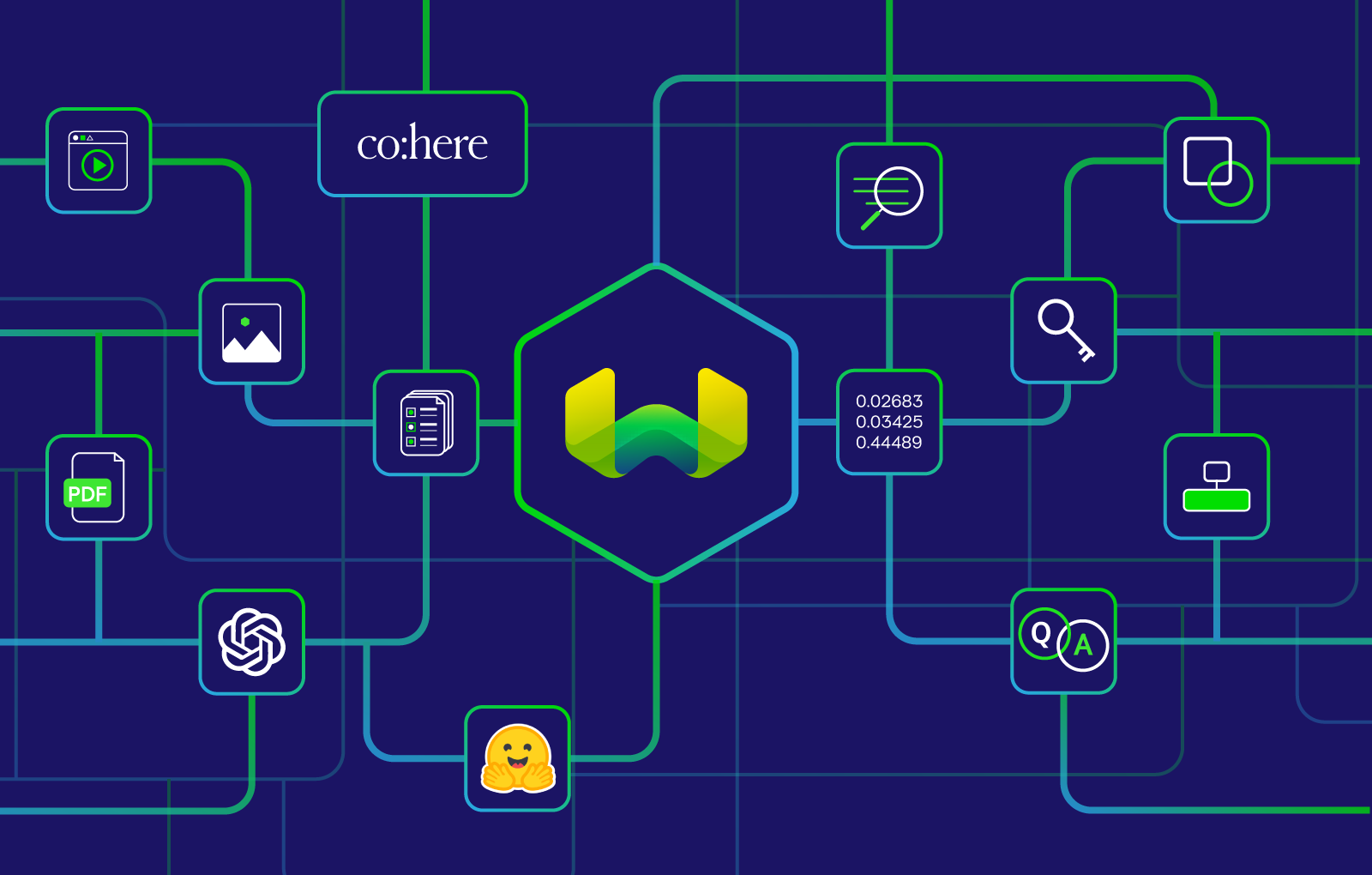 Weaviate 是一個針對大型資料集快速、高效搜尋而最佳化的向量資料庫。 它支援與 OpenAI 和 Hugging Face 等提供者的 AI 模型和服務集成,從而實現資料分類和自然語言處理等高級任務。 它是一種雲端原生解決方案,具有高度可擴展性,可以滿足不斷變化的資料需求。 ``` import weaviate import json client = weaviate.Client( embedded_options=weaviate.embedded.EmbeddedOptions(), ) uuid = client.data_object.create({ }) obj = client.data_object.get_by_id(uuid, class_name='MyClass') print(json.dumps(obj, indent=2)) ``` {% cta https://github.com/weaviate/weaviate %} 星織 ⭐️ {% endcta %} --- ## 6. [PrivateGPT](https://github.com/imartinez/privateGPT) - 與您的文件聊天,100% 私密 💡 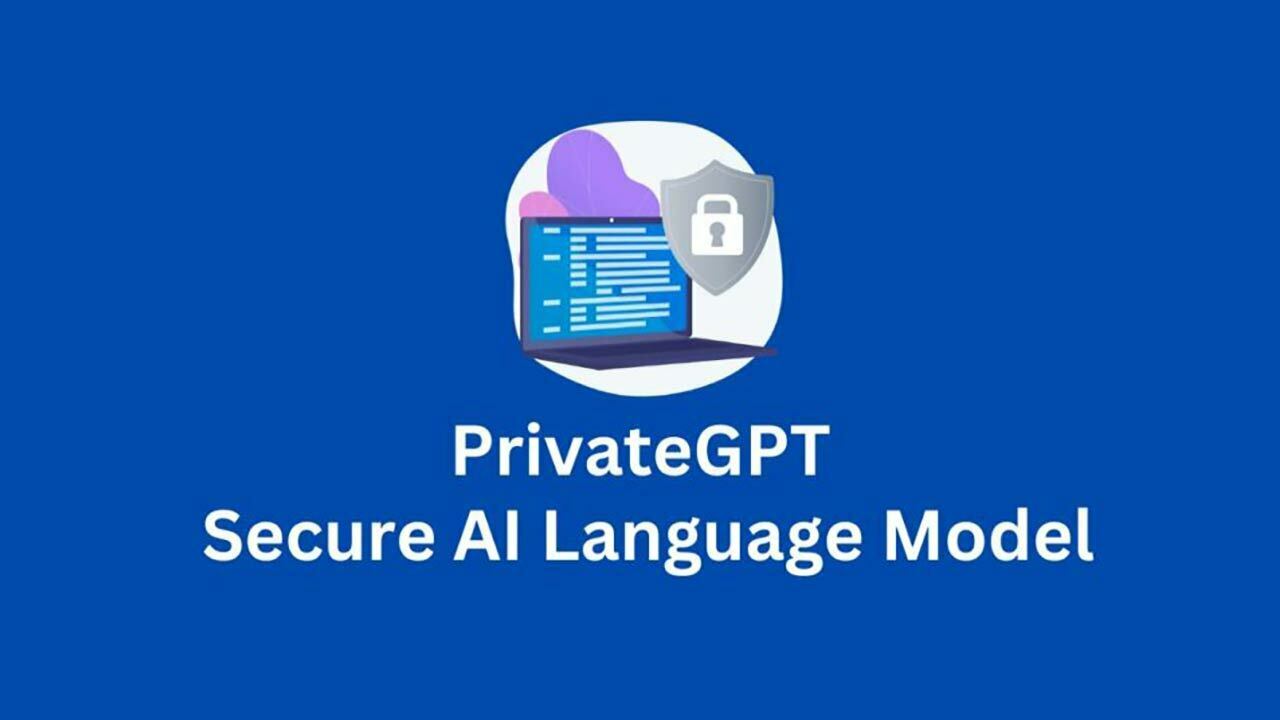 PrivateGPT 允許在應用程式內進行安全的、GPT 驅動的文件交互,確保資料隱私並增強上下文感知處理能力。 PrivateGPT 透過本地處理和儲存文件和上下文來確保隱私,而無需將資料傳送到外部伺服器。 ``` from privategpt import PrivateGPT, DocumentIngestion, ChatCompletion client = PrivateGPT(api_key='your_api_key') def process_documents_and_chat(query, documents): ingestion_result = DocumentIngestion(client, documents) chat_result = ChatCompletion(client, query, context=ingestion_result.context) return chat_result documents = ['doc1.txt', 'doc2.txt'] query = "What is the summary of the documents?" result = process_documents_and_chat(query, documents) print(result) ``` {% cta https://github.com/weaviate/weaviate %} 星織 ⭐️ {% endcta %} --- ## 7. SwirlSearch - 人工智慧驅動的搜尋。  LLM 支援的搜尋、摘要和輸出。 同時搜尋多個內容來源並產生整合輸出。 功能強大,可自訂各種資料來源的應用程式內整合。 {% cta https://github.com/swirlai/swirl-search %} 星旋搜尋 ⭐️ {% endcta %} --- 謝謝閱讀! 我希望這些可以幫助您使用人工智慧建立一些很棒的東西。 如果您喜歡並評論您想看到的任何其他庫或主題,請按讚。 --- 原文出處:https://dev.to/copilotkit/7-ai-libraries-every-dev-needs-to-know-to-be-a-wiz-4lim
資料管道是任何資料密集型專案的支柱。 **隨著資料集的成長**超出記憶體大小(「核心外」),**有效處理它們變得具有挑戰性**。 Dask 可以輕鬆管理大型資料集(核心外),提供與 Numpy 和 Pandas 的良好相容性。  --- 本文重點介紹 **Dask(用於處理核心外資料)與 Taipy** 的無縫集成,Taipy** 是一個用於 **管道編排和場景管理** 的 Python 庫。 --- ## Taipy - 您的 Web 應用程式建構器 關於我們的一些資訊。 **Taipy** 是一個開源程式庫,旨在輕鬆開發前端 (GUI) 和 ML/資料管道。 不需要其他知識(沒有 CSS,什麼都不需要!)。 它旨在加快應用程式開發,從最初的原型到生產就緒的應用程式。  https://github.com/Avaiga/taipy 我們已經快有 1000 顆星了,沒有你就無法做到這一點🙏 --- ## 1. 範例應用程式 透過範例最好地演示了 Dask 和 Taipy 的整合。在本文中,我們將考慮包含 4 個任務的資料工作流程: - **資料預處理與客戶評分** 使用 Dask 讀取和處理大型資料集。 - **特徵工程和分割** 根據購買行為對客戶進行評分。 - **細分分析** 根據這些分數和其他因素將客戶分為不同的類別。 - **高價值客戶的總統計** 分析每個客戶群以獲得見解 我們將更詳細地探討這 4 個任務的程式碼。 請注意,此程式碼是您的 Python 程式碼,並未使用 Taipy。 在後面的部分中,我們將展示如何使用 Taipy 對現有資料應用程式進行建模,並輕鬆獲得其工作流程編排的好處。 --- 該應用程式將包含以下 5 個檔案: ``` algos/ ├─ algo.py # Our existing code with 4 tasks data/ ├─ SMALL_amazon_customers_data.csv # A sample dataset app.ipynb # Jupyter Notebook for running our sample data application config.py # Taipy configuration which models our data workflow config.toml # (Optional) Taipy configuration in TOML made using Taipy Studio ``` --- ## 2. Taipy 簡介 - 綜合解決方案 [Taipy](https://docs.taipy.io/) **不只是另一個編排工具**。 Taipy 專為 ML 工程師、資料科學家和 Python 開發人員設計,帶來了幾個基本且簡單的功能。 以下是**一些關鍵要素**,使 Taipy 成為令人信服的選擇: 1. **管道執行註冊表** 此功能使開發人員和最終用戶能夠: - 將每個管道執行註冊為「*場景*」(任務和資料節點圖); - 精確追蹤每個管道執行的沿襲;和 - 輕鬆比較場景、監控 KPI 並為故障排除和微調參數提供寶貴的見解。 2. **管道版本控制** Taipy 強大的場景管理使您能夠輕鬆調整管道以適應不斷變化的專案需求。 3. **智能任務編排** Taipy 讓開發人員可以輕鬆地對任務和資料來源網路進行建模。 此功能透過以下方式提供對任務執行的內建控制: - 並行執行您的任務;和 - 任務“跳過”,即選擇要執行的任務並 要繞過哪個。 4. **任務編排的模組化方法** 模組化不僅僅是 Taipy 的一個流行詞;這是一個核心原則。 設定可以互換使用的任務和資料來源,從而產生更乾淨、更易於維護的程式碼庫。 --- ## 3. Dask 簡介 Dask 是一個流行的分散式運算 Python 套件。 Dask API 實作了熟悉的 Pandas、Numpy 和 Scikit-learn API - ,這使得許多已經熟悉這些 API 的資料科學家更愉快地學習和使用 Dask。 如果您是 Dask 新手,請查看 Dask 團隊撰寫的精彩 Dask [10 分鐘簡介](https://docs.dask.org/en/stable/10-minutes-to-dask.html)。 --- ## 4. 應用:顧客分析 (*algos/algo.py*) 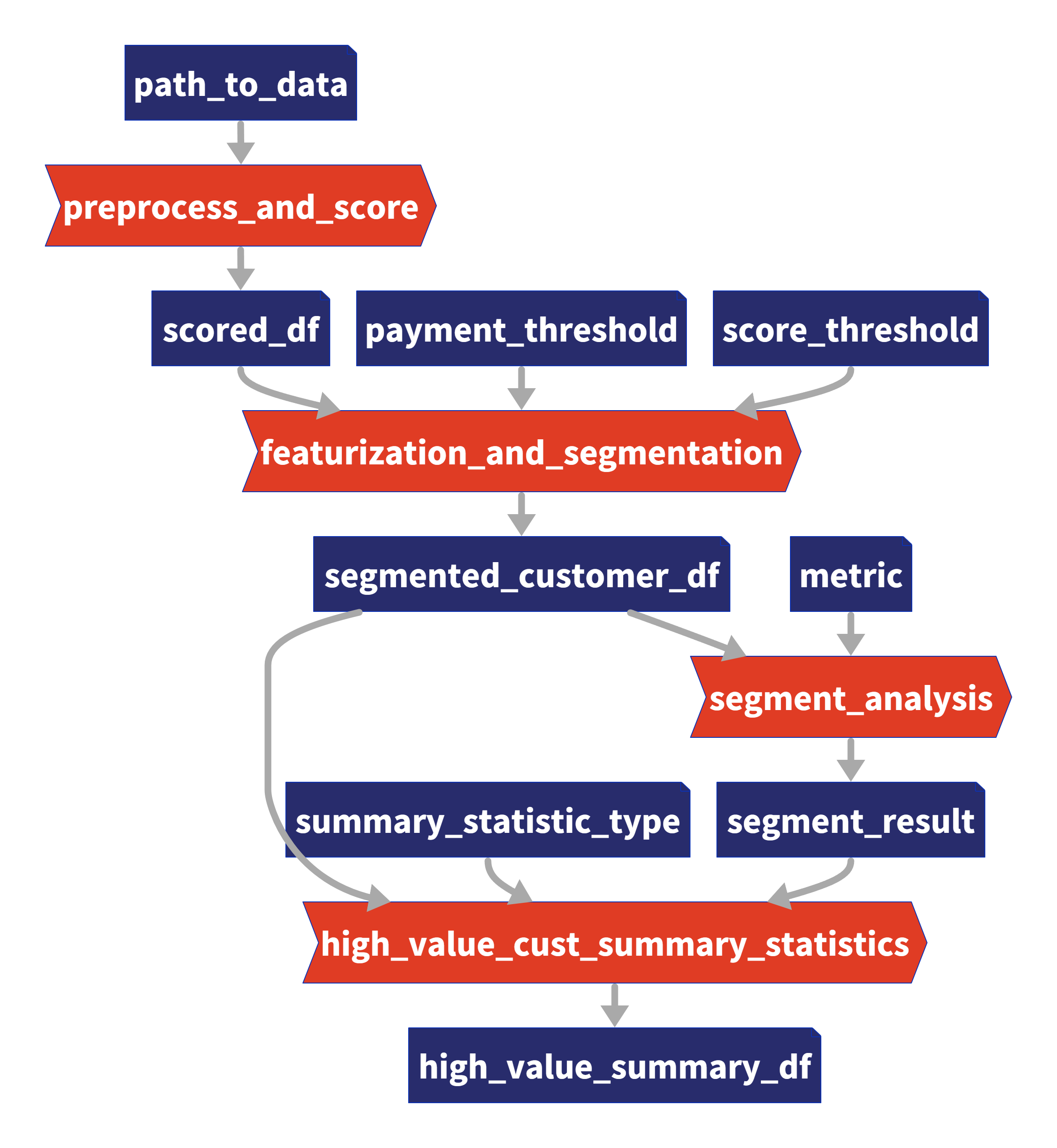 *我們的 4 項任務的圖表(在 Taipy 中可視化),我們將在下一節中對其進行建模。* 我們現有的程式碼(不含 Taipy)包含 4 個函數,您也可以在上圖中看到: - 任務 1:*預處理和評分* - 任務 2:*特徵化與細分* - 任務 3:*分段分析* - 任務 4:*high_value_cust_summary_statistics* 您可以瀏覽以下定義了 4 個函數的 *algos/algo.py* 腳本,然後繼續閱讀每個函數的簡要說明: ``` ### algos/algo.py import time import dask.dataframe as dd import pandas as pd def preprocess_and_score(path_to_original_data: str): print("__________________________________________________________") print("1. TASK 1: DATA PREPROCESSING AND CUSTOMER SCORING ...") start_time = time.perf_counter() # Start the timer # Step 1: Read data using Dask df = dd.read_csv(path_to_original_data) # Step 2: Simplify the customer scoring formula df["CUSTOMER_SCORE"] = ( 0.5 * df["TotalPurchaseAmount"] / 1000 + 0.3 * df["NumberOfPurchases"] / 10 + 0.2 * df["AverageReviewScore"] ) # Save all customers to a new CSV file scored_df = df[["CUSTOMER_SCORE", "TotalPurchaseAmount", "NumberOfPurchases", "TotalPurchaseTime"]] pd_df = scored_df.compute() end_time = time.perf_counter() # Stop the timer execution_time = (end_time - start_time) * 1000 # Calculate the time in milliseconds print(f"Time of Execution: {execution_time:.4f} ms") return pd_df def featurization_and_segmentation(scored_df, payment_threshold, score_threshold): print("__________________________________________________________") print("2. TASK 2: FEATURE ENGINEERING AND SEGMENTATION ...") # payment_threshold, score_threshold = float(payment_threshold), float(score_threshold) start_time = time.perf_counter() # Start the timer df = scored_df # Feature: Indicator if customer's total purchase is above the payment threshold df["HighSpender"] = (df["TotalPurchaseAmount"] > payment_threshold).astype(int) # Feature: Average time between purchases df["AverageTimeBetweenPurchases"] = df["TotalPurchaseTime"] / df["NumberOfPurchases"] # Additional computationally intensive features df["Interaction1"] = df["TotalPurchaseAmount"] * df["NumberOfPurchases"] df["Interaction2"] = df["TotalPurchaseTime"] * df["CUSTOMER_SCORE"] df["PolynomialFeature"] = df["TotalPurchaseAmount"] ** 2 # Segment customers based on the score_threshold df["ValueSegment"] = ["High Value" if score > score_threshold else "Low Value" for score in df["CUSTOMER_SCORE"]] end_time = time.perf_counter() # Stop the timer execution_time = (end_time - start_time) * 1000 # Calculate the time in milliseconds print(f"Time of Execution: {execution_time:.4f} ms") return df def segment_analysis(df: pd.DataFrame, metric): print("__________________________________________________________") print("3. TASK 3: SEGMENT ANALYSIS ...") start_time = time.perf_counter() # Start the timer # Detailed analysis for each segment: mean/median of various metrics segment_analysis = ( df.groupby("ValueSegment") .agg( { "CUSTOMER_SCORE": metric, "TotalPurchaseAmount": metric, "NumberOfPurchases": metric, "TotalPurchaseTime": metric, "HighSpender": "sum", # Total number of high spenders in each segment "AverageTimeBetweenPurchases": metric, } ) .reset_index() ) end_time = time.perf_counter() # Stop the timer execution_time = (end_time - start_time) * 1000 # Calculate the time in milliseconds print(f"Time of Execution: {execution_time:.4f} ms") return segment_analysis def high_value_cust_summary_statistics(df: pd.DataFrame, segment_analysis: pd.DataFrame, summary_statistic_type: str): print("__________________________________________________________") print("4. TASK 4: ADDITIONAL ANALYSIS BASED ON SEGMENT ANALYSIS ...") start_time = time.perf_counter() # Start the timer # Filter out the High Value customers high_value_customers = df[df["ValueSegment"] == "High Value"] # Use summary_statistic_type to calculate different types of summary statistics if summary_statistic_type == "mean": average_purchase_high_value = high_value_customers["TotalPurchaseAmount"].mean() elif summary_statistic_type == "median": average_purchase_high_value = high_value_customers["TotalPurchaseAmount"].median() elif summary_statistic_type == "max": average_purchase_high_value = high_value_customers["TotalPurchaseAmount"].max() elif summary_statistic_type == "min": average_purchase_high_value = high_value_customers["TotalPurchaseAmount"].min() median_score_high_value = high_value_customers["CUSTOMER_SCORE"].median() # Fetch the summary statistic for 'TotalPurchaseAmount' for High Value customers from segment_analysis segment_statistic_high_value = segment_analysis.loc[ segment_analysis["ValueSegment"] == "High Value", "TotalPurchaseAmount" ].values[0] # Create a DataFrame to hold the results result_df = pd.DataFrame( { "SummaryStatisticType": [summary_statistic_type], "AveragePurchaseHighValue": [average_purchase_high_value], "MedianScoreHighValue": [median_score_high_value], "SegmentAnalysisHighValue": [segment_statistic_high_value], } ) end_time = time.perf_counter() # Stop the timer execution_time = (end_time - start_time) * 1000 # Calculate the time in milliseconds print(f"Time of Execution: {execution_time:.4f} ms") return result_df ``` --- ### 任務 1 - 資料預處理與客戶評分 Python 函數:*preprocess_and_score* 這是管道中的第一步,也許也是最關鍵的一步。 它使用 **Dask** 讀取大型資料集,專為大於記憶體的計算而設計。 然後,它根據“*TotalPurchaseAmount*”、“*NumberOfPurchases*”和“*AverageReviewScore*”等各種指標,在名為 *scored_df* 的 DataFrame 中計算“*Customer Score*”。 使用 Dask 讀取和處理資料集後,此任務將輸出一個 Pandas DataFrame,以供其餘 3 個任務進一步使用。 --- ### 任務 2 - 特徵工程與分割 Python 函數:*featureization_and_segmentation* 此任務採用評分的 DataFrame 並新增功能,例如高支出指標。 它還根據客戶的分數對客戶進行細分。 --- ### 任務 3 - 細分分析 Python 函數:*segment_analysis* 此任務採用分段的 DataFrame 並根據客戶細分執行分組分析以計算各種指標。 --- ### 任務 4 - 高價值客戶的總統計 Python 函數:*high_value_cust_summary_statistics* 此任務對高價值客戶群進行深入分析並傳回匯總統計資料。 --- ## 5. 在 Taipy 中建模工作流程 (*config.py*) 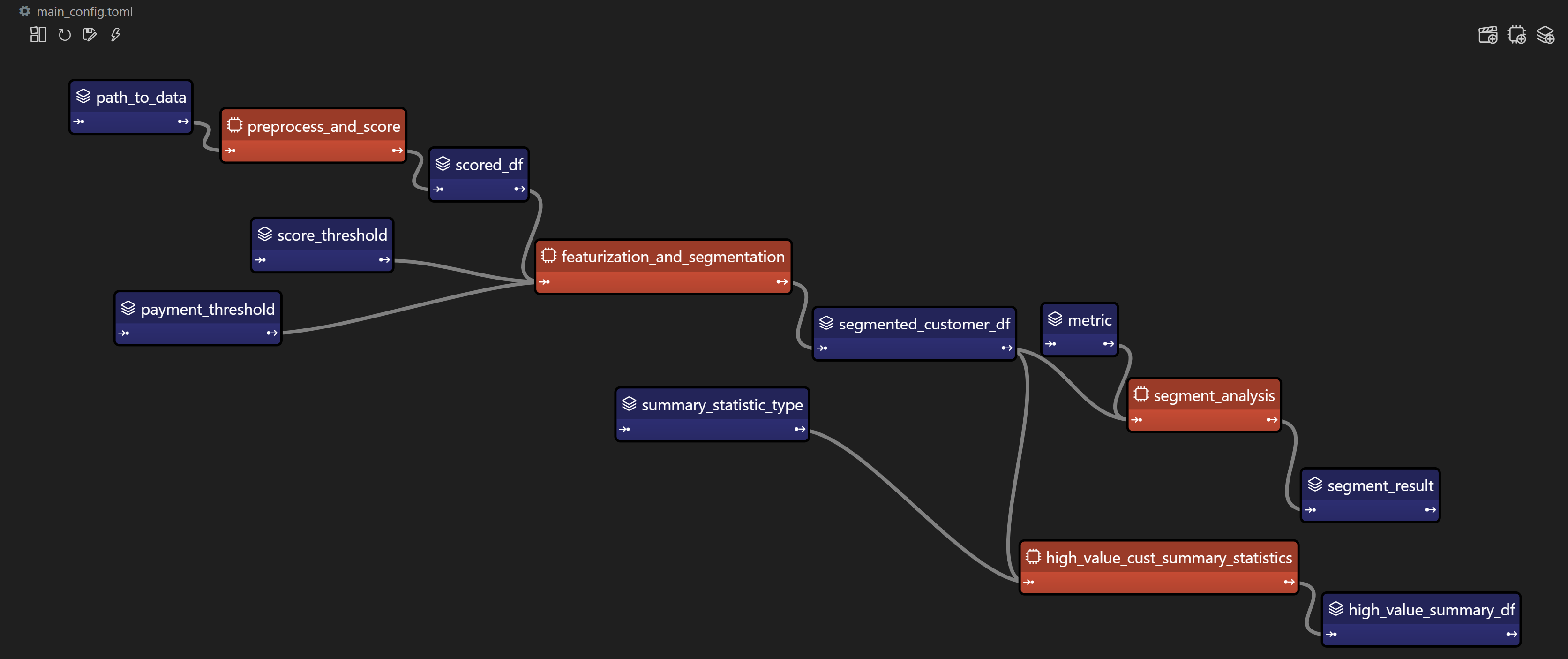 *Taipy DAG — Taipy「任務」為橘色,「資料節點」為藍色。* 在本節中,我們將建立對變數/參數進行建模的Taipy 配置(表示為[“資料節點”](https://docs.taipy.io/en/latest/manuals/core/concepts/data-node/ ))和 Taipy 中的函數(表示為 [“Tasks”](https://docs.taipy.io/en/latest/manuals/core/concepts/task/))。 --- 請注意,以下 *config.py* 腳本中的此配置類似於定義變數和函數 - 只不過我們定義的是「藍圖變數」(資料節點)和「藍圖函數」(任務)。 我們通知 Taipy 如何呼叫我們之前定義的函數、資料節點的預設值(我們可能會在執行時覆蓋)以及是否可以跳過任務: ``` ### config.py from taipy import Config from algos.algo import ( preprocess_and_score, featurization_and_segmentation, segment_analysis, high_value_cust_summary_statistics, ) # -------------------- Data Nodes -------------------- path_to_data_cfg = Config.configure_data_node(id="path_to_data", default_data="data/customers_data.csv") scored_df_cfg = Config.configure_data_node(id="scored_df") payment_threshold_cfg = Config.configure_data_node(id="payment_threshold", default_data=1000) score_threshold_cfg = Config.configure_data_node(id="score_threshold", default_data=1.5) segmented_customer_df_cfg = Config.configure_data_node(id="segmented_customer_df") metric_cfg = Config.configure_data_node(id="metric", default_data="mean") segment_result_cfg = Config.configure_data_node(id="segment_result") summary_statistic_type_cfg = Config.configure_data_node(id="summary_statistic_type", default_data="median") high_value_summary_df_cfg = Config.configure_data_node(id="high_value_summary_df") # -------------------- Tasks -------------------- preprocess_and_score_task_cfg = Config.configure_task( id="preprocess_and_score", function=preprocess_and_score, skippable=True, input=[path_to_data_cfg], output=[scored_df_cfg], ) featurization_and_segmentation_task_cfg = Config.configure_task( id="featurization_and_segmentation", function=featurization_and_segmentation, skippable=True, input=[scored_df_cfg, payment_threshold_cfg, score_threshold_cfg], output=[segmented_customer_df_cfg], ) segment_analysis_task_cfg = Config.configure_task( id="segment_analysis", function=segment_analysis, skippable=True, input=[segmented_customer_df_cfg, metric_cfg], output=[segment_result_cfg], ) high_value_cust_summary_statistics_task_cfg = Config.configure_task( id="high_value_cust_summary_statistics", function=high_value_cust_summary_statistics, skippable=True, input=[segment_result_cfg, segmented_customer_df_cfg, summary_statistic_type_cfg], output=[high_value_summary_df_cfg], ) scenario_cfg = Config.configure_scenario( id="scenario_1", task_configs=[ preprocess_and_score_task_cfg, featurization_and_segmentation_task_cfg, segment_analysis_task_cfg, high_value_cust_summary_statistics_task_cfg, ], ) ``` 號 您可以在[此處的文件](https://docs.taipy.io/en/latest/manuals/core/config/)中閱讀有關配置場景、任務和資料節點的更多資訊。 --- ### Taipy Studio [Taipy Studio](https://docs.taipy.io/en/latest/manuals/studio/config/) **是來自Taipy 的VS Code 擴充功能**,讓您**透過簡單的方式建置和視覺化您的管道拖放互動**。 Taipy Studio 提供了一個圖形編輯器,您可以在其中建立 Taipy 配置**存儲在 TOML 文件中**,您的 Taipy 應用程式可以加載並執行這些配置。 編輯器將場景表示為圖形,其中節點是資料節點和任務。 --- *作為本節中 config.py 腳本的替代方案,您可以使用 Taipy Studio 產生 config.toml 設定檔。 本文的倒數第二部分將提供有關如何使用 Taipy Studio 建立 config.toml 設定檔的指南。* --- ## 6. 場景建立與執行 執行 Taipy 場景涉及: - 載入配置; - 執行 Taipy Core 服務;和 - 建立並提交場景以供執行。 這是基本的程式碼模板: ``` import taipy as tp from config import scenario_cfg # Import the Scenario configuration tp.Core().run() # Start the Core service scenario_1 = tp.create_scenario(scenario_cfg) # Create a Scenario instance scenario_1.submit() # Submit the Scenario for execution # Total runtime: 74.49s ``` --- ### 跳過不必要的任務執行 Taipy 最實用的功能之一是,如果任務的輸出已經計算出來,它能夠跳過任務執行。 讓我們透過一些場景來探討這一點: --- #### 更改付款閾值 ``` # Changing Payment Threshold to 1600 scenario_1.payment_threshold.write(1600) scenario_1.submit() # Total runtime: 31.499s ``` *發生了什麼事*:Taipy 夠聰明,可以跳過任務 1,因為付款閾值只影響任務 2。 在這種情況下,透過使用 Taipy 執行管道,我們發現執行時間減少了 50% 以上。 --- #### 更改細分分析指標 ``` # Changing metric to median scenario_1.metric.write("median") scenario_1.submit() # Total runtime: 23.839s ``` *會發生什麼事*:在這種情況下,只有任務 3 和任務 4 受到影響。 Taipy 巧妙地跳過任務 1 和任務 2。 --- #### 更改總計統計類型 ``` # Changing summary_statistic_type to max scenario_1.summary_statistic_type.write("max") scenario_1.submit() # Total runtime: 5.084s ``` *發生了什麼事*:這裡,只有任務 4 受到影響,Taipy 僅執行此任務,跳過其餘任務。 Taipy 的智慧任務跳過功能不僅能節省時間,還能節省時間。它是一個資源優化器,在處理大型資料集時變得非常有用。 --- ## 7. Taipy Studio 您可以使用 Taipy Studio 建置 Taipy *config.toml* 設定檔來取代定義 *config.py* 腳本。 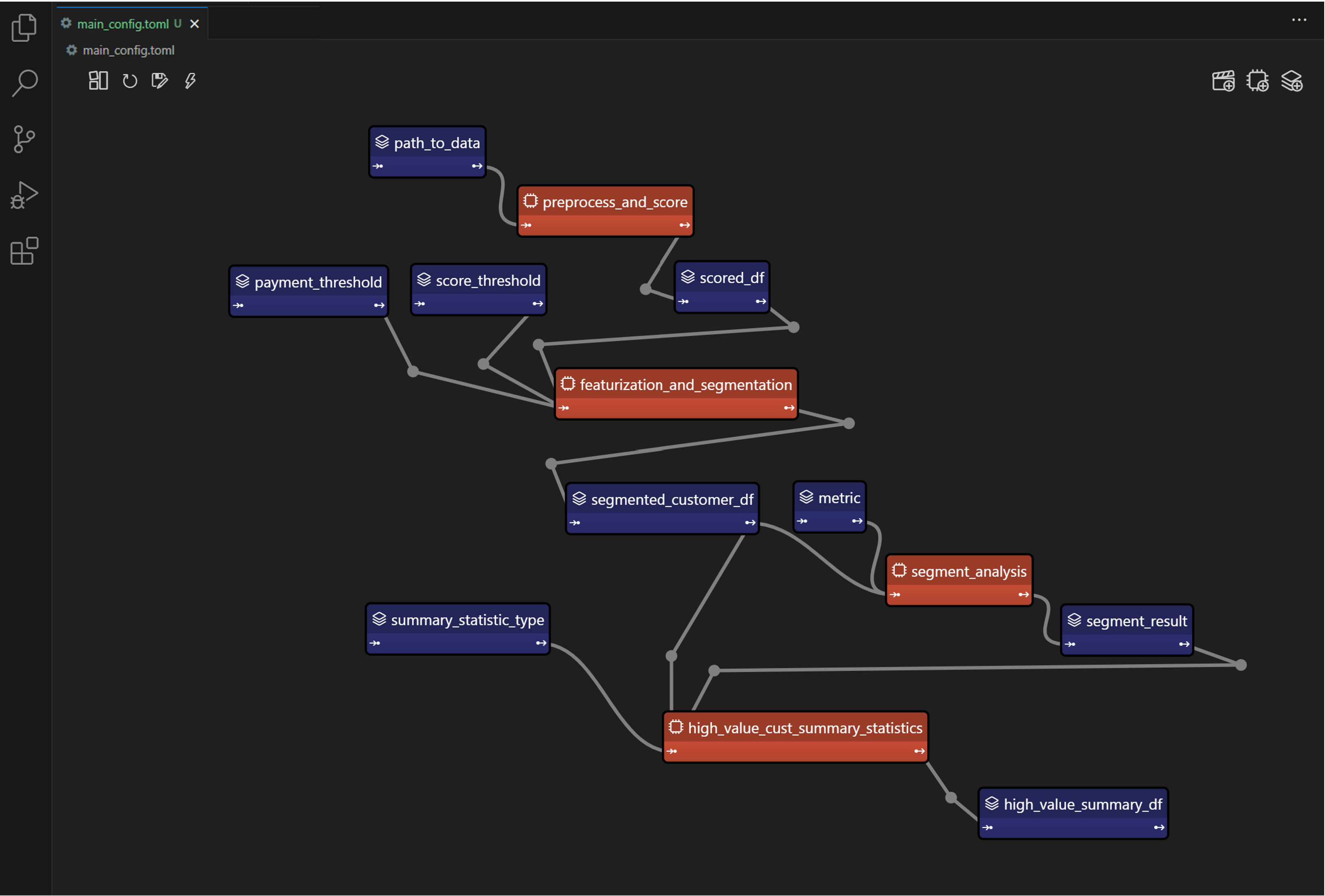 首先,使用擴展市場安裝 [Taipy Studio ](https://marketplace.visualstudio.com/items?itemName=Taipy.taipy-studio)擴充。 --- ### 建立配置 - **建立設定檔**:在 VS Code 中,導覽至 Taipy Studio,然後透過點擊參數視窗上的 + 按鈕啟動新的 TOML 設定檔。 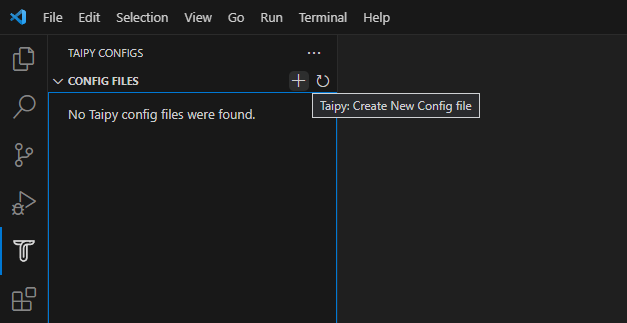 - 然後右鍵單擊它並選擇 **Taipy:顯示視圖**。  - **新增實體**到您的 Taipy 配置: 在 Taipy Studio 的右側,您應該會看到一個包含 3 個圖示的列表,可用於設定管道。  1. 第一項是新增資料節點。您可以將任何 Python 物件連結到 Taipy 的資料節點。 2. 第二項用於新增任務。任務可以連結到預先定義的 Python 函數。 3. 第三項是新增場景。 Taipy 讓您在一個配置中擁有多個場景。 --- #### - 資料節點 **輸入資料節點**:建立一個名為“*path_to_data*”的資料節點,然後導航到“詳細資料”選項卡,新增屬性“*default_data*”,並將“*SMALL_amazon_customers_data.csv*”貼上為您的資料的路徑資料集。 --- **中間資料節點**:我們需要再增加四個資料節點:「*scored_df*」、「*segmented_customer_df*」、「*segment_result*」、「*high_value_summary_df*」。透過 Taipy 的智慧設計,您無需為這些中間資料節點進行任何配置;系統會巧妙地處理它們。 --- **具有預設值的中間資料節點**:我們最終定義了另外四個中間資料節點,並將「*default_data*」屬性設為以下內容: - payment_threshold: “1000:int” 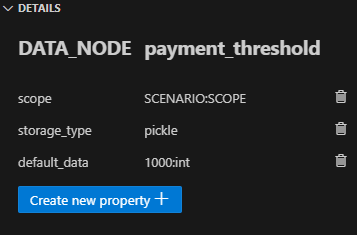 - 分數閾值:“1.5:浮動” - 測量:“平均值” -summary_statistic_type:“中位數” --- #### - 任務 點擊新增任務按鈕,您可以配置新任務。 新增四個任務,然後**將每個任務連結到「詳細資料」標籤下的對應函數**。 Taipy Studio 將掃描您的專案資料夾並提供可供選擇的分類函數列表,並按 Python 檔案排序。 --- **任務 1** (*preprocess_and_score*):在 Taipy studio 中,您可以按一下「任務」圖示以新增任務。 您可以將輸入指定為“*path_to_data*”,將輸出指定為“*scored_df*”。 然後,在「詳細資料」標籤下,您可以將此任務連結到 *algos.algo.preprocess_and_score* 函數。 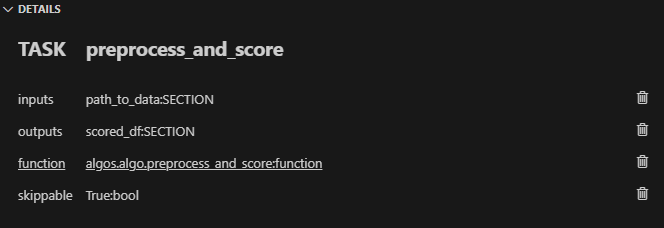 --- **任務 2** (*featurization_and_segmentation*):與任務 1 類似,您需要指定輸入 (“*scored_df*”、“* payment_threshold*”、“*score_threshold*”) 和輸出 (“*segmented_customer_df*”) ” )。將此任務連結到 *algos.algo.featurization_and_segmentation* 函數。  --- **任務 3** (*segment_analysis*):輸入為“*segmented_customer_df*”和“*metric*”,輸出為“*segment_result*”。 連結到 *algos.algo.segment_analysis* 函數。  --- **任務 4** (high_value_cust_summary_statistics):輸入包含「*segment_result*」、「*segmented_customer_df*」和「*summary_statistic_type*」。輸出為“*high_value_summary_df*”。連結到 *algos.algo.high_value_cust_summary_statistics* 函數。 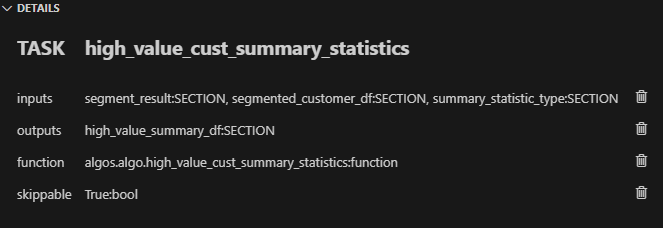 --- ## 結論 Taipy 提供了一種**智慧方式來建立和管理資料管道**。 特別是可跳過的功能使其成為優化運算資源和時間的強大工具,在涉及大型資料集的場景中特別有用。 Dask 提供了資料操作的原始能力,而 Taipy 增加了一層智能,使您的管道不僅強大而且智能。 --- 其他資源 如需完整程式碼和 TOML 配置,您可以存取此 [GitHub 儲存庫](https://github.com/Avaiga/demo-dask-customer-analysis/tree/develop)。若要深入了解 Taipy,請參閱[官方文件](https://docs.taipy.io/en/latest/)。 一旦您了解 Taipy 場景管理,您就可以更有效率地為最終用戶建立資料驅動的應用程式。只需專注於您的演算法,Taipy 就會處理剩下的事情。 ---  希望您喜歡這篇文章! --- 原文出處:https://dev.to/taipy/big-data-models-vs-computer-memory-4po6
## 簡介 我收集了最好的 React 元件,您可以使用它來建立強大的 Web 應用程式。 每個都有自己的味道。 別忘了表達你的支持🌟 現在,讓我們仔細閱讀這段程式碼! 🍽️  --- ## 1. [CopilotPortal](https://github.com/RecursivelyAI/CopilotKit):將可操作的 GPT 聊天機器人嵌入您的網路應用程式中。 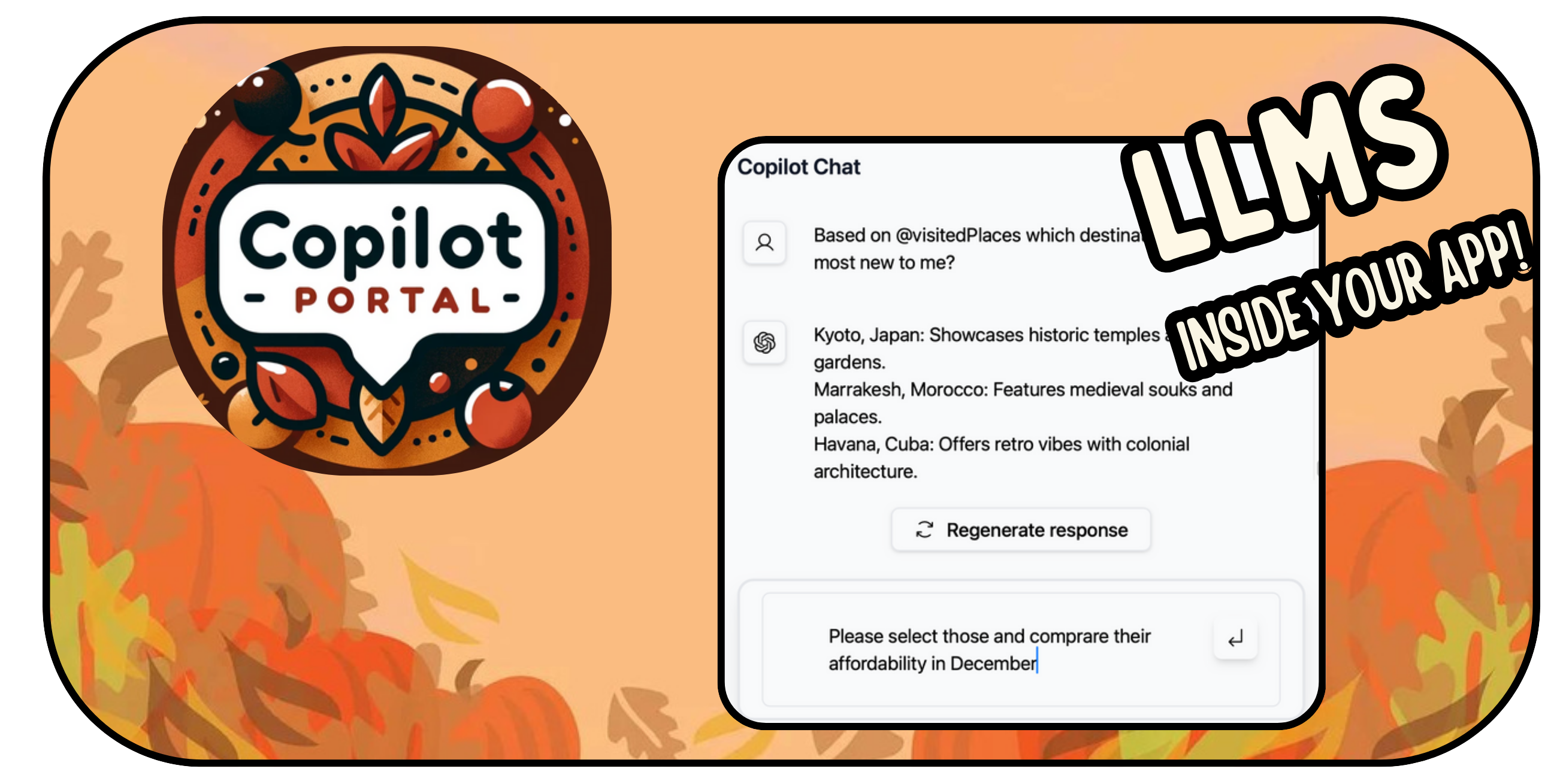 將 GPT 支援的聊天機器人插入您的 React 應用程式中。 可以將 RAG 與雲端和應用程式狀態即時整合。 需要幾行程式碼才能嵌入。 ``` import "@copilotkit/react-ui/styles.css"; import { CopilotProvider } from "@copilotkit/react-core"; import { CopilotSidebarUIProvider } from "@copilotkit/react-ui"; export default function App(): JSX.Element { return ( <CopilotProvider chatApiEndpoint="/api/copilotkit/chat"> <CopilotSidebarUIProvider> <YourContent /> </CopilotSidebarUIProvider> </CopilotProvider> ); } ``` https://github.com/RecursivelyAI/CopilotKit --- ## 2. [ClickVote](https://github.com/clickvote/clickvote) - 按讚、投票並查看任何上下文  輕鬆將點讚、按讚和評論加入到您的網路應用程式中。 用於加入這些元件的簡單反應程式碼。 ``` import { ClickVoteProvider } from '@clickvote/react'; import { ClickVoteComponent } from '@clickvote/react'; import { LikeStyle } from '@clickvote/react'; <ClickVoteProvider> <ClickVoteComponent id={CONTEXT} voteTo={ID}> {(props) => <LikeStyle {...props} />} </ClickVoteComponent> </ClickVoteProvider> ``` https://github.com/clickvote/clickvote --- ## 3. [React Flow](https://github.com/xyflow/xyflow) - 建立可拖曳工作流程的最佳方式! 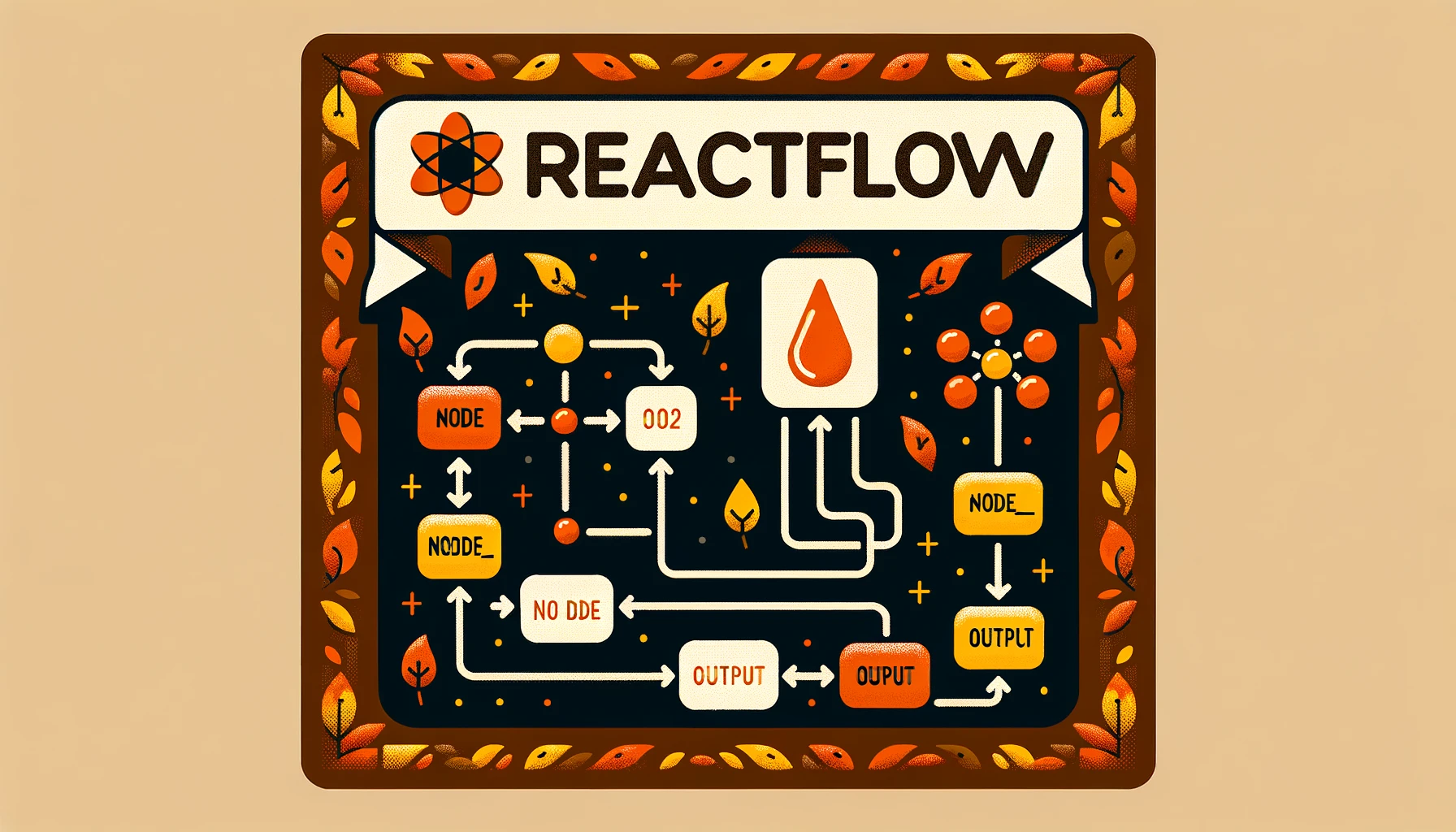 專為建立基於節點的編輯器和互動式圖表而客製化的 React 元件。 它具有高度可自訂性,提供拖放功能以實現高效的工作流程建立。 ``` import ReactFlow, { MiniMap, Controls, Background, useNodesState, useEdgesState, addEdge, } from 'reactflow'; <ReactFlow nodes={nodes} edges={edges} onNodesChange={onNodesChange} onEdgesChange={onEdgesChange} onConnect={onConnect} > <MiniMap /> <Controls /> <Background /> </ReactFlow> ``` https://github.com/xyflow/xyflow --- ## 4. [CopilotTextarea](https://github.com/RecursivelyAI/CopilotKit/tree/main/CopilotKit/packages/react-textarea) - React 應用程式中的 AI 驅動寫作 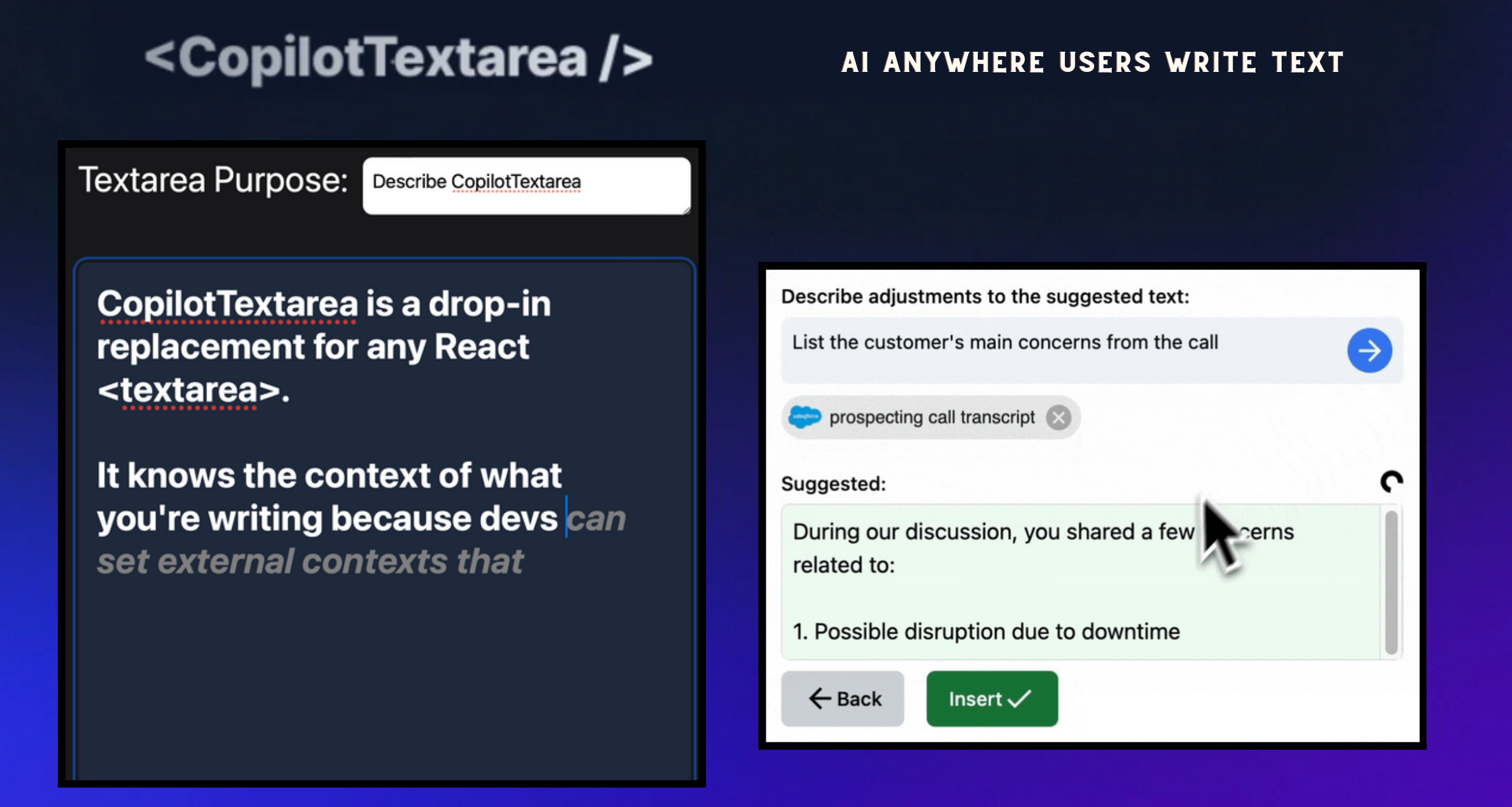 具有 Github CopilotX 功能的任何 React `<textarea>` 的直接替代品。 自動完成、插入、編輯。 可以即時或由開發人員提前提供任何上下文。 ``` import { CopilotTextarea } from "@copilotkit/react-textarea"; import { CopilotProvider } from "@copilotkit/react-core"; // Provide context... useMakeCopilotReadable(...) // in your component... <CopilotProvider> <CopilotTextarea/> </CopilotProvider>` ``` https://github.com/RecursivelyAI/CopilotKit --- ## 5. [Novu](https://github.com/novuhq/novu) - 將應用程式內通知新增至您的應用程式!  用於在一個地方管理所有通訊管道的簡單元件和 API:電子郵件、SMS、Direct 和 Push 您可以使用此 React 元件為您的應用程式新增應用程式內通知。 ``` import { NovuProvider, PopoverNotificationCenter, NotificationBell, IMessage, } from "@novu/notification-center"; <NovuProvider subscriberId={"SUBSCRIBER_ID"} applicationIdentifier={"APPLICATION_IDENTIFIER"} > <PopoverNotificationCenter colorScheme="dark"> {({ unseenCount }) => <NotificationBell unseenCount={unseenCount} />} </PopoverNotificationCenter> </NovuProvider> ``` https://github.com/novuhq/novu --- ## 6. [ReactIcons](https://github.com/react-icons/react-icons) - 最受歡迎的反應圖示集合 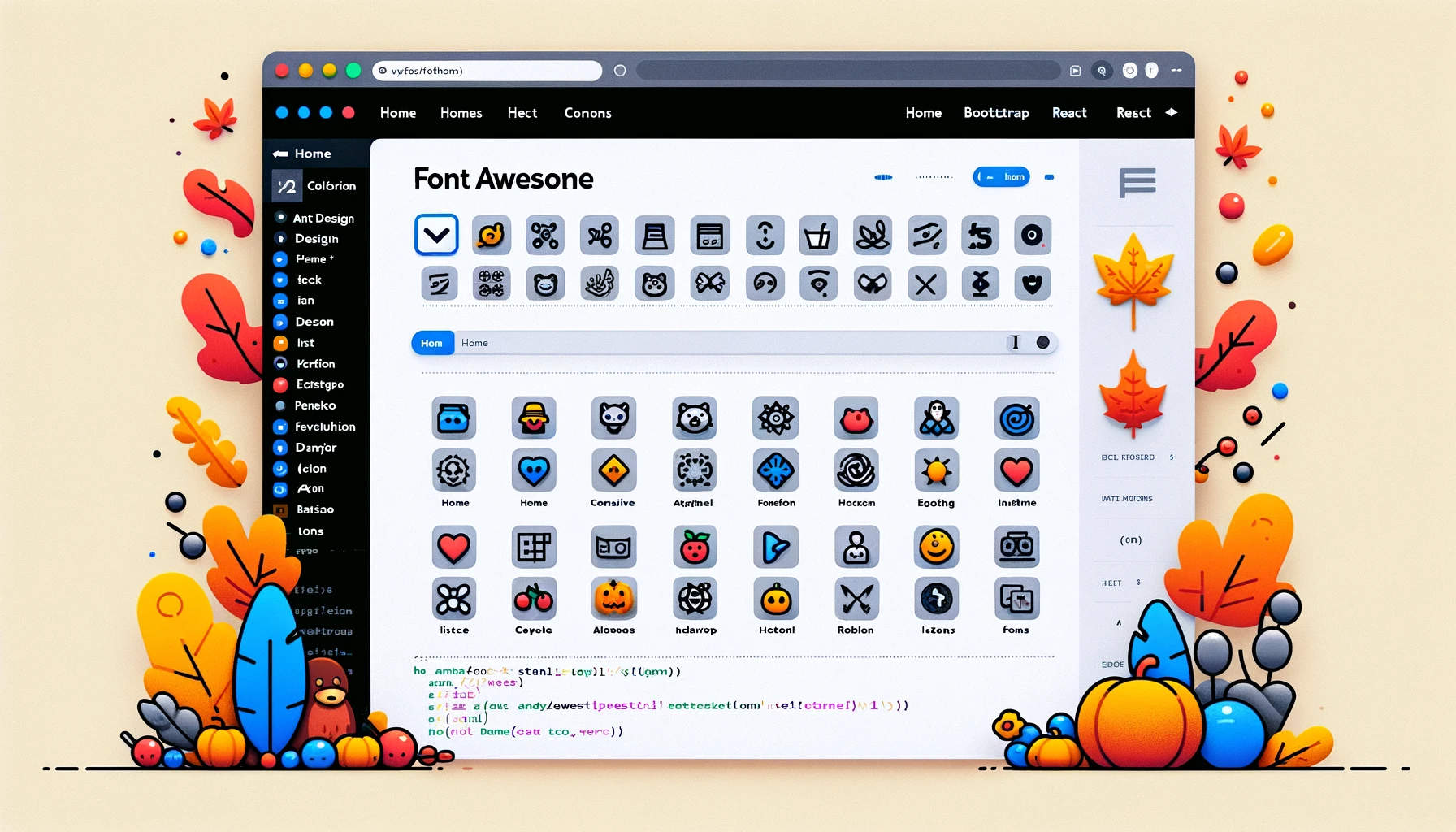 輕鬆將 Font Awesome、Material Design 等中的流行圖標加入到您的 React 應用程式中。 為開發人員提供簡單、廣泛的選擇。 ``` import { FaBeer } from "react-icons/fa"; function Question() { return ( <h3> Lets go for a <FaBeer />? </h3> ); } ``` https://github.com/react-icons/react-icons --- ## 7. [React-dropzone](https://github.com/react-dropzone/react-dropzone) - 新增 HTML5 拖放 UI。  用於實作 HTML5 拖放區域的簡單 React 鉤子,重點放在檔案互動。 它提供了一個易於使用的介面,用於向 React 應用程式加入檔案拖放功能。 ``` import React from 'react'; import {useDropzone} from 'react-dropzone'; const Basic = (props)=>{ const {acceptedFiles, getRootProps, getInputProps} = useDropzone(); const files = acceptedFiles.map(file => ( <li key={file.path}> {file.path} - {file.size} bytes </li> )); return ( <section className="container"> <div {...getRootProps({className: 'dropzone'})}> <input {...getInputProps()} /> <p>Drag 'n' drop some files here, or click to select files</p> </div> <aside> <h4>Files</h4> <ul>{files}</ul> </aside> </section> ); } export default Basic; ``` https://github.com/react-dropzone/react-dropzone --- ## 8. [React ChartJS 2](https://github.com/reactchartjs/react-chartjs-2) - 建立和整合各種圖表。 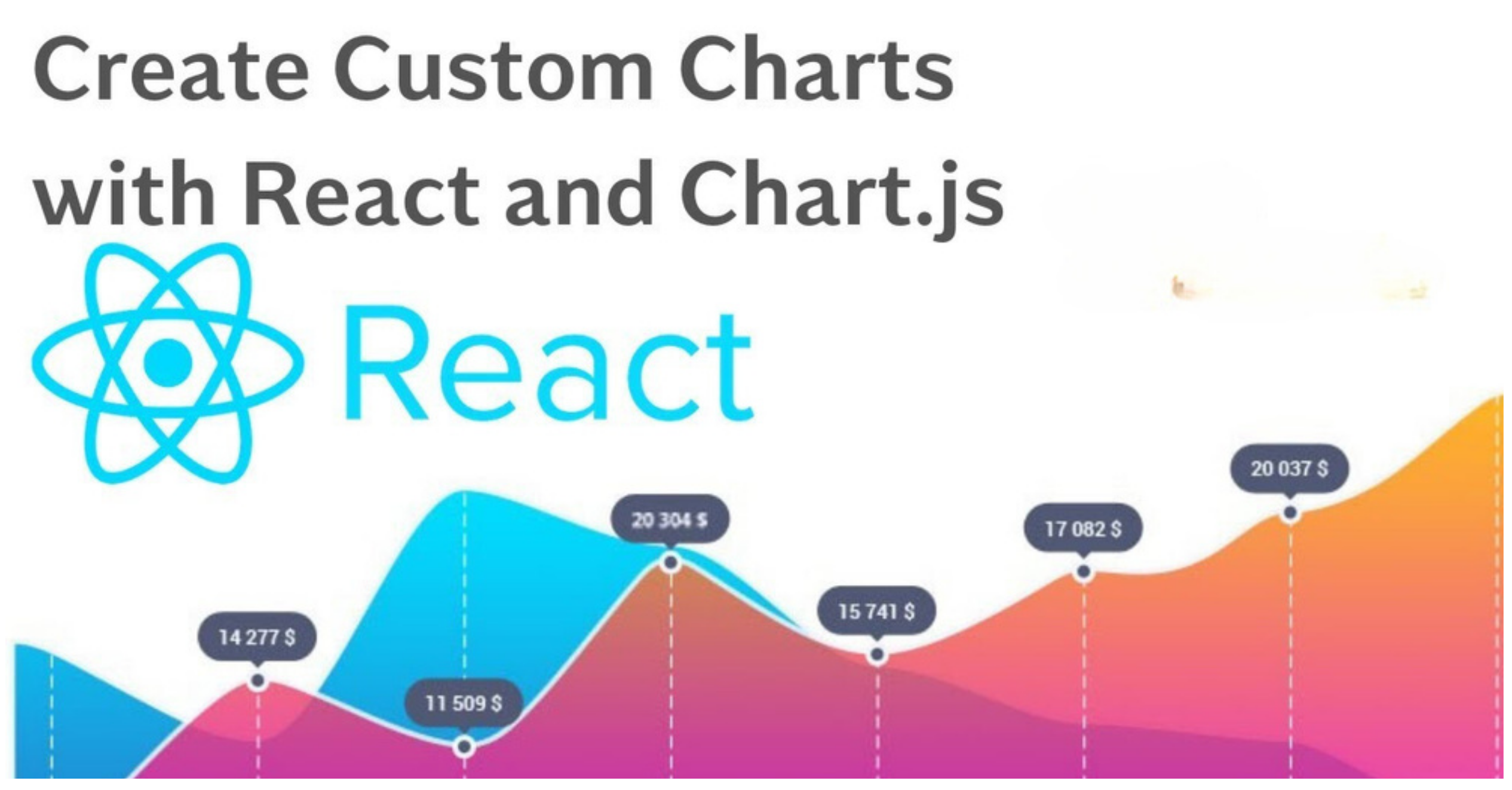 用於在 React 應用程式中繪製圖表的即插即用解決方案,類似於 Chart.js 功能。 啟用動態、互動式圖表。 適用於即時資料或預定義資料集。 ``` import React from 'react'; import { Chart as ChartJS, ArcElement, Tooltip, Legend } from 'chart.js'; import { Doughnut } from 'react-chartjs-2'; ChartJS.register(ArcElement, Tooltip, Legend); const data = { labels: ['Red', 'Blue', 'Yellow', 'Green', 'Purple', 'Orange'], datasets: [ { label: '# of Votes', data: [12, 19, 3, 5, 2, 3], backgroundColor: [ 'rgba(255, 99, 132, 0.2)', ], borderColor: [ 'rgba(255, 99, 132, 1)', ], borderWidth: 1, }, ], }; export default function ShowChart() { return <Doughnut data={data} />; } ``` https://github.com/reactchartjs/react-chartjs-2 ## 9. [Redux](https://github.com/reduxjs/redux) - 可預測的狀態容器庫  JavaScript 應用程式中 Redux 的無縫補充,提供可靠的狀態管理。 確保一致的應用程式行為。 便於輕鬆除錯和測試。 與各種庫整合。 https://github.com/reduxjs/redux --- ## 10. [Blueprint](https://github.com/palantir/blueprint) - Palantir 的密集 UI 庫 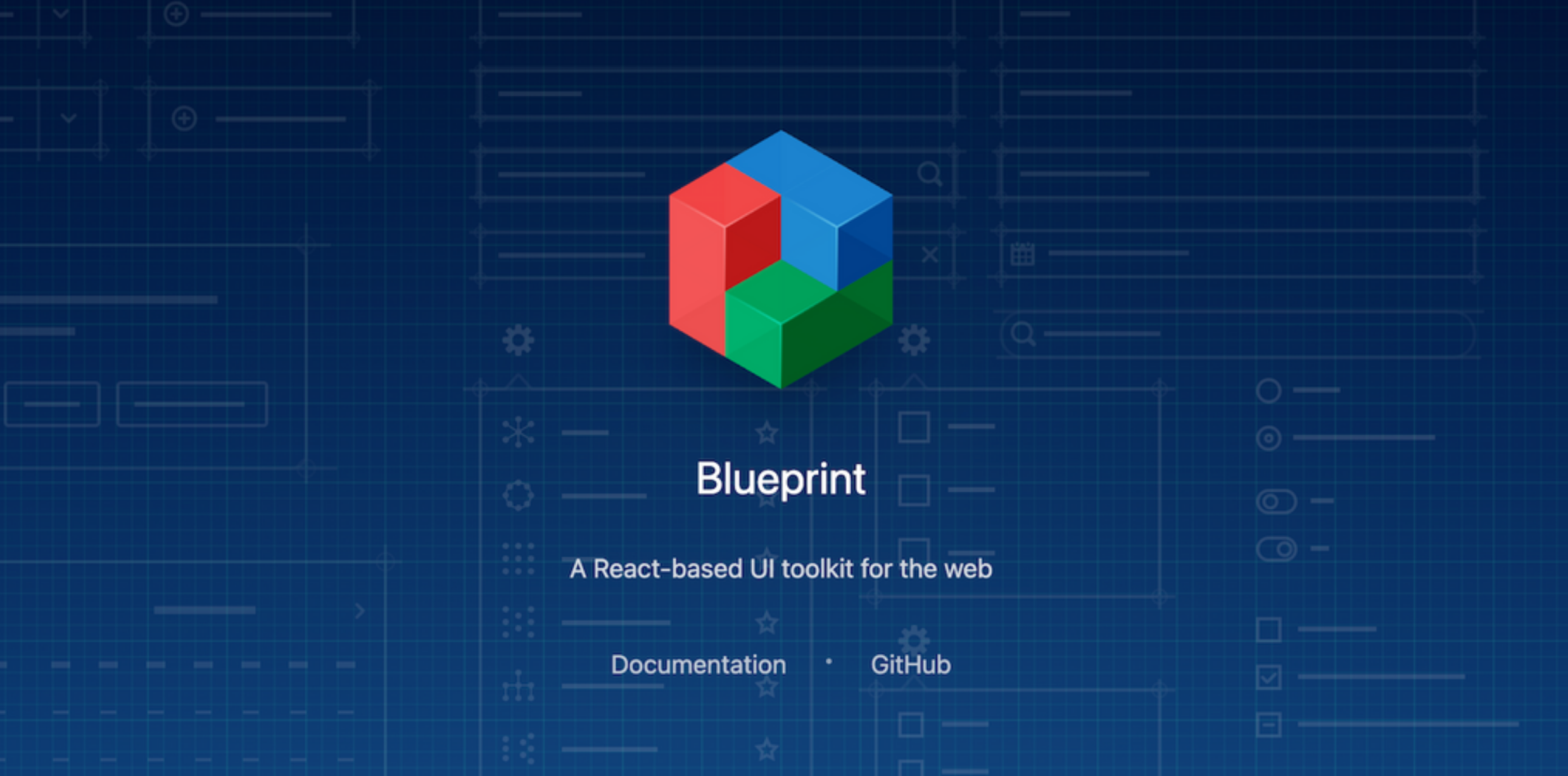 提供一組用於建立複雜且資料豐富的介面的元件和樣式。 設計和開發具有現代外觀和感覺的類似桌面的 Web 應用程式。 由 Palantir 開發 ``` import React from 'react'; import '@blueprintjs/core/lib/css/blueprint.css'; import { H3, H4, OL, Pre } from "@blueprintjs/core"; function App() { return ( <div style={{ display: 'block', width: 500, padding: 30 }}> <h4>ReactJS Blueprint HTML Elements Component</h4> Heading Component: <H4>H4 Size Heading</H4> <H3>H3 Size Heading</H3> <br></br> OrderList Component: <OL> <li>1st item</li> <li>2nd item</li> </OL> Pre Component: <Pre>Sample Pre</Pre> </div> ); } ``` https://github.com/palantir/blueprint --- ## 11. [Headless UI](https://github.com/tailwindlabs/headlessui) - 可存取的 Tailwind 整合 UI 元件。  在 React 和 Vue 應用程式中建立可存取的 UI 元件。 適用於即時資料或預定義資料集,使其成為現代 Web 開發專案的寶貴補充 ``` import React, { useState } from 'react'; import { Dialog } from '@headlessui/react'; function MyDialog() { let [isOpen, setIsOpen] = useState(true); return ( <Dialog open={isOpen} onClose={() => setIsOpen(false)} className="relative z-50"> {/* The backdrop, rendered as a fixed sibling to the panel container */} <div className="fixed inset-0 bg-black/30" aria-hidden="true" /> {/* Full-screen container to center the panel */} <div className="fixed inset-0 flex w-screen items-center justify-center p-4"> {/* Your dialog content goes here */} </div> </Dialog> ); } ``` https://github.com/tailwindlabs/headlessui --- 保存這些元件,以便像朝聖者一樣專業地建造。 謝謝大家,節日快樂! --- 原文出處:https://dev.to/copilotkit/reacts-giving-11-react-components-for-aspiring-pros-eck
# 簡介 在上一篇文章中,我討論了建立一個[GitHub stars 監視器](https://dev.to/triggerdotdev/take-nextjs-to-the-next-level-create-a-github-stars-monitor-130a)。 在這篇文章中,我想向您展示如何每天了解新星的資訊。 我們將學習: - 如何建立通用系統來建立和使用提供者。 - 如何使用提供者發送通知。 - 使用不同提供者的不同用例。  --- ## 你的後台工作平台🔌 [Trigger.dev](https://trigger.dev/) 是一個開源程式庫,可讓您使用 NextJS、Remix、Astro 等為您的應用程式建立和監控長時間執行的作業! [](https://github.com/triggerdotdev/trigger.dev) 請幫我們一顆星🥹。 這將幫助我們建立更多這樣的文章💖 https://github.com/triggerdotdev/trigger.dev --- ## 讓我們來設定一下 🔥 我們將建立不同的提供者來通知我們何時有新的明星。我們將設定「電子郵件」、「簡訊」、「Slack」和「Discord」通知。 我們的目標是讓每個貢獻者都足夠簡單,以便在未來貢獻更多的提供者。 每個提供者都會有一組不同的參數,有些只有“API 金鑰”,有些則有電話號碼,具體取決於提供者。 為了驗證這些金鑰,讓我們安裝“zod”;它是一個很棒的庫,可以定義模式並根據模式檢查資料。 您可以透過執行以下命令開始: ``` npm install zod --save ``` 完成後,建立一個名為「providers」的新資料夾,然後在其中建立一個名為「register.provider.ts」的新檔案。 這是文件的程式碼: ``` import {Schema} from "zod"; export function registerProvider<T>( name: string, options: {active: boolean}, validation: Schema<T>, run: (libName: string, stars: number, values: T) => Promise<void> ) { // if not active, we can just pass an empty function, nothing will run if (!options.active) { return () => {}; } // will validate and remove unnecessary values (Security wise) const env = validation.parse(process.env); // return the function we will run at the end of the job return async (libName: string, stars: number) => { console.log(`Running provider ${name}`); await run(libName, stars, env as T); console.log(`Finished running provider ${name}`); } } ``` 程式碼不多,但可能有點複雜。 我們首先建立一個名為「registerProvider」的新函數。該函數獲得一個通用類型“T”,基本上是我們所需的環境變數。 然後我們還有 4 個參數: - 名稱 - 可以是「Twilio」、「Discord」、「Slack」或「Resend」中的任何一個。 - 選項 - 目前,一個參數是提供者是否處於活動狀態? - 驗證 - 在這裡,我們在 .env 檔案中傳遞所需參數的「zod」模式。 - run - 實際上用於發送通知。請注意,傳入其中的參數是庫名稱、星星數量以及我們在「validation」中指定的環境變數 **然後我們就有了實際的功能:** 首先,我們檢查提供者是否處於活動狀態。如果沒有,我們發送一個空函數。 然後,我們驗證並提取我們在模式中指定的變數。如果變數缺少 `zod` 將發送錯誤並且不會讓應用程式執行。 最後,我們傳回一個函數,該函數會取得庫名稱和星星數量並觸發通知。 在我們的「providers」資料夾中,建立一個名為「providers.ts」的新文件,並在其中新增以下程式碼: ``` export const Providers = []; ``` 稍後,我們將在那裡加入所有提供者。 --- ## 修改 TriggerDev 作業 本文是上一篇關於建立 [GitHub stars 監視器](https://dev.to/triggerdotdev/take-nextjs-to-the-next-level-create-a-github-stars-monitor-130a)。 編輯檔案 `jobs/sync.stars.ts` 並將以下程式碼加入檔案底部: ``` const triggerNotification = client.defineJob({ id: "trigger-notification", name: "Trigger Notification", version: "0.0.1", trigger: invokeTrigger({ schema: z.object({ stars: z.number(), library: z.string(), providerNumber: z.number(), }) }), run: async (payload, io, ctx) => { await io.runTask("trigger-notification", async () => { return Providers[payload.providerNumber](payload.library, payload.stars); }); } }); ``` 此作業取得星星數量、圖書館名稱和提供者編號,並從先前定義的提供者觸發特定提供者的通知。 現在,我們繼續修改“getStars”,在函數末尾加入以下程式碼: ``` for (let i = 0; i < Providers.length; i++) { await triggerNotification.invoke(payload.name + '-' + i, { library: payload.name, stars: stargazers_count - payload.previousStarCount, providerNumber: i, }); } ``` 這將觸發每個圖書館的通知。 完整頁面程式碼: ``` import { cronTrigger, invokeTrigger } from "@trigger.dev/sdk"; import { client } from "@/trigger"; import { prisma } from "../../helper/prisma"; import axios from "axios"; import { z } from "zod"; import {Providers} from "@/providers/providers"; // Your first job // This Job will be triggered by an event, log a joke to the console, and then wait 5 seconds before logging the punchline. client.defineJob({ id: "sync-stars", name: "Sync Stars Daily", version: "0.0.1", // Run a cron every day at 23:00 AM trigger: cronTrigger({ cron: "0 23 * * *", }), run: async (payload, io, ctx) => { const repos = await io.runTask("get-stars", async () => { // get all libraries and current amount of stars return await prisma.repository.groupBy({ by: ["name"], _sum: { stars: true, }, }); }); //loop through all repos and invoke the Job that gets the latest stars for (const repo of repos) { await getStars.invoke(repo.name, { name: repo.name, previousStarCount: repo?._sum?.stars || 0, }); } }, }); const getStars = client.defineJob({ id: "get-latest-stars", name: "Get latest stars", version: "0.0.1", // Run a cron every day at 23:00 AM trigger: invokeTrigger({ schema: z.object({ name: z.string(), previousStarCount: z.number(), }), }), run: async (payload, io, ctx) => { const stargazers_count = await io.runTask("get-stars", async () => { const {data} = await axios.get(`https://api.github.com/repos/${payload.name}`, { headers: { authorization: `token ${process.env.TOKEN}`, }, }); return data.stargazers_count as number; }); await io.runTask("upsert-stars", async () => { await prisma.repository.upsert({ where: { name_day_month_year: { name: payload.name, month: new Date().getMonth() + 1, year: new Date().getFullYear(), day: new Date().getDate(), }, }, update: { stars: stargazers_count - payload.previousStarCount, }, create: { name: payload.name, stars: stargazers_count - payload.previousStarCount, month: new Date().getMonth() + 1, year: new Date().getFullYear(), day: new Date().getDate(), }, }); }); for (let i = 0; i < Providers.length; i++) { await triggerNotification.invoke(payload.name + '-' + i, { library: payload.name, stars: stargazers_count - payload.previousStarCount, providerNumber: i, }); } }, }); const triggerNotification = client.defineJob({ id: "trigger-notification", name: "Trigger Notification", version: "0.0.1", trigger: invokeTrigger({ schema: z.object({ stars: z.number(), library: z.string(), providerNumber: z.number(), }) }), run: async (payload, io, ctx) => { await io.runTask("trigger-notification", async () => { return Providers[payload.providerNumber](payload.library, payload.stars); }); } }); ``` 現在,有趣的部分🎉 讓我們繼續建立我們的提供者! 首先建立一個名為「providers/lists」的新資料夾 --- ## 1. Discord  建立一個名為「discord.provider.ts」的新檔案並新增以下程式碼: ``` import {object, string} from "zod"; import {registerProvider} from "@/providers/register.provider"; import axios from "axios"; export const DiscordProvider = registerProvider( "discord", {active: true}, object({ DISCORD_WEBHOOK_URL: string(), }), async (libName, stars, values) => { await axios.post(values.DISCORD_WEBHOOK_URL, {content: `The library ${libName} has ${stars} new stars!`}); } ); ``` 如您所見,我們正在使用 `registerProvider` 建立一個名為 DiscordProvider 的新提供程序 - 我們將名稱設定為“discord” - 我們將其設定為活動狀態 - 我們指定需要一個名為「DISCORD_WEBHOOK_URL」的環境變數。 - 我們使用 Axios 的簡單 post 指令將資訊加入支票中。 若要取得“DISCORD_WEBHOOK_URL”: 1. 前往您的 Discord 伺服器 2. 點選其中一個頻道的“編輯” 3. 轉到“整合” 4. 點選“建立 Webhook” 5. 點選建立的 webhook,然後點選“複製 webhook URL” 在根專案上編輯“.env”檔案並加入 ``` SLACK_WEBHOOK_URL=<your copied url> ```  --- ## 2. Slack 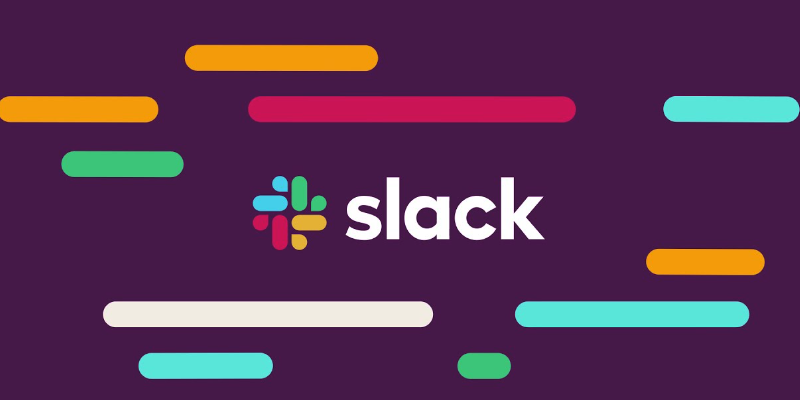 建立一個名為「slack.provider.ts」的新檔案並新增以下程式碼: ``` import {object, string} from "zod"; import {registerProvider} from "@/providers/register.provider"; import axios from "axios"; export const SlackProvider = registerProvider( "slack", {active: true}, object({ SLACK_WEBHOOK_URL: string(), }), async (libName, stars, values) => { await axios.post(values.SLACK_WEBHOOK_URL, {text: `The library ${libName} has ${stars} new stars!`}); } ); ``` 如您所見,我們正在使用 `registerProvider` 建立一個名為 SlackProvider 的新提供者 - 我們將名稱設定為“slack” - 我們將其設定為活動狀態 - 我們指定需要一個名為「SLACK_WEBHOOK_URL」的環境變數。 - 我們使用 Axios 的簡單 post 指令將資訊加入支票中。 要取得“SLACK_WEBHOOK_URL”: 1. 使用下列 URL 建立新的 Slack 應用程式:https://api.slack.com/apps?new_app=1 2. 選擇第一個選項:“從頭開始” 3. 指定應用程式名稱(任意)以及您想要新增通知的 Slack 工作區。點擊“建立應用程式”。 4. 在“新增特性和功能”中,按一下“傳入掛鉤” 5. 在啟動傳入 Webhooks 中,將其變更為「開啟」。 6. 按一下「將新 Webhook 新增至工作區」。 7. 選擇您想要的頻道並點選「允許」。 8. 複製 Webhook URL。 在根專案上編輯“.env”檔案並加入 ``` SLACK_WEBHOOK_URL=<your copied url> ```  --- ## 3. 電子郵件  您可以使用不同類型的電子郵件提供者。例如,我們將使用**Resend**來傳送電子郵件。 為此,讓我們在我們的專案上安裝重新發送: ``` npm install resend --save ``` 建立一個名為「resend.provider.ts」的新檔案並新增以下程式碼: ``` import {object, string} from "zod"; import {registerProvider} from "@/providers/register.provider"; import axios from "axios"; import { Resend } from 'resend'; export const ResendProvider = registerProvider( "resend", {active: true}, object({ RESEND_API_KEY: string(), }), async (libName, stars, values) => { const resend = new Resend(values.RESEND_API_KEY); await resend.emails.send({ from: "Eric Allam <[email protected]>", to: ['[email protected]'], subject: 'New GitHub stars', html: `The library ${libName} has ${stars} new stars!`, }); } ); ``` 如您所見,我們正在使用 `registerProvider` 建立一個名為 ResendProvider 的新提供程序 - 我們將名稱設定為“重新發送” - 我們將其設定為活動狀態 - 我們指定需要一個名為「RESEND_API_KEY」的環境變數。 - 我們使用重新發送庫向自己發送一封包含新星數的電子郵件。 若要取得“RESEND_API_KEY”: 1. 建立一個新帳戶:https://resend.com 2. 前往「API 金鑰」或使用此 URL https://resend.com/api-keys 3. 按一下“+ 建立 API 金鑰”,新增金鑰名稱,選擇“傳送存取”並使用預設的“所有網域”。單擊新增。 4. 複製 API 金鑰。 在根專案上編輯“.env”檔案並加入 ``` RESEND_API_KEY=<your API key> ```  --- ## 4.簡訊  SMS 有點複雜,因為它們需要多個變數。 為此,我們在專案中安裝 Twilio: ``` npm install twilio --save ``` 建立一個名為「twilio.provider.ts」的新檔案並新增以下程式碼: ``` import {object, string} from "zod"; import {registerProvider} from "@/providers/register.provider"; import axios from "axios"; import client from 'twilio'; export const TwilioProvider = registerProvider( "twilio", {active: true}, object({ TWILIO_SID: string(), TWILIO_AUTH_TOKEN: string(), TWILIO_FROM_NUMBER: string(), TWILIO_TO_NUMBER: string(), }), async (libName, stars, values) => { const twilio = client(values.TWILIO_SID, values.TWILIO_AUTH_TOKEN); await twilio.messages.create({ body: `The library ${libName} has ${stars} new stars!`, from: values.TWILIO_FROM_NUMBER, to: values.TWILIO_TO_NUMBER, }); } ); ``` 如您所見,我們正在使用 `registerProvider` 建立一個名為 TwilioProvider 的新提供者 - 我們將名稱設定為“twilio” - 我們將其設定為活動狀態 - 我們指定需要環境變數:`TWILIO_SID`、`TWILIO_AUTH_TOKEN`、`TWILIO_FROM_NUMBER` 和 `TWILIO_TO_NUMBER` - 我們使用 Twilio「建立」功能發送簡訊。 取得“TWILIO_SID”、“TWILIO_AUTH_TOKEN”、“TWILIO_FROM_NUMBER”和“TWILIO_TO_NUMBER” 1. 在 https://twilio.com 建立一個新帳戶 2. 標記您要使用它來發送簡訊。 3. 點選“取得電話號碼” 4. 複製“帳戶 SID”、“身份驗證令牌”和“我的 Twilio 電話號碼” 在根專案上編輯“.env”檔案並加入 ``` TWILIO_SID=<your SID key> TWILIO_AUTH_TOKEN=<your AUTH TOKEN key> TWILIO_FROM_NUMBER=<your FROM number> TWILIO_TO_NUMBER=<your TO number> ``` 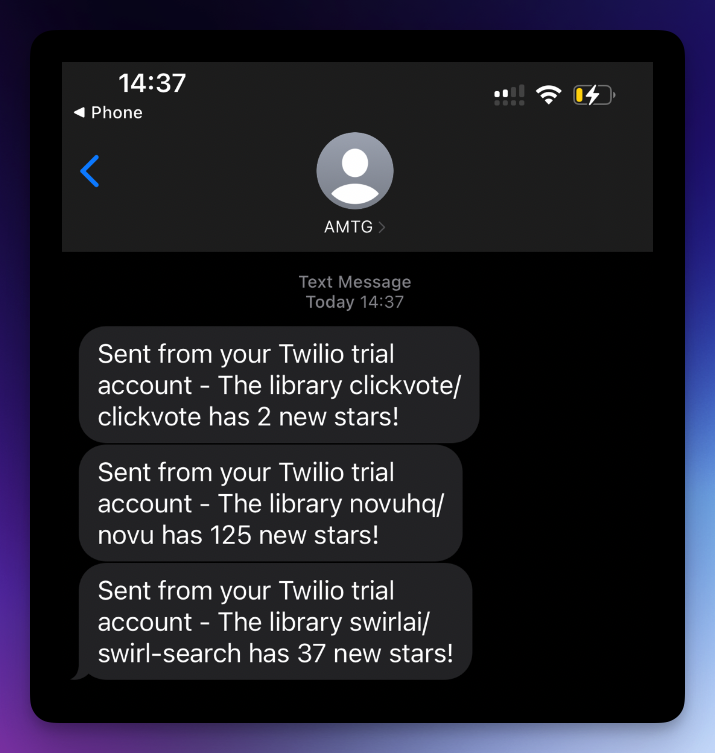 --- ## 建立新的提供者 正如您所看到的,現在建立提供者非常容易。 您也可以使用開源社群來建立新的提供程序,因為他們只需要在「providers/list」目錄中建立一個新檔案。 最後要做的事情是編輯“providers.ts”檔案並加入所有提供程序。 ``` import {DiscordProvider} from "@/providers/list/discord.provider"; import {ResendProvider} from "@/providers/list/resend.provider"; import {SlackProvider} from "@/providers/list/slack.provider"; import {TwilioProvider} from "@/providers/list/twilio.provider"; export const Providers = [ DiscordProvider, ResendProvider, SlackProvider, TwilioProvider, ]; ``` 請隨意建立更多推播通知、網路推播通知、應用程式內通知等提供者。 你就完成了🥳 --- ## 讓我們聯絡吧! 🔌 作為開源開發者,我們邀請您加入我們的[社群](https://discord.gg/nkqV9xBYWy),以做出貢獻並與維護者互動。請隨時造訪我們的 [GitHub 儲存庫](https://github.com/triggerdotdev/trigger.dev),貢獻並建立與 Trigger.dev 相關的問題。 本教學的源程式碼可在此處取得: [https://github.com/triggerdotdev/blog/tree/main/stars-monitor-notifications](https://github.com/triggerdotdev/blog/tree/main/stars-monitor-notifications) 感謝您的閱讀! --- 原文出處:https://dev.to/triggerdotdev/top-4-ways-to-send-notifications-about-new-stars-1cgb
目前大環境不好,但作為開發人員,我們擁有一套獨特的技能,如果您知道在哪裡尋找,這些技能的需求量很大! 這篇文章簡要概述了 50 個作為開發人員可以用來賺取額外收入的副業 --- ### 1. 銷售注意力 基於參與度的收入是指您將根據使用者在您的網站、個人資料或消費您的內容上花費的時間來獲得收入分成。它通常很小,至少對於較小的網站或創作者來說是這樣,但隨著時間的推移,它會增加,任何人都可以啟用它 - 所以你不會有任何損失。 - [Brave](https://creators.brave.com/) - 為使用 Brave 瀏覽器造訪您的網站、個人資料或查看您的內容的使用者付費。資金以 [BAT](https://basicattentiontoken.org/) 形式存入您的 Uphold 帳戶,然後可以以美元、英鎊或歐元形式提取至您的銀行帳戶 - [Flattr](https://flattr.com/) - 付費使用 Flattr 的用戶將其資金分配給用戶存取過其內容的創作者 > 幾年前,我親自報名了 Brave Rewards。在驗證了我的網域和個人資料的所有權後,我每月一直賺幾英鎊 - 到目前為止大約 200 英鎊以上(儘管我是 Firefox 用戶!)。雖然不多,但只需付出很少的努力,就值得了。 有關其工作原理的更多訊息,請查看 [webmonetization.org](https://webmonetization.org/) 規範,該規範利用了 [付款指針](https://paymentpointers.org/)通過[ILP](https://interledger.org/) 透過使用簡單的`<link rel="monetization" href="your-pointer-here" />` 標籤來串流來自支援WM 的訪客的收入。 --- ### 2. API 即服務 RapidAPI 等平台可讓您從 API 中[賺取被動收入](https://rapidapi.com/guides/earn-a-passive-venue-by-monetizing-apis-as-a-developer)。 建置並部署簡單的 API 後,您可以將其匯入 RapidAPI Hub,選擇使用和定價計劃,然後點擊發布。您的 API 可大可小,如您所願。 如果您正在為一個簡單的第一個專案尋找靈感,請考慮將開放資料集轉換為 API。對於初學者,RapidAPI 有一個關於如何入門的[影片系列](https://rapidapi.com/courses/build-and-sell-your-own-api)。其他想法可能包括將現有套件包裝為 API、向其他服務(如 OpenAI)加入功能或建置執行一些簡單計算的端點。 --- ### 3. 發放賞金 這些是開源專案的熱門功能請求。用戶可以在承諾一定金額的情況下提供“賞金”,然後將其支付給第一個完成並合併該功能的開發人員。 - [BOSS.dev](https://www.boss.dev/) - 完成功能請求和錯誤修復,獎金從 30 美元到 1000 美元不等。 --- ### 4. 贊助商 如果您在 GitHub 或其他平台上有業務,那麼啟用贊助是一種為您的工作帶來收入的有益方式。 不要忘記啟用贊助商按鈕。這適用於各種平台以及 GitHub 贊助商 - [GitHub Sponsors](https://github.com/sponsors) - 對於開發人員(無論規模大小)來說都是一個不錯的選擇。如果支持者已經在 GitHub 上,則零費用且進入門檻低 - [Patreon](https://www.patreon.com/) - 允許向您的支持者提供福利和獨家內容。如果您在 GitHub 以外的其他平台上有業務,這是一個不錯的選擇 - [LibrePay](https://liberapay.com/) - 針對那些建立開源內容的人 - [Open Collective](https://opencollective.com/) - 如果您正在為特定專案籌集資金,並使用收益來支持該專案(而不是個人),那麼這是一個不錯的選擇 - [Steday](https://steadyhq.com/en) - [TideLift](https://tidelift.com) - 更針對那些開發企業級開源專案的人,潛在收入更大,但僅限於最大的專案 - [LFX](https://lfx.linuxfoundation.org/) - 由 Linux 基金會提供 > 贊助(特別是GitHub 贊助商)是我個人最喜歡的方法之一,因為付費是可選的,所以你不會阻止那些無力承擔費用的人存取,而且那些支持你的人已經知道他們會預先得到什麼,所以您永遠不會讓客戶失望。 --- ### 5. 小費 您可能遇到過這樣的情況,您發現某個部落格文章、SO 答案、GitHub 儲存庫或論壇回應非常有幫助,以至於您希望可以為作者買一杯啤酒來表示感謝。 支援這些小額一次性付款的平台可以免費註冊,並且在您的個人資料中或在部落格文章末尾加入「提示」按鈕不會有任何損失。 - [Ko-fi](https://ko-fi.com/) - [請我喝杯咖啡](https://www.buymeacoffee.com/) - [Tipeee](https://en.tipeee.com/) - [PayPal Me](https://www.paypal.com/paypalme/) 提示:不要乞求。建立一些有用的內容,然後將提示連結放在底部。 --- ### 6. 企業贊助 許多具有一定下載量/經常性用戶的開源專案將開始被希望贊助創作者作品的公司接洽,以換取他們的公司徽標+連結包含在自述文件頂部附近。與個人贊助不同,這些贊助通常起價為 100-500 美元/月,專案使用量越大,贊助金額就越多。 --- ### 7. 黑客松 編碼競賽一直在遠端進行。這些通常由公司贊助,並向獲獎者支付現金獎勵。 - [程式碼之夏](https://summerofcode.withgoogle.com/) - 由 Google 執行,您將收到[貢獻者津貼](https://developers.google.com/open-source/gsoc/help/student-stipends) 成功接受後,金額從750 美元到6000 美元不等,金額取決於您所在的國家/地區和專案規模 - [CodeHeat](https://codeheat.org/) - 由 FOSS Asia 運營,每兩週 100 新元,外加較小的獎品 - [HackerEarth](https://www.hackerearth.com/challenges/hackathon/) - [Hackathon.com](https://www.hackathon.com/online) - [Devfolio 黑客松](https://devfolio.co/hackathons/upcoming) > 當我還是學生時,我[曾經參加過很多](https://alicia.omg.lol/hackathons) 黑客馬拉松(大部分是面對面的),並且經常能夠通過參加各種活動來資助我的暑假活動!這也是認識新朋友、學習新事物的好方法,而且非常有趣! --- ### 8. 依賴套件的贊助 如果您有一個軟體包(例如 NPM 模組),那麼在您的設定檔中啟用贊助將允許您的程式碼的使用者在財務上做出貢獻。 - NPM 資金 - 您可能熟悉執行“npm 基金”,並查看您正在使用的正在尋求資金的軟體包清單。新增了 [npm 基金](https://docs.npmjs.com/cli/v6/commands/npm-fund),以便更輕鬆地向專案所依賴的依賴項的維護者捐款。如果您維護 NPM 包,只需在 package.json 中包含「funding」字段,用戶將能夠更輕鬆地支援您。 - [StackAid](https://www.stackaid.us/) - 只需安裝 StackAid GitHub 應用程式並連結您的 Stripe 帳戶,直接或間接使用您專案的支持者捐贈的部分資金將分配給您每個月 - GitHub Sponsors - GitHub Sponsors 再次出現,因為它[讓用戶提供他們最常用的依賴項](https://github.com/sponsors/explore) - 儘管這是一個手動過程,而不是自動的。 --- ### 9. 回報問題 如果您注重安全性,或喜歡在應用程式中尋找錯誤和漏洞,那麼這款就適合您。最受歡迎的平台是[HackerOne](https://hackerone.com/opportunities/all/search?ordering=Highest+bounties),每個負責任地披露的錯誤都可以在其中賺取20 到200,000 美元的收入。 許多其他網站也直接提供負責任的揭露政策,他們會獎勵您的工作。如果您對此感興趣,我在以下位置保留了 1000 多個賞金計劃的清單:[https://bug-bounties.as93.net](https://bug-bounties.as93.net) > 我個人透過這種方法取得了很大的成功,而且也很有趣 - 所以我強烈推薦它! 其他值得查看的平台包括: - [HackerOne](https://www.hackerone.com/) - 排名第一的平台,最多的賞金以及良好的保護和支付率 - [Immunefi](https://immunefi.com/) - 專門針對 Web3 - [BugCrowd](https://www.bugcrowd.com/bug-bounty-list/) - [Intigriti](https://www.intigriti.com/) - [issuehunt](https://issuehunt.io/) --- ### 10.開放核心模型 這是您的大部分程式碼都是開源的,但某些擴充功能或附加元件(特別是針對企業客戶的擴充或附加元件)被授權為專有的。 因此,開發者可以在其他開源專案中自由使用該軟體。然而,公司必須為使用企業特定的模組或整合付費。 請記住,這通常說起來容易做起來難。您需要能夠分離專有功能,而大公司通常會採取一切措施(包括違反許可限制)來避免付費。 --- ### 11. 付費升級套件 這些服務可以輕鬆為常見註冊管理機構提供高級/付費方案。例如,如果您希望分發 NPM 模組的高級版本,或對特定軟體包功能收費,這可能是個不錯的選擇。 - [PrivJS](https://www.privjs.com/) - 分發 Node 套件的進階版本 - [CodeShip](https://codecodeship.com/) - 私人註冊中心,用戶需要付費才能使用你的包 --- ### 12.贊助支持 在開源專案中加入專業支援計劃選項使客戶能夠支付一次性或持續的幫助和支援費用,以啟動和執行。 這可以透過您自己的系統啟用,也可以使用現有的贊助平台(例如Patreon 和GitHub Sponsors),或使用專門的服務(例如[Otechie](https://otechie.com/))來啟用,該服務加入了付費功能+ 支援通過嵌入的聊天對話框。 [Calendly](https://calendly.com/) 等工具可以讓客戶將時間放入日曆中,或者對於較大的專案,投資專用的客戶支援平台,例如[HelpScout](https://www.helpscout.com/) 可能會讓這件事變得更容易。 --- ### 13. 寫文件 - [撰寫文件](https://www.writethedocs.org/) 是所有文件的首選位置。 - [文件季節](https://developers.google.com/season-of-docs) - 在 Google 的支持下,每年都有技術作家為開源專案做出貢獻。參與專案將獲得 5,000 至 15,000 美元的贈款,然後通常透過 Open Collective 分發給貢獻者。 - 如果你環顧四周,你會發現還有很多產品正在尋找技術作家。 Julia 列出了一份[好名單](https://dev.to/juliafmorgado/get-paid-to-write-technical-articles-16cl),列出了願意付費讓你撰寫技術內容的公司 - 版權也屬於這一類。 [scripted](https://www.scripted.com/) 等服務可讓您透過校對或編輯其他文字內容來賺錢。 即使只是記錄您自己的和其他開發人員的儲存庫也是一個不錯的起點。 如果專案被記錄下來,它的價值就會大幅增加。如果沒有文件,潛在使用者、客戶或開發人員將不知道它的用途、如何使用它、如何在其基礎上建立或如何做出貢獻。 > 我可能是唯一的一個,但我個人喜歡寫文件。 [我的所有專案](https://github.com/Lissy93?tab=repositories) 包括完整的使用、開發和貢獻文件。這促進了它們的成功和採用。我覺得如果你不花一點時間向人們展示如何使用它,那麼花幾個小時建立一些很棒的東西是沒有意義的。 --- ### 14. 廣告 在你跳過這一點之前——我也討厭廣告。它們很煩人,並且經常涉及某種形式的跟踪,從而損害用戶的隱私。但是,對於開源專案,還有一些其他選項沒有這些缺點。 - [Ethical Ads](https://www.ethicalads.io/) - [Carbon Ads](https://www.carbonads.net/open-source) 如果您正在維護獲得穩定流量的 GitHub 儲存庫、網站、部落格或服務,那麼這是一個不錯的選擇。通常每月至少需要約 10,000 個用戶,但如果您每月獲得 50,000 以上的用戶,您將獲得更好的回報。 --- ### 15. 出售你的程式碼 > 我個人不同意這種方法,只是因為出售的許多程式碼都是開源軟體的糟糕的重新設計版本,並且並不總是給予原始作者適當的榮譽。也就是說,一些開發商確實設法讓它發揮作用,建造簡單的專案然後將其出售。 - [IndieMaker](https://indiemaker.co/) - 出售您的整個專案 - [PieceX](https://www.piecex.com/) - 出售現成的原始碼 - [Codester](https://www.codester.com/info/seller) - 針對 PHP 和 Wordpress --- ### 16.銷售內容 當您查看開發人員的副業時,這是一個常見的建議。但有充分的理由 - 如果您能夠建立高品質的內容,您可以賺到很多錢。特別是如果您對新興領域有深入的了解。 銷售內容的熱門網站包括: - [GumRoad](https://gumroad.com/) - 程式碼、課程、貼文、藝術、設計、媒體(10% 費用) - [AppSumo](https://sell.appsumo.com/) - 程式碼、應用程式、擴充功能、課程、範本等 --- ### 17.寫作 這是一套獨特的技能。要么您非常擅長編寫引人入勝的內容,要么您對特定的熱門領域有深入的了解。否則,如果您對此感興趣,請考慮電子書出版,如果您的書不成功,也不會造成任何損失。 - [LeanPub](https://leanpub.com/) - 一個自助出版技術/開發電子書和課程的平台,具有豐厚的收入模式(您可以保留 70%) - [Amazon KDP](https://kdp.amazon.com/en_US/) - 發佈至 Amazon Kindle,並立即向全球數百萬用戶提供(亞馬遜將收取至少 30% 的佣金,可能會更多)小出版商) - [SmashWords](https://www.smashwords.com/) 和 [Draft2Digital](https://draft2digital.com/sw/) - 分發給全球其他電子書賣家,這是一種簡單的開始出版。他們收取的佣金比亞馬遜少,但比 LeanPub 多。 --- ### 18.補助金 補助金和企業贊助涉及多個領域,包括開源、創新、DeFi、人工智慧等。它們通常是為了幫助您在從事特定工作時支付短期生活費用。 - [GitHub Sponsors](https://github.com/sponsors) - 為個人和組織提供經濟支援開源開發者的平台。金額依贊助情況而有所不同。 - [Google Summer of Code (GSoC)](https://summerofcode.withgoogle.com/) - 學生開發者為開源專案做出貢獻的全球計劃,津貼通常為 1500 美元到 3300 美元不等。 - [Mozilla 開源支援 (MOSS)](https://www.mozilla.org/en-US/moss/) - 為開源軟體開發提供資助,特別是與 Mozilla 使命相符的專案。 - [Linux 基金會資助](https://www.linuxfoundation.org/) - 為從事 Linux 基金會專案的開發人員提供各種資助和獎學金。 - [NumFOCUS 小額發展補助金](https://numfocus.org/programs/small-development-grants) - 支援資料科學和科學計算的小型專案。資助金額各不相同(所有申請人均分配 285,000 美元)。 - [Apache 軟體基金會贊助](https://www.apache.org/foundation/sponsorship.html) - 對 Apache 軟體專案的財務支持,重點關注 Apache 軟體生態系統。 - [Outreachy](https://www.outreachy.org/) - 為技術領域代表性不足的群體提供為期三個月的實習機會,津貼通常約為 5,500 美元。 - [奈特基金會](https://knightfoundation.org/grants/) - 為促進優質新聞業的技術專案提供資助。根據專案範圍的不同,贈款金額差異很大。 - [原型基金](https://prototypefund.de/) - 在六個月內提供高達 47,500 歐元的開源原型支持,重點支持德國的軟體開發人員。 - [斯隆基金會](https://sloan.org/programs/digital-technology) - 為開放科學社群計畫提供資助,特別是那些增強研究中的開源軟體的計畫。 - [Chan Zuckerberg Initiative 開源軟體專案](https://chanzuckerberg.com/rfa/) - 專注於支援對生物醫學研究至關重要的開源軟體。資助金額各不相同。 - [Raspberry Pi 基金會](https://www.raspberrypi.org/grants/) - 為涉及 Raspberry Pi 和計算教育的教育計畫提供補助。 - [GitCoin](https://gitcoin.co/) - 一個為開源專案提供資金的眾籌平台,特別是在以太坊和 Web3 領域。資金根據社區支持而有所不同。 - [NLnet 基金會](https://nlnet.nl/foundation/) - 支援網路科技與網路研究計畫。補助金額各不相同。 - [開放技術基金](https://www.opentech.fund/) - 支持開發促進人權和開放社會的開放技術的專案。資金各不相同。 --- ### 19. 舉辦活動 活動空間是一個利潤豐厚的行業,尤其是如果您能夠舉辦一場精彩的活動並為自己贏得大型贊助商的話。雖然不適合所有人,但舉辦活動可以帶來以下 10 個潛在收入來源: - **門票銷售**:透過收取入場費來產生收入。使用 [Eventbrite](https://www.eventbrite.co.uk/)、[Meetup](https://meetup.com/) 或 [Ticketmaster](https://ticketmaster.com) 等平台取得門票管理。 - **贊助**:確保科技公司的財務捐助,以換取活動中的促銷機會。 - **研討會和培訓課程**:提供特定技術或程式語言的專業實務學習經驗,收取額外費用。 - **虛擬活動**:使用[Zoom](https://zoom.us/)、[WebEx](https://www.webex.com/) 或 [Hopin](https://hopin.com/)。 - **黑客馬拉松**:舉辦收取報名費的程式設計競賽,或尋找贊助商來支付費用並提供獎金。 - **社交活動**:針對技術專業人士的社交活動收費,可能會吸引招聘公司的贊助。 - **演講活動**:利用您在特定技術領域的專業知識,組織並負責演講活動或小組討論。 - **企業培訓及靜修**:為企業內部培訓或團隊建立活動提供活動組織服務。 - **聯盟行銷**:在活動期間利用科技產品或服務的聯盟行銷來獲取額外收入。 - **產品發布**:與科技公司合作舉辦產品發布活動,為您提供收費的組織服務。 --- ### 20.研究 您的意見很有價值,尤其是作為開發人員。有些研究人員會付錢給你參加他們的研究、調查或智庫。通常,好的研究機會很少而且相距甚遠,或者報酬相當低。 這類工作的熱門平台包括:[Testable Minds](https://minds.testable.org/)、[Respondent](https://app.respondent.io/signup) --- ### 21. 建立課程 - [Skillshare](https://www.skillshare.com/teach) - 根據課程觀看分鐘數提供付款以及推薦獎金。 - [Coursera](https://www.coursera.org/for-universities) - 與機構合作提供課程;付款通常基於收入分享協議。 - [LinkedIn Learning](https://www.linkedin.com/learning/instructors) - 講師可以為專業人士建立課程;薪酬詳細資訊由 LinkedIn 安排。 - [Thinkific](https://www.thinkific.com/) - 提供建立、行銷和銷售線上課程的工具,具有各種定價計劃,包括免費選項。 - [Kajabi](https://kajabi.com/) - 線上課程、行銷、支付和網站建立的一體化平台。 - [Podia](https://www.podia.com/) - 提供一個用於舉辦課程、網路研討會和數位下載的平台,並直接向觀眾銷售。 - [Pluralsight](https://www.pluralsight.com/teach) - 專注於科技與創意課程;根據課程的受歡迎程度向教師支付版稅。 - [MasterClass](https://www.masterclass.com/teach) - 高品質、名人主導的課程;講師通常是各自領域的知名專家或名人。 - [uTeach](https://ueach.io/) - [NewLine](https://www.newline.co/) --- ### 22.時事通訊 隨著流行的社群媒體管道變得更加集中和受控,電子郵件通訊和基於訂閱的 RSS 來源正在慢慢捲土重來。 這種模式的工作方式要么是提供對技術主題或新聞的有價值的見解,並建立一個龐大的(因此有價值的)訂閱者基礎,要么是向少數用戶收取更新費用。 提供此功能的流行平台包括: - [子堆疊](https://substack.com) - [ButtonDown](https://buttondown.email/) - [ConvertKit](https://convertkit.com/) - [穩定](https://steadyhq.com) - [幽靈](https://ghost.org/) --- ### 23. 僅限會員的網站 - [MemberSpace](https://www.memberspace.com/) - 讓您能夠為網站的某些部分付費,僅供會員使用 - [Patreon](https://www.patreon.com/) - 因設定具有獨家內容和福利的會員等級而廣受歡迎。 - [Substack](https://substack.com/) - 新聞通訊的理想選擇;提供付費訂閱獨家內容的能力。 - [Ghost](https://ghost.org/) - 內建會員和訂閱功能的專業發布平台。 - [Podia](https://www.podia.com/) - 允許銷售會員資格、線上課程和數位下載。 - WordPress 與 [MemberPress 外掛程式](https://memberpress.com/) - 供 WP 使用者建立會員網站的外掛程式。 - [Wild Apricot](https://www.wildapricot.com/) - 與您的網站整合的會員管理軟體。 - [Kajabi](https://kajabi.com/) - 提供用於建立線上課程、會員網站等的工具,重點是行銷。 - [Mighty Networks](https://www.mightynetworks.com/) - 建立一個包含會員資格、訂閱和課程的社群。 --- ### 24. VIP 貼文 還有許多公司會為您在其平台上分享的優質貼文付費。這既可以提高您的知名度(幫助您擴大人脈並獲得未來的工作),也可以帶來一些短期收入。 如果您正在努力獲得這些計劃的錄取,請先編寫自己的帖子並將其發佈到流行的基於開發的社交網絡(例如 DEV.to!)。這將增強您的寫作技巧,並幫助您向潛在公司展示您的知識。 例如,以下網站將為高品質的訪客貼文付費: - [Linode](https://www.linode.com/lp/write-for-linode/) - [日誌火箭](https://blog.logrocket.com/become-a-logrocket-guest-author/) - [Smashing 雜誌](https://www.smashingmagazine.com/contact/?Becoming%20an%20Author/Reviewer%20(自動回覆)) - [Auth0](https://auth0.com/apollo-program) - [CSS 技巧](https://css-tricks.com/guest-writing-for-css-tricks/) - [DelftStack](https://www.delftstack.com/write-for-us/) - [DigitalOcean](https://www.digitalocean.com/community/pages/write-for-digitalocean) - [Infatica](https://infatica.io/contribute/) - [蜜罐](https://blog.honeypot.io/write-for-honeypot/) - [進階編碼](https://premiumcoding.com/write-for-us-premiumcoding/) - [反思](https://reflectoring.io/contribute/become-an-author/) - [Strapi](https://strapi.io/write-for-the-community) - [Android 權威](https://www.authoritymedia.com/jobs) - [SitePoint](https://www.sitepoint.com/write-for-us/) - [TutorialsPoint](https://www.tutorialspoint.com/about/tutorials_writing.htm) - [真正的Python](https://realpython.com/jobs/tutorial-writer/) - [Dart Creations](https://www.dart-creations.com/about-us/write-for-us.html) Dmytro Spilka 編制了一份包含 300 多個[接受訪客貼文的網站](https://solvid.co.uk/180-websites-that-accept-guest-posts/) 的清單。另一個很棒的清單[由 Julia 在 Dev.to 上整理](https://dev.to/juliafmorgado/get-paid-to-write-technical-articles-16cl)。 --- ### 25. 諮詢 您可能沒有意識到,您從日常工作中累積的技能和經驗對許多公司來說可能非常有價值。尤其是尚無法聘請全職專家的新創公司和小型企業。對能夠提供最新趨勢、工具和最佳實踐見解的專業人士的需求非常高。 尖端: - 以適當的速度開始的最佳方式是透過網路和口碑。但如果做不到這一點,總有自由工作網站可以幫助您累積經驗。 - 記錄你所獲得的經驗,或在你工作的過程中建立一個投資組合,因為這將幫助你在未來獲得更好的工作。 - 在開始任何專案之前,請先明確您的空閒時間、條款、日薪和工作範圍。 - 切勿拒絕潛在的聯絡人。您會驚訝地發現,即使多年後,誰可能會重新與您聯繫並尋求諮詢支援。 --- ### 26. 指導 無論您的級別如何,您作為開發人員的經驗都可以真正幫助經驗不足的其他人。指導是一種非常有益的方式,可以幫助他人,同時也能帶來一些額外的收入。 - [MentorCruise](https://mentorcruise.com/) - 主要是長期的,按月付費,非常適合建立專業關係(每個學員每月賺取 50-500 美元) - [CodeMentor](https://www.codementor.io/) - 更適合短期,按小時收費,非常適合解決特定問題(每小時賺取 60-300 美元) --- ### 27.輔導 隨著 CompSci 現在成為國家課程的一部分(至少在英國和大部分歐洲),大量學生(11 歲至 18 歲以上)正在尋找導師來幫助他們獲得編碼技能並準備考試。收入範圍為每小時 15 美元到 150 美元以上,具體取決於級別、經驗和背景。 - [Super Prof](https://www.superprof.co.uk/) - 列出您的全球服務(30-300 美元/小時) - [The Profs](https://www.theprofs.co.uk/become-a-private-tutor/) - 經過驗證的導師(收入未知) - [我的導師](https://www.mytutor.co.uk/) - 僅限英國,(22-55 英鎊/小時) - [Tutor.com](https://www.tutor.com/) - 美國高中學費($75-$100/小時) --- ### 28.社群媒體 市場存在巨大空白,等待主流社群媒體平台上真正優秀的、注重發展的影響者來填補。 許多社群媒體平台允許您透過內容貨幣化,您通常會按觀看次數付費,金額根據內容類別、地區和聲譽而有所不同。但請注意,您通常必須擁有一定數量的追蹤者才有資格,而且您還將受到「演算法」的支配。 - YouTube - 每年至少需要 1,000 訂閱者 + 4,000 小時觀看時間 - X - 需要 Twitter Blue 訂閱,無最低追蹤人數 - TikTok - 需要至少 10k 追蹤者 + 100k 瀏覽量/月 - Instagram - 需要至少 10k 追蹤者 - Snap - 1,000 名追蹤者,1,000 次瀏覽/月,10 多個每月貼文 - Facebook - 10k 追蹤者或 600k 影片觀看分鐘 - Twitch - 350 位每月付費訂閱者 --- ### 29.品牌優惠 繼上面的社群媒體部分之後,一旦您成功突破了數百名訂閱者,您可能還可以開始考慮品牌交易,這有助於帶來額外收入。同樣,這些需要您的受眾達到一定程度的參與度,您可能還需要同意提供贊助的公司的條款。 --- ### 30.串流媒體 開發串流是一個快速成長的利基市場,不要指望立即[加入排行榜](https://twitch.pages.dev/),但它可能是一個很好的起點,特別是如果您已經有串流媒體經驗(例如影片遊戲)。 Nick Taylor 寫了一篇關於 [開發串流媒體入門的精彩文章](https://dev.to/nickytonline/getting-started-with-streaming-on-twitch-4im7)。 --- ### 31.SaaS 如果您能夠做到這一點,那麼它就是開源專案的最佳收入模式之一。您的程式碼仍然是 100% 免費和開源的,用戶仍然可以免費下載和自行託管它,但您還提供付費/託管計劃,您可以在其中託管應用程式並負責小型伺服器的所有伺服器管理經常性費用。 此模型符合開源精神,同時也使您的應用程式可供更廣泛的用戶使用。 [Stripe](https://stripe.com/docs/payments) 等服務讓您的應用程式接受付款和新增訂閱功能變得非常簡單。 --- ### 32.微型 SaaS 如果從頭開始建立一個生產就緒的應用程式聽起來像是一項艱鉅的任務(因為它確實如此!),那麼另一種方法就是 Micro-SaaS 應用程式。這些是較小的應用程式,它們執行一項非常具體的任務,例如: - 自動執行重複和/或乏味的任務。 - 執行目前手動計算的計算。 - 連接不同的系統。 - 取代 Excel 電子表格解決方法。 - 填補宿主生態系中缺失功能的空白 - 加強報告 --- ### 33. 寫外掛 與 SaaS 應用程式不同,一旦建置並發布了擴展,通常不需要太多的持續管理。您也可能會發現,如果您的專案為已經完善的網站加入功能,那麼您的專案會更容易快速獲得關注。 儘管網路擴展似乎是一個過時的或完全飽和的市場,但仍然有很多可以做的事情,而且這些對於新開發人員來說都是很棒的專案。 以下是一些可以幫助您入門的想法: - [WA Web Plus](https://chrome.google.com/webstore/detail/wa-web-plus-by-elbruz-tec/ekcgkejcjdcmonfpmnljobemcbpnkamh) 已下載 200 萬次(22k 評級),收費 12 美元/每個用戶的月。為什麼不為 Telegram、Threema、Wire、Messenger 等建立類似的東西呢? - Runkeeper擁有4500萬用戶,但UI在資料顯示方式方面有所欠缺。為什麼不建立一個擴充功能來加入更好的報告、過濾以及與相關外部資料的組合? (與 [Elevate for Strava](https://chrome.google.com/webstore/detail/elevate-for-strava/dhiaggccakkgdfcadnklkbljcgicpckn) 類似,但適用於 RunKeeper) - 選擇一個提供基本服務但 UI 過於不切實際的網站(也許是 Microsoft Azure?),然後建立一個擴充功能以簡化導覽、顯示關鍵指標或提供不那麼難看的使用者體驗 - 使用人工智慧增強任何現有網站。這比聽起來容易得多,您的擴充功能可以利用 OpenAI 的 API 等服務來總結網頁,或重新措辭選定的內容(用於複製/貼上到作業中!?) - 如果您知道某個網站的使用者數量很高,但 UI 很糟糕,那麼一個簡單的擴充想法可以是應用 CSS 覆蓋來重新設計它的樣式。例如亞馬遜、雅虎、Instagram 都是高流量網站,設計改善空間巨大(深色模式?!) - 即使是簡單的獨立擴展應用程式也可能具有很大的潛力。就像番茄計時器、貨幣轉換器、IP 位址小部件或只是一個網路應用程式快捷方式。 --- ### 34. 發布應用程式 建立簡單的應用程式或遊戲,並將其在平台應用程式商店上提供,使您能夠透過簡單的盈利模型來瞄準數百萬客戶。所有主流應用程式商店 - Google Play、Apple App Store、Windows Store、Steam 等都提供對付費應用程式、進階功能和應用程式內購買的支援。 請記住,在發布第一個應用程式之前通常需要支付安裝費,應用程式商店也會從您的收入中抽取一部分,並且小型創作者獲得單次或雙次下載的情況並不罕見。人物。 --- ### 35. 為小型企業開發網站 許多小型企業都專注於自己的業務,沒有時間或專業知識建立自己的網站。作為開發人員,這是我們能夠很快完成的事情,如果您也託管他們的網站,您將能夠收取定期付款。 一旦您開始進行網頁設計和開發,並為一些客戶提供服務,您就會發現透過口碑和展示您的作品集來找到未來的工作要容易得多。 為了在這方面取得成功,您可能還需要設計、溝通和銷售方面的技能。 --- ### 36. 兜售網域 隨著新 TLD 的湧入,域名經銷商市場正在迎來第二波受歡迎。域名翻轉涉及註冊未來可能有價值的域名,然後將其轉售給想要將該名稱用於企業或專案的買家。 雖然這可能有利可圖,但它確實涉及高風險,並且需要對市場有充分的了解。 尖端: - 研究簡短或令人難忘的域名,或者可能具有較高關鍵字潛力的域名(您可以使用諸如使用 Google 關鍵字規劃師等工具來幫助進行這項研究) - 停放您目前未使用的域名,以便您同時獲得一些廣告收入 - 查看最近過期的域名,特別是那些正在使用的域名,因為這些域名可能會收到流量 - 接收流量的網域更有價值。因此,請考慮在您持有網域時為其建立網站、應用程式或登入頁面 --- ### 37. 使用者測試 開發應用程式的公司通常需要獲得用戶的回饋。這就是用戶測試服務的用武之地。您花 10-30 分鐘嘗試給定的網站或應用程式,然後提供反饋或填寫調查,並獲得報酬! 儘管並非特定於開發人員,但憑藉您的技術背景,您會發現自己具有獨特的優勢,可以快速完成這些工作並提供良好的反饋,從而使您比普通用戶更快地賺錢。您還將獲得有關用戶測試流程如何運作的寶貴見解,這可能對您在自己的應用程式上進行委託測試時有用。 - [嘗試我的 UI](https://www.trymyui.com/) - 每個網站或應用程式測試平均費用為 10 美元 - [Userlytics](https://www.userlytics.com/user-experience-research/paid-ux-testing/) - 根據測試的複雜程度和長度,賺取 5 至 50 美元之間 - [使用者測試](https://www.usertesting.com/get-paid-to-test) - 透過 PayPal 付款,在測試會話期間需要螢幕共用和/或網路攝影機存取。每次測試賺取約 10 美元,較長時間或現場會議的某些測試最高可支付 50 美元 - [TestingTime](https://www.testingtime.com/en/become-a-paid-testuser/) - 面對面或視訊通話測試的選項。不太定期,但測試時間更長。當您考慮到會話之間的延遲時,報酬比其他選擇更低 - [IntelliZoom](https://www.intellizoom.com/) - 每 10 分鐘學習可賺取 2 至 10 美元。透過 PayPal 付款,延遲 3-5 天 --- ### 38.微任務 與開發人員的具體關係不大,但如果您來自技術背景,您可能會發現這些工作比那些沒有開發技能的工作更有利可圖。 - [Amazon Mechanical Turk](https://www.mturk.com/) - 外包虛擬微任務的眾包市場 - [Sequence Works](https://sequence.work/contributors/) - 影像標註、資料標記與分類 - [App Jobber](https://en.appjobber.com/) - 市場調查,去商店拍攝特定植入式廣告的照片 - [GigWalk](https://www.gigwalk.com/gigwalkers/) - 應用程式為基礎的行動微任務 - 請造訪 [GigWorker.com](https://gigworker.com/) 以了解更多微任務和零工工作 --- ### 39. 調查 儘管對具有某些技能(如軟體工程)的參與者的需求較高,但調查的報酬往往很低,因此可以賺更多一點。即便如此,除非您有大量時間,或使用比美元弱得多的貨幣,否則這可能不是一個好的選擇。 這些通常涉及測試新產品或服務,並提供回饋 - 或回答問題以協助市場研究活動。 有很多不同的基於調查的公司,所以我不會全部連結到它們。但 [Swagbucks](https://www.swagbucks.com/)、[20Cogs](https://20cogs.co.uk/)、[TestingTime](https://www.testingtime.com/en/become-a-paid-testuser) 是一些著名的。 --- ### 40.去中心化節點 這可能不適合所有人,因為收益通常以加密貨幣形式支付,而加密貨幣的波動性非常大。但是,您可以自願為許多 Web3 專案執行節點(通常在 Rasperry Pi、雲端伺服器或備用筆記型電腦上),這將為您支付正常執行時間、頻寬、磁碟空間、運算、IP/代理或其他一些費用。計算資源。 作為開發人員,管理基礎設施是我們所擅長的,因此,如果您有任何閒置資源,您也許可以將它們投入使用,並在睡覺時賺取一些額外的現金。 - [Storj](https://www.storj.io/node):執行Storj節點,用於去中心化雲端運算 - [Network3](https://network3.io/):用於訓練和驗證模型的 AIoT 第 2 層 - [Flux](https://runonflux.io/):去中心化基礎設施 - [Mysterium](https://mystnodes.com/): P2P VPN 節點 - [Koii](https://www.koii.network/node): 分散式雲 - [Helium](https://www.helium.com/mine):提供遠端物聯網設備無線連接 - [Filecoin](https://filecoin.io/):它是一個去中心化儲存網絡,將雲端儲存轉變為演算法市場。用戶可以出租閒置的儲存空間並賺取 Filecoin 代幣。 - [Sia Network](https://sia.tech/host):這是一個由區塊鏈技術所保障的去中心化儲存平台。 Sia 透過去中心化網路儲存和加密您的檔案。您可以透過出租未使用的硬碟空間來賺取 Siacoins。 - [Crust Network](https://wiki.crust.network/docs/en/nodeOverview):與 Filecoin、Sia 類似,Crust 支援 IPFS 等多種儲存層協議,並為應用層提供儲存介面。 - [Arweave](https://www.arweave.org/):一個基於區塊鏈的平台,以永久和去中心化的方式提供資料儲存。透過託管資料,用戶可以獲得 Arweave 代幣獎勵。 - [BitTorrent](https://docs.btfs.io/v2.0/docs/install-run-btfs20-node):該平台標記了世界上最大的文件共享協議,使用戶能夠通過在網路上。 - [HOLO](https://holo.host/):Holochain 應用程式 (hApps) 的點對點託管平台。在電腦上託管 hApp 的用戶將獲得 HOT 代幣獎勵。 --- ### 41.其他 Web3 方法 加密產業還有許多其他賺取被動收入的方式,從PoS 質押、持有生息數位資產、借貸、流動性挖礦、雲端挖礦、賺取股息的代幣、流動性挖礦、交易、本地/ PoW 思維、NFT 等等。很少。 我不會在這裡連結到任何具體細節,因為這是一個風險非常高的行業,因此您自己進行研究很重要。但作為技術專家,我們能夠理解任何給定協議或 Web3 資產背後的基本概念,並確定其可行性。 我的建議是閱讀白皮書,如果你不能立即理解它,那就遠離它!這是狂野的西部,所以除非一個專案的基本面是堅實的,否則你應該做好失去投資的任何資金的準備。 --- ### 42. 聯盟行銷 聯盟行銷對於那些剛開始的人來說是眾所周知的無利可圖,但我將其包含在此處是因為作為開發人員,有一定的空間來自動化許多過程。此外,您行銷的服務越細分,支付的佣金通常就越高。因此,如果您融入了技術社區,您可能處於銷售小批量高回報服務的有利位置。 同樣,如果您已經有了追蹤者(社交、部落格、YouTube 頻道...),那麼聯盟行銷可能更有意義,因為如果您獲得了大量點擊。 值得注意的是,您可能不應該在未透露它是附屬連結的情況下共享附屬連結。並儘量避免宣傳您自己沒有使用過或不會推薦給朋友的產品。 > 作為範例,[此處](https://notes.aliciasykes.com/p/3Ia4JzPw43) 是我使用過且擁有附屬帳戶的一些服務。我從未從其中任何一個身上賺過任何有意義的錢。 --- ### 43.經銷商 這涉及建立一個應用程式來包裝現有服務,同時加入 USP - 技術、客戶支援、UI 或其他功能。如果您有行銷或銷售背景,這可能適合您。如果您想加入功能或使流程自動化,那麼將需要大量的前期工作,但您將能夠更好地獲得收入。 您可以在大多數主要行業中找到提供經銷商計劃的服務提供者。 一些例子包括: - [Supermetrics](https://supermetrics.com/):行銷報告、分析、資料整合、20% 經常性佣金。 - [Keap](https://keap.com/):CRM、銷售與行銷自動化、20-30% 經常性佣金。 - [Klaviyo](https://www.klaviyo.com/):電子郵件與簡訊行銷,5–15% 一次性付款,10–20% 收入分成。 - [Drift](https://www.drift.com/):即時聊天軟體,20%收益分成。 - [ActiveCampaign](https://www.activecampaign.com/):電子郵件行銷、CRM、20–30% 佣金或折扣模式。 - [HubSpot](https://www.hubspot.com/):CRM、入站行銷、銷售、20% 營收分成。 - [Gorgias](https://www.gorgias.com/):電子商務幫助台,20% 收入分成。 - [Shopify](https://www.shopify.com/):電子商務平台,佣金20%,Shopify Plus 10%。 - [LiveChat](https://partners.livechat.com/):客戶服務平台,即時聊天,委託20%。 - [GetResponse](https://www.getresponse.com/):電子郵件行銷、線上活動管理、子帳號 35% 折扣、35% 經常性佣金。 --- ### 44. 人體實驗 這與技術根本無關。但作為程式設計師,我們通常可以在任何地方工作 - 那麼為什麼不在有報酬的地方編寫程式碼呢? 通常,您的收入在 2,000 美元到 10,000 美元之間,具體取決於試用期、持續時間、是否為住宅和具體情況。 像[流感營](https://flucamp.com/) 這樣的地方將支付您 4,000 英鎊,讓您在舒適的酒店式套房中入住兩週,同時他們會測試新的治療方法。那些患有氣喘等特定疾病的人可能可以透過參加更專業的試驗來賺取更多收入 --- ### 45.自由職業 自由職業可能會根據您的技能、經驗和您所在的領域而有所不同。對於新自由工作者來說,某些領域(例如網頁開發)的費率往往非常低,但您擁有的經驗和客戶滿意度越高,您就越能夠充電。 開發人員零工工作的三個主要平台是: - [Fiverr](https://www.Fiverr.com/):Fiverr 以其多元化的市場而聞名,非常適合剛開始從事自由職業的開發人員 - [Upwork](https://www.upwork.com/work):Upwork 迎合了廣泛的專業人士,但它對經驗豐富的開發人員特別有利。它提供了長期合約和高薪工作的潛力。該平台適合喜歡從事更實質專案的人。 - [People per Hour](https://www.peopleperhour.com/):這個平台對歐洲市場的開發者有好處。它強調當地的商業聯繫,並在短期和長期專案之間提供良好的平衡。 --- ### 46. 說話 面對面的和移除的開發者聚會和活動在全球各地不斷發生。這些活動需要演講者,許多人願意付費以獲得良好的演講。支付的金額根據規模、觀眾、主題、演講者(你!)和其他因素而有很大差異。通常,您必須先自願在當地的小型技術聚會上發表演講,然後逐步提高。 --- ### 47. 遠端技術支持 這不是最迷人的角色,但較小的公司通常無法聘請全職的專門技術支援人員,因此您可以找到很多兼職工作。如果您擁有雲端經驗或認證,這些的薪資等級會大幅提高。只需查看任何求職板(例如 [WeWorkRemotley](https://weworkremotely.com/)),您就會看到大量職位。 請注意,您通常需要在特定時間內有空,並期望您可以在給定的時間內回覆。在申請之前,請確保這是您可以解決的問題。 --- ### 49. 投資 是的,這不是副業——但聽我說完… 如果您每年的收入為 6 萬美元,生活成本為 4 萬美元,那麼 5 年後您可能會有 10 萬美元的儲蓄。如果您將其投資於年平均回報率為10 - 15% 的標準普爾500 指數- 您每月可能會從您的投資中獲得超過1,000 美元的額外收入,並且您的投資能力越強,收入就會不斷增加儲蓄(當然,投資可以減少也可以增加)。這已經比這裡列出的許多副業更好的回報了! --- ### 50. 就業 我們不要忘記,儘管目前情況看起來很艱難,但身為開發人員,即使只有一兩年的經驗,我們也處於非常幸運的地位,與平均收入者相比,我們的薪水很高。 如果你的工作不適合你——換公司通常是提高薪資的可靠方法,如果你不喜歡目前的工作,這可能是值得考慮的事情。 也許經歷了這一切之後,你所追求的不是副業,而是更好的「主業」? --- ## 真實的說話 儘管您可能會在 IndieHackers 和 Instagram 上看到一些內容,但副業並不是全部。這通常需要大量的工作,但回報卻非常有限。因此,在在這裡或其他地方進行任何事情之前,請退後一步,思考「我為什麼要這樣做?」。如果您這樣做是為了累積經驗、學習新技能並享受樂趣——那就太好了。如果你這樣做是為了快速致富 - 你可能會非常失望。 還有一點要注意的是,儘管看起來不公平,但與那些剛起步的人相比,那些已經擁有強大追隨者或幾個成功的開源專案的人將處於更好的位置來利用機會。 因此,從短期來看,作為一名開發人員,您的時間可能會更好地花在提升自己身上。如果您不確定從哪裡開始,這裡有 5 個關鍵提示: - **網絡** - 建立你的網絡,參加聚會、黑客馬拉松和開發活動,加入社區,結交朋友 - **開源** - 將您的工作放在那裡,公開學習,建立您感興趣的迷你專案,並且不要害怕失敗 - **經驗** - 獲得實務經驗,申請實習機會,作為自由開發人員提供服務 - **基礎知識** - 確保您對電腦科學基礎知識有深入的了解,其餘的就會容易得多 - **玩得開心!** - 你自然會在你真正熱愛的領域做得更好。如果你不喜歡你正在做的事情,請退一步,考慮不同的方法是否更適合你 --- ## 免責聲明 - 以上列表僅供您參考。 - 我沒有親自測試過這裡列出的所有服務。 - 如果您有 - 我很想聽聽您的回饋。同樣,如果有任何需要加入或刪除的內容,請在下面告訴我。 - 並非所有服務都在所有國家/地區提供(此清單主要針對英國/歐洲和美國🇬🇧🇪🇺🇺🇸) - 有些平台會抽取您的收入。這通常是一個很小的數額,但重要的是你要考慮到 - 如果您已經擁有大量追隨者或流行的開源專案,賺錢通常會容易得多 - 有些方法涉及風險。儘管我已盡力強調這一點,但請記住,您的投資可能會下降而不是上升 - 您的結果可能會有所不同 - 沒有保證 --- 原文出處:https://dev.to/lissy93/50-ways-to-bring-in-extra-cash-as-a-developer-19b6
## **簡介** 在這篇文章中,我將介紹 11 個我玩得很開心並想與您分享的函式庫。  --- ## 1. [Taipy](https://github.com/Avaiga/taipy) Taipy 是一個開源程式庫,旨在輕鬆開發前端 (GUI) 和 ML/資料管道。 不需要其他知識(不需要 CSS,不需要 JS,什麼都不需要!)。 建立您夢想的應用程式得益於: - 完整的客製化和互動 - 多頁和多用戶 - 管道圖形編輯器 - ...還有更多。 您甚至可以將以下所有庫與 Taipy 一起使用,並使其更加有趣。 你的想像力是極限!  ---  https://github.com/Avaiga/taipy 我們已經快有 1000 顆星了,沒有你就無法做到這一點🙏 --- ## 2.[Asciimatics](https://github.com/peterbrittain/asciimatics) Asciimatics 是一個可讓您建立全螢幕文字 UI 的程式庫。這個圖書館是出於對 80 年代的懷舊之情而建造的。 以下是它們的一些主要功能: - 彩色/樣式文字 - 遊標定位 - 鍵盤輸入(無阻塞或迴聲)  --- ## 3.[Arcade](https://github.com/pythonarcade/arcade) 沒有遊戲,樂趣怎麼可能有意義呢?正如庫名稱所暗示的,它允許建立 2D 影片遊戲。是的,這看起來確實很難,但 Arcade 讓它變得容易。因此,「pip install arcade」並開始遊戲或從一些[現有遊戲](https://api.arcade.academy/en/latest/sample_games.html)中汲取靈感!  --- ## 4.[Rich](https://github.com/Textualize/rich) Rich 將為您的生活增添色彩! Rich 在您的終端機中寫入豐富的文字(顏色+樣式),因此它們最終可以反映您是誰。 豐富包括: - 不同的風格 - 降價 - 進度條 - 亞洲語言支持 - ... 和更多!  --- ## 5.[PyEphem](https://github.com/brandon-rhodes/pyephem) PyEphem 是一個在天空中迷失的好工具。該庫允許進行天文學計算;以下是一些有趣的用例: - 尋找行星在天空中的位置 - 確定春分和至日的日期 - 計算月相的日期 - ... 還有很多! 這個圖書館一定會激發您的好奇心。  --- ## 6.[tqdm](https://github.com/tqdm/tqdm) 光是這個圖書館的名字就已經很有趣了。 Tqdm 表示兩件事: - 是西班牙文「我非常愛你」的縮寫 (*te quiero demasiado)* - 源自阿拉伯語單字“*taqaddum* ()”,意思是進步,這實際上是對該庫所做工作的一個很好的介紹。 Tqdm 是任何循環的包裝器,它將透過進度條追蹤進度。您可以自訂它,讓等待任務完成不再那麼無聊!  --- ## 7. [Pygame](https://github.com/pygame/pygame) Pygame 讓編寫視訊遊戲變得容易。該庫將使您可以存取多種多媒體元素,例如: - 圖形 - 聲音 - 輸入設備 現在,發揮您的創造力,建立您自己的 2D 互動遊戲或探索一些[可用遊戲](https://www.pygame.org/tags/all)。  --- ## 8.[Turtle](https://docs.python.org/3/library/turtle.html) 這個函式庫有所不同,因為它是 Python 語言的一部分,因此不需要 *pip install*。 Turtle 是為了教育目的而建立的,幫助新程式設計師透過在畫布上設計圖形來使用 Python 進行編碼。一種進入 Python 或享受一點創意樂趣的有趣方式。  --- ## 9.[MoviePy](https://github.com/Zulko/moviepy) MoviePy 是用 Python 編輯影片的便利工具。其功能包括: - 切割 - 連接 - 過濾 - 和轉變。 您可以閱讀許多不同的格式,包括 GIF。  --- ## 10. [Emoji](https://github.com/carpedm20/emoji) 透過此庫在 Python 程式中使用表情符號。它只是使用 *emojize()* 函數將 unicode 表情符號轉換為表情符號名稱。其他功能包括加入表情符號、計算表情符號等…  --- ## 11.[Pyjokes](https://github.com/pyjokes/pyjokes) 有了 pyjokes,您只需安裝一點就能獲得點播笑聲。這個圖書館會給你一些俏皮的笑話;您甚至可以選擇語言和類別。 玩得開心!  --- 希望您喜歡這篇文章! 我是一名新手作家,歡迎任何改進建議!  如果您有任何疑問,請隨時與我們聯繫。 --- 原文出處:https://dev.to/taipy/11-fun-python-libraries-to-make-your-day-better-4gpc
哈囉大家好,我加入這平台有九個多月,後來神隱一段時間,趁現在的我有空閒時間,趕緊與大家分享我的轉職之路。 神隱的這段時間想當然是成功轉職,跑去上班,才有辦法與大家分享我的轉職心得XDD。開始上班後,因為有太多東西都是第一次接觸到,忙得不可開交,所以拖到現在才上來分享,抱歉><" ! 那麼就進入正文吧! 我大學是有接觸過程式的經驗的,正確來說,應該是這科系本來就會接觸到( C、C++、Java、Python等),但因為學校的特殊性,也有碰到硬體,當時我是比較傾向於硬體,所以程式沒甚麼太專研,成績有過就好,後來畢業後也是從事硬體職位,程式幾乎只記得超基礎的東西。後來的職涯目標轉變,所以重新開始寫程式,跟別人不太一樣的地方大概就是有一點程式的基礎,但我也沒接觸過網頁,所以是從大概距離起跑點十的位置前進吧 ? 哈哈哈 ~ 確定目標後就果斷離職,離職後開始全力進修學網頁(3月開始),也設定了進度: 三月 ~ 六月 : 學會HTML、 CSS、JS最基本語法。 六月 : 開始準備履歷作品、學 Vue 及投履歷 七月 : 邊面試、邊修履歷及作品 八月 : 開始上班。 一開始在找資源時,因緣際會下,發現到這平台,就跟著站長的那些課程進度走。我就真的只有上站長這裡的課程,完全沒去其他地方,例如udemy、Hahow 好學校等。沒錯......因為我想省錢,當時是想說先上看看,真的不行再去買那些課程,結果就一路到現在都還沒買其他課程......。 跟了這平台的課程後,也認識到了一些學習前端的免費資源,像是W3Schools等,所以雖然是跟著進度上,但我是搭配著上。甚麼意思呢 ? 舉例來說,在學HTML時,站長在文內可能只說學第幾個(A)跟第幾個(B)即可完成這作業,但在W3Schools,A跟B之間可能還有其他的部分,所以我是照W3Schools裡的HTML的順序學下來,學到課程內要學的A跟B,就先去完成作業,再接下去學。因為也有提供中文的W3Schools,所以也是這樣喔 ! 寫過的就當作複習,加深印象,打好基礎~ 而在自學中,最難的事之一就是自律這件事,所以我每天都一定強迫自己最晚十點到圖書館,午休一個小時,因為有找個兼職,要維持生活開銷,所以到六點就會離開圖書館。除了休息那一個小時外,我都是在學習,沒有中途玩手機還是做其他事喔 ! (有時覺得用眼過度,抬頭看窗外,那不到三分鐘的事不算~),一周有六天都是如此,禮拜天就會給自己放鬆一下,只到下午兩、三點。 一直這狀態直到六月,開始準備作品,當時也是爬文、看別人都是怎麼準備、展示自己的作品的,就發現大多的人都會做個人網頁。而要怎麼做個人網頁呢?就繼續爬爬爬...,就認識到GitHub有提供GitHub Pages,能把自己的作品上傳到這後,別人就可以看到你的作品。真的是非常方便,而且又是免費的阿 ! 剛好課程也有教到Git指令,所以就架了一個自己的履歷網頁~ 準備得差不多後,就照著站長建議的,把工作經驗一年以下、無經驗的、可以應屆畢業生(雖然我不是),全都投了一遍,只留自己夢想公司,這樣就能先累積面試經驗,並依面試得到的反應去修改自己的作品,再最後投夢想公司。能投得都投後,就開始照課程學框架Vue,若有做出作品就隨時更新到我的個人履歷網頁上。 面試時,大多都是看履歷問問題,有些有筆試,但都是像網路上大家說的那樣,前端必學觀念,沒遇過上機coding的。有些有手寫code,通常只有1-2題,印象中,有個題目是要你把字串反過來,怎麼寫 ? 只要把網路上大家說的必考題目弄熟,基本沒有太大問題。 而個人面試時有遇到的幾個問題,第一個是作品有點陽春Q,本身也沒有UI/UX的經驗等,所以是這職位轉過來的在這點上就會很加分呢 ! 我只能靠時間一點點的累積、培養了QQ。再來就是很常被問自學的困難點,又加上我只在這平台學習(雖然他們不知道),但我認為最重要的還是有沒有決心想學前端,如果有就一定會去找資源,遇到問題,也不會那麼容易就挫折、放棄,畢竟已經下定決心自學的人都早就帶有這覺悟了吧 ? 就像在學Vue時,可能在這課程學到的不完善,但我認為這裏只是給一個學習的方向,那麼就可以朝這方向去找更多資訊,也能知道哪邊需要在著重釐清概念,就可以去看這部分的影片! 之後,運氣非常好的收到幾個offer,並在八月如預期開始上班,真是太開心了( 灑花~ 最後就說一些建議,雖然還是菜鳥,但應該可以多少能給一些方向 ? 這些建議是,若我今天還沒開始上班,我還會做甚麼事,大家就當作參考吧~ 假如我能帶著上班後遇到問題的記憶回到還沒就職時,我會: 1. 把JS基礎打好,多找題目做! 2. (假如學的框架是Vue),慢慢開始從API換成CLI,並多做作品,熟悉框架物件等等之間的傳遞。 3. 認識更多套件,並學會使用,可以的話套看看在框架上,並把每個套件組合成一個流暢性的作品。 4. Code Review : 會打程式固然重要,但專案的架構、流程設計的好,真是輕鬆一半,也會更清楚程式間是如何傳遞的! 5. 課程的每個作業能把它做到最好就做到最好~ 就先大概這樣吧,真的是有太多東西等著我去學,希望未來的我不要菜味這麼重,也能為大家提出更實質性的建議或幫助,不管是自學的還是轉職的,大家一起加油吧 ! ( 我可能又會神隱一段時間,但有時間,一定會繼續完成站長的課程 & 與大家分享工作心得的 !
在上一篇文章,我簡單介紹了 GraphQL 的好處,以及如何在 laravel 中實作 這一篇文章,接著介紹一下如何在前端使用 React 進行整合 # 實務範例與 API 線上試玩 上一篇文章我用 graphql + laravel 實作了簡單的電商後台 api https://graphql-laravel-example.tw/graphiql 這次我用 Next.js 開發了簡單的電商前端 web app https://graphql-react-example.vercel.app/ 歡迎試玩看看!可以瀏覽商品、輸入信箱訂閱電子報 --- 在前端發送 query 的程式碼,可以參考 https://github.com/howtomakeaturn/graphql-react-example/blob/main/app/page.js 在前端發送 mutation 的程式碼,可以參考 https://github.com/howtomakeaturn/graphql-react-example/blob/main/app/newsletter.js 我使用原生的 fetch 函數呼叫 graphql api,所以您用任何一款 http 函式庫也都可以做到 狀態管理我用 Next.js 社群的 swr 當作範例,您完全可以自由使用任何 state manager # 優點介紹 我認為前端可以自主決定,要撈取哪些資料,是 graphql 最強大的功能! 後端設計好各種 type 之後,前端就可以自行根據 playground 試玩 api! https://graphql-laravel-example.tw/graphiql 可以彈性、自由撈取資料,連關聯資料都可以巢狀撈取! ``` const gql = `query { products { id name description featured_image price comments { content user { name } } }, }`; ``` 大幅減低後端開發時間、前後端溝通時間、以及處理不同情境需要新增多組類似 api 的時間! # 完整程式碼 前端完整程式碼請參考 https://github.com/howtomakeaturn/graphql-react-example 上次的後端 graphql 試玩 https://graphql-laravel-example.tw/ 後端完整程式碼 https://github.com/howtomakeaturn/graphql-laravel-example # 結論 上面 graphql + laravel + react 的範例 我認為原始碼非常單純、易讀,容易開發、也容易維護 您應該可以根據我提供的範例,在專案中試著導入使用 我在替客戶導入 graphql + laravel + react 的時候,發現網路上教學雖然很多,但是缺少範例 所以我製作這些 sample project 方便大家參考&入門 大家有機會的話一定要試試看 graphql 的威力! (此為系列文章,更多內容會在近期發佈) --- # 系列文章 - [Laravel + GraphQL 接案心得&範例分享 Part 1:強大優點、API 線上試玩、工具介紹](https://codelove.tw/@howtomakeaturn/post/yx08mx) - [Laravel + GraphQL 接案心得&範例分享 Part 2:前端 Query/Mutation 與 React 串接範例](https://codelove.tw/@howtomakeaturn/post/2an0Gx)
狀態管理器到底是什麼?狀態管理器是一個智慧模組,能夠保留(應用程式或 Web 應用程式的)會話資料並對資料的變更做出反應。 您是網頁開發人員嗎?使用過 Redux、Mobx 或 Zustand 等函式庫嗎?恭喜!您已經使用了狀態管理器。 我記得我第一天嘗試為 React 設定(舊的)Redux。只要想到所有不必要的複雜性——調度程序、減速器、中間件,我就會患上創傷後壓力症候群(PTSD)!我只是想聲明一些變數,_請讓它停止_。  這是一個過度設計、臃腫的庫,每個人都在使用!由於某種瘋狂的、未知的原因,它成為了當時的行業標準。 ###一些背景故事 2021 年的一個晚上,當我無法入睡時,我漫無目的地打開 GitHub,注意到我以前的大學課程老師(我在 GH 上關注過他)為他現在的學生上傳了一份作業。該作業要求學生使用公共 Pokemon API 建立一個 Pokedex 網站。目標是用 Javascript 實現它(沒有框架或函式庫,因為他目前的學生是 Web 開發初學者,仍在學習 Javascript 和開發的基礎知識)。 作為一個笑話,主要是因為我睡不著,我開始在我的神奇寶貝網站上工作。最終,我能夠建立一些可行的東西,而無需使用任何外部庫。 ### 但一路走來,我很掙扎...... 你看,我已經習慣了擁有一個狀態管理器,以至於在不使用外部框架或庫的情況下建置一個簡單的兩頁應用程式的要求讓我開始思考 - _為什麼狀態管理器必須如此復雜?這只是變數和事件._ 長話短說,我發現自己在凌晨 2 點組裝了一個超級簡單的狀態管理器模組,只是為了管理我的 Pokemon Web 應用程式的狀態。我將我的網站部署到了 GitHub 頁面,然後就忘記了這一切。 幾個月過去了,但出於某種原因,我時不時地思考我的狀態管理解決方案...你看,它有其他庫沒有的東西 - _它太簡單了。_ _“嘿!”我心想,「我應該將它重寫為 NPM 套件」。_ 當天晚上,我就這麼做了——我把它寫成了一個獨立的 NPM 包。最後,它的重量為 2kB(相比之下 Redux 的 150kB),具有零依賴性,並且使用起來非常簡單,您只需 3 行程式碼即可完成設定。 ### 我稱之為 VSSM 代表**_非常小的狀態管理器_**。 您可以在[GitHub](https://github.com/lnahrf/Vssm)上查看原始程式碼。另外,請查看使用 React 和 VSSM 建立的[文件網站](https://lnahrf.github.io/Vssm-docs/)。 第二天,我發布了我的 NPM 包,然後又忘記了這件事。 同年晚些時候,我面試了兩家不同公司的全端開發人員職位。我在第一家公司的面試中取得了優異的成績,這是一家非常成熟的科技公司。作為面試過程的一部分,他們要求我告訴他們我是否在空閒時間編碼,或者是否有我貢獻過的任何開源專案等等。 當時我做的唯一很酷的事情就是 VSSM,所以我告訴了他們。他們對我自己建立一個「Redux 替代方案」的想法印象深刻。 另一方面,我在第二家公司的面試中慘敗。我的大腦一片空白,我很緊張,無法回答簡單的問題,例如 > “React 會在狀態變更時重新渲染整個應用程式,還是在使用 Redux 時僅更新受影響的元件及其子元件?” “每次狀態更新時,它都會重新渲染整個應用程式”,我說。  我很緊張,哈哈,顯然我知道正確的答案是「它只渲染註冊的元件以及可能受影響的子元件」。 直到今天我也不明白為什麼二號公司決定給我第二次機會。他們邀請我再次接受採訪(是的!)。 在我的第二次面試中,他們要求我告訴他們我是否在空閒時間編碼、開源貢獻,你知道該怎麼做。當我告訴面試官我的小副專案時,他看起來很高興,似乎他喜歡我只是因為我從頭開始編寫了一個狀態管理器。 我想情況確實如此,因為我第二次面試也失敗了(在程式設計挑戰期間耗盡了時間),但仍然得到了一份工作機會。 1 號公司打算向我發送報價,但我已經與 2 號公司簽署了報價。 我的底線是——我建立 VSSM 幫助我獲得了這兩個機會。  ### 我是怎麼做到的? 您是否知道 Javascript 內建了監視變數變更所需的所有功能? 它被稱為代理(它很神奇)。 Javascript 代理程式是程式碼和變數分配之間的附加邏輯層。 如果您要將物件包裝在代理程式中,您可以決定在每次更新時將其值記錄到控制台,除了為該物件指派新值之外,無需執行任何操作。 ``` const target = { v: "hello" } const proxyTarget = new Proxy(target, { set: (target, property, value) => { console.log(`${property} is now ${value}`); target[property] = value; return target[property]; } }); proxyTarget.v = "world!" // v is now world! ``` VSSM 是基於代理建置,它在變數賦值和其餘程式碼之間建立了一個層。使用代理,您可以設定 setter、getter,並在操作或請求目標值時實現任何類型的邏輯。 VSSM 不僅僅是一個代理,它是各種智慧代理,它們知道分配給變數的值是它的新值還是回調方法。 例如,使用 VSSM,您只需幾行程式碼即可設定狀態、監聽變更並發出事件。 ``` import { createVSSM, createState } from 'vssm'; import { getVSSM } from 'vssm'; // Create the initial state createVSSM({ user: createState('user', { address: '' }) }); // Get the user proxy reference const { user } = getVSSM(); // Listen to events on user.address user.address = () => { console.log(`Address updated! the new address is ${user.address}`); }; // Emit the mutation event user.address = 'P.Sherman 42 Wallaby Way, Sydney' ``` 正如您所看到的,我確保我的狀態管理器盡可能簡單。我的目標是擺脫僅僅為了分配一些變數而陷入減速器、中間件和極其複雜的配置的困境。 現在,一切都透過分配變數來進行!想要設定監聽器嗎?將回調函數指派給變數。想要編輯值並發出事件嗎?只需指派一個新值即可。 直到今天我仍然不明白為什麼流行的狀態管理器必須如此複雜,也許我永遠不會。 我鼓勵您繼續閱讀 [MDN Web Docs](https://developer.mozilla.org/en-US/docs/Web/JavaScript/Reference/Global_Objects/Proxy) 上有關 Javascript 代理的所有內容。 ### 這一切的結論是什麼? 我認為,對自己所做的事情充滿熱情是關鍵。 我建立 VSSM 只是為了突破自己的極限並發布合理的 NPM 包。它成功地給面試官和同事留下了深刻的印象,並讓我從那時起就進入了不同的職位。 沒有人會使用 VSSM,它不會流行。當我將其發佈到 NPM 時,我就意識到了這一事實。但我仍然選擇盡我所能,因為我熱衷於做一些我認為比行業標準更好的事情。我知道我可以做出一些必須更好的東西,即使這意味著它對我更好。 儘管 VSSM 已經死在 NPM 墓地裡,但它給我帶來了很多價值,並且因為這篇文章而繼續這樣做。 獲得開發工作的最佳方法是建立令人驚嘆的東西,即使您認為這一切以前都已經完成了 - 建置得更好。即使您認為沒有人會使用它,那又有什麼意義呢? - 現在建置,價值稍後顯現。 不要低估你的能力,如果你認為自己有不足,請知道你會進步。走出去,建構能夠帶來價值的專案,一次一小步。 祝您工程之旅順利。 --- 原文出處:https://dev.to/lnahrf/javascript-proxy-magic-how-i-built-a-2kb-state-manager-with-zero-dependencies-and-how-it-got-me-two-different-job-offers-2539
你的轉職路上,還缺少一份自學作業包!寫完這幾包,直接拿作品去面試上班!
本論壇另有附設一個 LINE 新手發問&交流群組!歡迎加入討論!